During the past 150 years, the American Numismatic Society has been a leader in the publication of art medals in the United States. Generally employing the finest medalists available, the Society has set an example few can match. In addition, with the exception of the United States Mint, no entity in this country can boast so long and distinguished a contribution in this area. Founded in 1858, the American Numismatic and Archaeological Society, as it was known from 1864 to 1907, believed the issuance of medals to be a part of its mission from the earliest years of its existence.
The initial effort of the Society was inspired by the tremendous emotional response to the assassination of Abraham Lincoln. At a special meeting held April 27, 1865, the Society passed a resolution to strike a bronze medal in commemoration of Lincoln (Adelson 1958: 44; see p. 6). Despite a rather fitful start, the next twenty-five years saw a regular issuance of medals by the Society. During this period, five medals were struck, three being executed by the Swedish medalist Lea Ahlborn.
The year 1889 bore significance as the centennial of George Washington's oath of office as the first President of the United States. Although the Society did not issue a medal to mark this occasion, many others did. One designed by Augustus Saint-Gaudens can be considered a turning point as the time from which the American art medal can trace its origin.
The period from 1893 to 1939, which saw the greatest production of medals by the Society, also coincided with a golden age of American sculpture. As a result of the tremendous influence of Augustus Saint-Gaudens and his students, as well as the prestige of French medalists of the late nineteenth century, many of the nation's most prominent sculptors were also medalists of note. Accordingly, medals were designed for the Society by such masters as Adolph Weinman, Daniel Chester French, Hermon MacNeil, Gutzon Borglum, and Anna Hyatt. However, the successful medallic program enjoyed by the Society could never have been attained solely by the availability of fine artists. The generosity of medal enthusiasts affiliated with the ANS was just as crucial. Without the support of J. Sanford Saltus, who underwrote many of the issues, as well as Edward D. Adams and others, the Society would not have been in a position to publish so extensive a list of medals. In fact, the two medals that were issued shortly after Saltus's death were considered financial failures, largely because Saltus was not there to help defray costs.
The combined effects of the Great Depression and the lack of a patron brought a virtual end to the Society's medal program. During the 1930s only one medal was issued. Struck in 1939 to commemorate the 150th anniversary of George Washington's first inauguration, its sales were disappointing, notwithstanding the recent economic improvement. Despite the availability of worthy subjects, including the death of President Franklin D. Roosevelt and the victories in World War II, no further medal was issued until the Society celebrated its centennial in 1958, when a fine medal by Laura Gardin Fraser was struck.
More recently, during the incumbency of Alan Stahl as Curator of Medieval Coins and Medals, the Society once again began to issue medals on a regular basis. Largely through the efforts of Dr. Stahl, four medals were issued between 1983 and 1992. Two of these, the Statue of Liberty Centennial medal by Eugene Daub and the Society's 125th Anniversary medal by Marcel Jovine, remain among the most popular of the Society's medals.
Over the years, several themes emerged in the medals issued by the ANS. Events surrounding the Society itself proved popular as reasons to issue a medal. Surprisingly, however, relatively few relate to contemporary events of national importance. Some of the major events of the last century and a half are absent, such as World War II, the 1969 moon landing, and the events of September 11, 2001. Local events in New York, on the other hand, were often deemed worthy of commemoration. In other instances, the Society did little more than allow its name to be used, providing a certain seal of approval to the quality of the work.
Among the most interesting medals are the ones that were never made. A number of medals were proposed over the years that the Society decided were not worth pursuing. J. Sanford Saltus, an enthusiastic fan of anything related to European royalty, proposed a medal for the coronation of King Edward VII. That medal, to be made of gold, was to have inserted in it a piece of wood from the oak tree that Edward had planted in Central Park when he visited the United States as the Prince of Wales in 1860. Saltus suggested the medal bear a suitable inscription and be presented to King Edward at his coronation. After displaying sketches to the Society's Executive Committee, Saltus explained that Victor Brenner had offered to make the medal for $75 plus the cost of materials. After some discussion, the matter was deferred to the next meeting, and nothing further came of the proposal (minutes, Executive Committee, December 19, 1901, ANS Archives).
A proposed visit of Italy's King Victor Emmanuel III to the United States would likely have been the subject of a medal issued by the Society, with costs guaranteed by Saltus. Although the visit, and consequently the medal, never came to fruition, Saltus did receive an acknowledgment of his generosity in making the offer (Committee on the Publication of Medals 1921: 106).
Another suggestion that was taken seriously was a medal honoring the explorer Robert Cavelier de La Salle, for a series of medals honoring notable events and persons in American history. Three medals were issued in this short-lived series—those of Amerigo Vespucci, John Paul Jones, and Sir Francis Drake. Correspondence exists in the Society's archives between Edward D. Adams and Peter A. Porter concerning the La Salle medal over a period of about ten years, from 1905 to 1915. The medal, as envisioned by Adams, would portray a youthful bust of La Salle on the obverse, while the reverse would bear a figure of La Salle, possibly on a rock with Indian companions, viewing Niagara Falls (letter, Edward D. Adams to Peter A. Porter, June 9, 1915, ANS Archives). However, despite much research and discussion, this medal never went beyond the planning stage.
Other medals that were proposed but not realized include some suggested by medallic firms, no doubt looking for business. In 1922 Mr. W. D. Loweree, District Manager of Whitehead & Hoag, wrote that "No doubt [the Society] will have a medal struck up to commemorate the invention of the telephone and in honor of Dr. Bell who died on Wednesday of this week" (letter, W. D. Loweree to ANS, August 5, 1922, ANS Archives). In 1931, Clyde Trees of the Medallic Art Company made several suggestions to the Society, including the striking of medals for the visit of the King and Queen of Siam and another for the launching of the "largest Zeppelin ever made" (letters, C. C. Trees to Sydney Noe, May 4 and May 11, 1931, ANS Archives).
One of the generally forgotten aspects of the Society's interest in medallic art in the early twentieth century was its short-lived School for Coin and Medal Designing. The idea for this school was first proposed by the Society's President Andrew Zabriskie in 1898. Although his idea met with little support at first, Zabriskie renewed his vision at the annual meeting in 1900. Within a year the school, a collaboration between the Society and the National Academy of Design, was up and running, with Charles J. Pike as its first instructor. Although famed medalist Victor D. Brenner taught at the school for a brief period, enrollment in the School was generally disappointing. During its brief existence, it never had more than ten students, and sometimes as few as two or three. By May 1905, a decision was made to end the school (Ciccone 2006).
Another area related to the Society's medals that merits some discussion is the issue of mintage figures. Whenever possible, the actual number of medals received and distributed by the Society is provided. However, in most if not all cases there will be a small number of medals beyond those figures. These additional medals include trial strikes (including a number of off-metal versions), archival strikes for the striking mint and/or artist, as well as a few others. It was and apparently still is a common practice for mints not only to maintain samples of their own work, but also to provide examples to museums or other mints on a reciprocal basis. These archival issues can sometimes be distinguished by the absence of a serial number or a difference in finish or metallic composition. These observations are not absolute, as examples without serial numbers, or with duplicate numbers, have been known to creep into batches of delivered medals.
In many cases, the Society's medal sales ledger has been of invaluable help. Beginning with the Hudson-Fulton medal in 1909, this ledger book lists the serial numbers for each medal and to whom each was sold. Unfortunately, some of the records, most notably those for the Lincoln Centennial and New Theatre medals, are not complete. For some unknown reason, there is no entry at all for the 1925 Paul Revere medal.
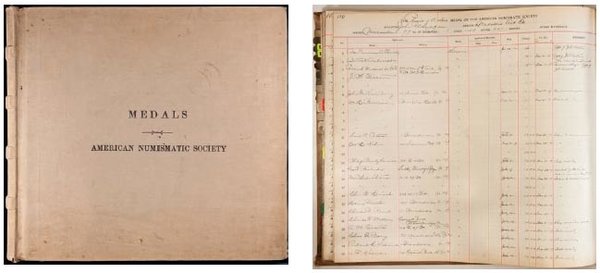
The ledger book in which most of the Society's sales of medals were recorded from 1909 to 1986 (ANS Archives).
The question of what to include as an ANS medal proved more difficult than I ever imagined. Despite several attempts at catalogues and lists in the past, none were complete or wholly accurate. In the case of multiple varieties of a medal, deciding which would warrant a separate listing and which would be relegated to a brief footnote resulted in a number of discussions with David Yoon, and helped bring about some consistency in the listings. In general, any medal that could be documented as having been issued by or with the consent of the Society was deemed to be an ANS medal. This included medals with a very limited connection, such as the New Theatre medal, which appears to have been commissioned and designed without the Society's involvement and only later given to the Society to issue, or the Catskill Aqueduct medal, for which the Society's own internal documentation disagrees on whether it was issued under the Society's auspices. With regard to varieties, any authorized version that had a clearly distinguishable difference in design or inscription received a separate listing, while minor differences, such as in type of finish or mint would only receive mention within a general listing.
Today, the Society's future role in the issuance of medals is uncertain. Rising costs, personal involvements of curators and Trustees, and popular demand all have an influence on the medals program. However, if the last 150 years are any indication, we can expect periods of inaction overshadowed by some truly outstanding medals.
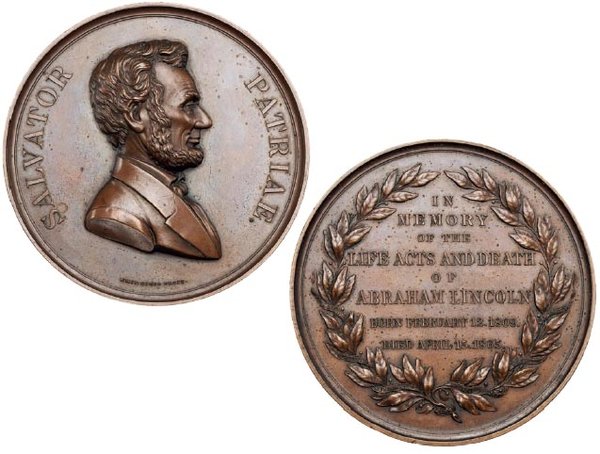
Lincoln memorial medal, bronze strike from the original dies (ANS 0000.999.20456).
Obv.: Bust of Abraham Lincoln, right; no button holes on lapel. Around, SALVATOR PATRIAE.; signed below the bust, EMIL SIGEL FECIT.
Rev.: Eight-line inscription within a wreath: IN / MEMORY / OF THE / LIFE ACTS AND DEATH / OF / ABRAHAM LINCOLN / BORN FEBRUARY 12. 1809. / DIED APRIL 15. 1865. Within the wreath is a ribbon bearing the words PUB. BY THE / AMERICAN / NUMISMATIC / AND / ARCHAEOLOGICAL / SOCIETY / NEW YORK 1866
by Emil Sigel
83 mm
Mintage
bronze: unknown
white metal: unknown
This was the first medal issued by the American Numismatic and Archaeological Society, as it was then known. Seeking an appropriate
reaction to the shocking assassination of President Abraham Lincoln, the following resolution was
passed at a special meeting of the Society on April 27, 1865:
Resolved, That since it is the duty of this
Society to perpetuate the memorials of historic greatness, we will cause to be struck in bronze a medal, designed to
commemorate the
life and perpetuate the name of Abraham Lincoln; and that a Committee be appointed to carry this
resolution into effect (AJN 1866: 5).
After consideration of the designs submitted by several die-sinkers, a contract was entered into with Emil Sigel on May 25. The earliest notices offering this medal provided scant information. One such mention in a Buffalo newspaper, the Commercial Advertiser of May 29, 1865, merely noted that the Society proposed "to strike a medal in honor of the memory of President Lincoln, which they intend shall surpass anything of the kind before done in the United States" and that the subscription price would be $5.00 (clipping in R. H. Lawrence scrapbook 2, ANS Archives). This notice dates from about the time of the first circular seeking subscriptions, which describes the medal as being bronze and three inches in diameter, with a bust of Lincoln on the obverse and an appropriate inscription on the reverse (untitled circular announcing Lincoln Memorial medal, R. H. Lawrence scrapbook 1, ANS Archives).
By July 1865, the design had sufficiently progressed that a second circular was printed bearing a woodcut of the medal in bronze ink ("American Numismatic and Archæological Society," New-York Times, July 14, 1865). On February 11, 1866, bronze medals struck from unfinished dies were presented to President Andrew Johnson and orator George Bancroft. Meant to have been given as part of a celebration in honor of Lincoln's birthday, the decision to do so was made too late to have been included in the program (Adelson 1958: 47). Finally, on March 30, 1866, the committee reported that after a number of difficulties, the first finished medals were finally struck (minutes, special meeting, March 30, 1866, ANS Archives).
Despite the oft-repeated tale of the dies breaking after only sixteen strikes, the facts are somewhat different. Emil Sigel did notify the Society that the dies had broken after the sixteenth strike (AJN 1866: 5). After reporting that the dies were unusable, Sigel convinced the Lincoln Medal Committee of the need to finance a new set. He did make these new dies, but they were not used to strike any medals until 1915. An examination of the dies in the Society's cabinet shows some breakage on the shoulder of the first obverse die, but not so severe that additional strikes could not be made. In 1868 Sigel made additional strikes using the first set of dies, with numbers delivered reported in the American Journal of Numismatics (AJN 1868a, 1868b, 1868c; Weeks 1892: 24). The reports are a little confusing because it is unclear if the numbers are to be taken individually or cumulatively. 1
According to a note in S. H. and H. Chapman's 1894 sale of the Isaac F. Wood collection of American medals, the idea for this medal originated with Wood, and F. H. Norton proposed it to the Society. Evidently based on Wood's recollections, this statement was partly in error, as the motion proposing this medal was presented to the Society by Frank Leathe. This sale, which included two examples in tin, also indicated that the dies broke on the sixteenth impression (Chapman and Chapman 1894).
The bronze medals were originally offered for sale at $5. Later on, when the condition of the dies became an issue, tin strikes were offered at two for $5 or one in an elegant case for the same price, though additional bronze medals were also later offered (Weeks 1892: 22). Actual mintage figures are unknown. Weeks believed about 60 bronze and 30 white-metal examples were struck (Weeks 1892: 8), while Belden put the total number struck at slightly over 100 (Belden 1915: 19). The actual mintage is probably between 100 and 125, with the bronze examples somewhat more common than those in white metal.
The issuance of this medal proved to be something of a disaster for the Society, both financially and administratively. Unforeseen costs, largely due to the unnecessary second set of dies as well as striking delays, contributed to this situation. In an attempt to recover the excess funds paid, a new contract was made between the Society and Sigel dated February 17, 1868, in which the Society could have the original dies for half the original price. The contract noted that although the new set of dies was made for $600, no medals were struck from that set. Sigel was obliged to pay the Society $720, less $1 for each tin medal and $5 for each bronze medal delivered. Further, the Society would have a lien against the dies until the sum was paid in full. It was not until 1875 that the books on this medal were closed. Even then, certain aspects related to this medal continued to surface; during a meeting in 1876 the Executive Committee voted to sell the remaining tin medal with case for $7.50 (minutes, Executive Committee, October 27, 1876, ANS Archives). In 1881 the Society paid $75 to Sigel for his interest in the dies for the Lincoln Memorial Medal (Betts 1881: 6, 8).

Original obverse die of the Lincoln memorial medal, showing damage on shoulder (ANS 0000.999.53130: height, 97 mm; diameter, 126 mm).
The medals struck for Johnson and Bancroft from the unfinished dies remain an unresolved question. There appears to be no description to help identify these medals. However, there is a reliable report of a bronze medal having been struck using an obverse die depicting two button holes on the lapel of Lincoln's coat along with the first reverse die (David T. Alexander, personal communication). At first this seemed to be a mule of the second obverse die with the first reverse. However, close examination of a photograph revealed the buttonholes to be spaced differently; both are a bit higher than on the second obverse die (David T. Alexander, personal communication). Since this does not match the second obverse, it seems possible that it was struck using the unfinished first die, and that the two buttonholes were removed prior to striking medals for sale. Further, based on the reported location of this specimen in the possession of a descendant of Sigel's colleague Rudolph Laubenheimer, it seems plausible that it was struck by Sigel for his own use and presented to an acquaintance.
Silver, bronze, and white-metal reductions of 7, 16, and 35 millimeters are sometimes seen. These were produced by the London firm of J. S. and A. B. Wyon using their new reducing machine. Although only six reductions were initially authorized, the number actually struck was greater. The Society eventually authorized the purchase of twenty-five sets of reductions for its members. Two sets appear to have been acquired for the Society's cabinet on December 12, 1866, at a cost of $12 (accession register, 1858–1904, entry 1866.022, ANS Archives). Unlike the 16- and 35-millimeter versions, the smallest ones are uniface. Two varieties exist for the 7-millimeter reductions. Of the three examples in the Society's cabinet, one silver example was struck without a reverse die (ANS 0000.999.3564), while one bronze (ANS 0000.999.3566) and one silver (ANS 0000.999.3565) were struck with a blank reverse die, exhibiting only a raised rim.
The Edward Cogan sale of June 9–11, 1873, included a single lot (lot 554) consisting of six Wyon reductions. Three were size 22 (35 millimeters) in silver, bronze, and white metal; the other three were described as size 8 (about 12 millimeters) in "the same metal" (Cogan 1873). The set of six was sold for the impressive sum of $25.00, with the named and priced copy in the ANS Library giving the purchaser as "Cogan".
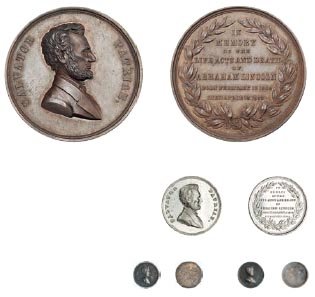
Wyon reductions of the Lincoln memorial medal: (top) 35 mm reduction in bronze (private collection); (middle) 16 mm reduction in white metal (ANS 0000.999.5979); (bottom) 7 mm reduction in silver without reverse die (ANS 0000.999.3564) and with blank reverse die (ANS 0000.999.3565).

Observed examples of the silver 16 mm Wyon reduction have an engrailed rim, whereas the bronze and white-metal 16 mm reductions have a plain rim, as seen in these detail views (silver, ANS 0000.999.4229; bronze, ANS 1940.100.449; enlarged 3×).

Lincoln memorial medal struck in lead from the previously unused second set of dies (ANS 1915.82.1).
Obv.: Bust of Abraham Lincoln, r.; two buttonholes on lapel. Around, SALVATOR PATRIAE.; signed below the bust, EMIL SIGEL FECIT
Rev.: Eight-line inscription within a wreath: IN / MEMORY / OF THE / LIFE AND DEATH / OF / ABRAHAM LINCOLN / BORN FEBRUARY 12. 1809. / DIED APRIL 15. 1865. Within the wreath is a ribbon bearing the words PUB. BY THE / AMERICAN / NUMISMATIC / AND / ARCHAEOLOGICAL / SOCIETY / NEW YORK 1867
by Emil Sigel
83 mm
Mintage
lead: 1 medal, 1 set uniface impressions
As described for no. 1 above (see p. 7), the complicated story of the Lincoln Memorial Medal involved preparation of a second set of dies. The most frequently heard explanation for the existence of two sets of dies is that the first dies broke after only sixteen strikes. Emil Sigel told the Society that the dies had broken and new dies would be necessary. However, although the shoulder of the obverse die was damaged, it was still useable. After producing a second set of dies, Sigel struck additional medals from the first set. In 1915 lead impressions were made from the second pair of dies for the Society's cabinet (accession register, 1911–1921, entry 1915.82, ANS Archives). With the exception of these lead strikes, it appears that all medals were struck using the first dies. Curiously, there is a third obverse die in the Society's cabinet, distinguishable by the fact that the inscription has been effaced.
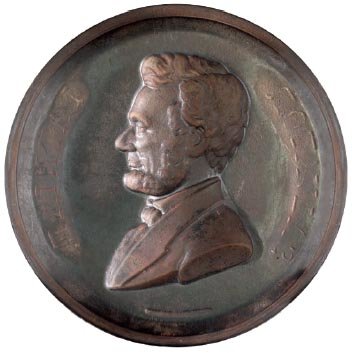
A third obverse die for the Lincoln memorial medal, unfinished and with the inscription removed. This die is not mentioned in the documents relating to the medal (ANS 0000.999.53132).
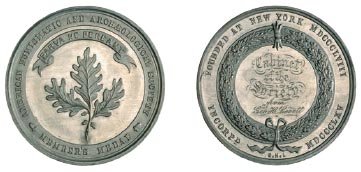
White metal example of the original design of the 1876 membership medal, showing the reverse die that the Membership Medal Committee rejected (ANS 0000.999.3350).
Obv.: A sprig of three oak leaves beneath a ribbon bearing the legend PARVA NE PEREANT; around, AMERICAN NUMISMATIC AND ARCHÆOLOGICAL SOCIETY / (acorn) MEMBER'S MEDAL (acorn)
Rev.: A wreath of oak leaves on a raised band enclosing a blank field for engraving the member's name and date of membership. Around, FOUNDED AT NEW YORK MDCCCLVIII / INCORPD MDCCCLXV; signed G.H.L below the wreath's ribbon tie.
by George H. Lovett
42 mm
Mintage
white metal: 12
The idea for a membership medal can be traced to a suggestion made by Isaac Wood in November 1875 (minutes, Executive Committee, November 15, 1876, ANS Archives). Two months later Wood reported that he had met with George Lovett about the medal, to be size 27, the same size as the Society's seal. Lovett indicated the dies would cost not more than $75.00, and that he would become a life member out of that sum. Medals in gold would cost $50.00, silver $5.00, and bronze $1.50. (minutes, Executive Committee, January 16, 1876, ANS Archives).
According to Belden, this first reverse die was rejected (Belden 1915: 21). A new die was then prepared, similar to the first but lacking the raised band upon which the oak wreath rests. In addition to requesting the removal of the raised band, it appears the Medal Committee also wanted the oak wreath to be a little heavier than on this first die (minutes, Executive Committee, March 23, 1876, ANS Archives). Two examples are contained in the Society's cabinet. The first bears the inscription Cabinet of / Am. Num. & Arch. Soc. / from / Isaac F. Wood. / Rejected die, 12 struck. (ANS 0000.999.3349). On the second specimen is engraved Cabinet / of the / Society, / from / Geo. H. Lovett (ANS 0000.999.3350).
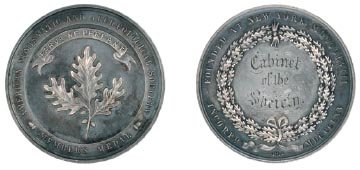
ANS 1876 Membership medal in silver, inscribed as the original example for the Society's collection (ANS 0000.999.3343).
Obv.: A sprig of three oak leaves beneath a ribbon bearing the legend PARVA NE PEREANT; around, AMERICAN NUMISMATIC AND ARCHÆOLOGICAL SOCIETY / (acorn) MEMBER'S MEDAL (acorn)
Rev.: A wreath of oak leaves enclosing a blank field for engraving the member's name and date of membership. Around, FOUNDED AT NEW YORK MDCCCLVIII / INCORPD MDCCCLXV; signed G.H.L below the wreath's ribbon tie.
by George H. Lovett
42 mm
Mintage
gold: unknown
silver: unknown
bronze: unknown
After Lovett's first reverse die was rejected (see p. 12); he made a second die, removing the raised band upon which the oak wreath sat and making the wreath heavier. This modified design was accepted at a meeting on March 23, 1876. Prices were to be $50.00 for gold, $5.00 for silver, and $1.50 for bronze, as quoted earlier, for those who had subscribed to the cost of the dies. A slightly higher price was to be charged to nonsubscribers, and the Secretary was requested to notify all members that they still had the opportunity to subscribe to the cost of the dies (minutes, Executive Committee, March 23, 1876, ANS Archives). Silver impressions of the medal were exhibited by Isaac Wood at a meeting of the Executive Committee on December 22, 1876. The Committee reported they thought the price for the silver medals was too high. Wood then offered to see Lovett about it (minutes, Executive Committee, December 22, 1876, ANS Archives). By January 12 of the following year, the Membership Medal Committee felt the medal was now satisfactory (minutes, Executive Committee, January 12, 1877, ANS Archives). Shortly thereafter, Lovett sent a certificate to the Society certifying that the first reverse die had been destroyed (minutes, Executive Committee, March 8, 1877).
In a notice dated January 1877, members were notified that the dies for the Medal of Membership were ready and were to be considered "a special Certificate of membership peculiarly appropriate to a Numismatic Society". They were to be available only to current members in good standing, or to former members who had left the Society in good standing. Priced at $5 in silver and $3 in bronze, each medal was to be engraved with the name, date of election, and class of membership of the member. Each member was allowed to buy only one medal in each metal, though additional medals could be purchased upon changing the type of membership held. Gold medals were also available, with the price to be furnished upon application (unititled circular to members announcing availability of Medal of Membership, January 1877, ANS Archives).
An engraving illustrating the medal was published in the July 1879 issue of the American Journal of Numismatics accompanied by a brief descriptive article (AJN 1879). At the regular meeting held January 20, 1880, Isaac F. Wood, chairman of the Membership Medal Committee, reported that a total of forty-four membership medals had been distributed. The committee was then discharged; the dies and related material were entrusted to the treasurer (Poillon 1880).
The first membership medal was available to members from 1876 until the Society changed its name in 1907. The class of membership is often found engraved with the member's name on the reverse. According to Article IV of the 1878 printing of the Society's constitution and by-laws, there were four classes of membership: Resident, Corresponding, Life, and Honorary. Any person residing in the United States was eligible for resident membership. Corresponding members were elected for a two-year term, after which they could be elected as permanent corresponding members; earlier, they appear only to have been elected permanently. Corresponding members were not required to pay initiation fees or dues, but they were "expected to correspond with the Secretary at intervals, not exceeding six months, on topics relating to the objects for which this Society is established" (Constitution and By-Laws 1878). Life membership was available to members in any class of membership upon payment of $30. Honorary membership was limited to a maximum of fifty individuals, serving to recognize special services to the Society or to its subject. The Director of the United States Mint was to be, at all times, an honorary member ex officio.
Throughout its history, the ANS has occasionally used its current membership medal as an award. In early 1877 the Society received a letter from a Mr. John Davidson of London, who wrote that he had recently purchased a copy of de Saulcy's Souvenirs numismatiques de la révolution de 1848 that had "The Numismatic Society / New York" stamped on the cover. Davidson wanted to know whether or not the book belonged to the Society, and indicated that if it did, he would return it (letter, John Davidson to Numismatic Society of New York, January 22, 1877, ANS Archives). The Secretary was directed to notify Davidson that the book did belong to the Society (minutes, Executive Committee, February 8, 1877, ANS Archives). By May, the book had been returned to the Society. During an Executive Committee meeting that month, William Poillon moved that John Davidson be made a corresponding member of the Society. Benjamin Betts added that as a token of their esteem, Davidson should be sent a bronze medal as a corresponding member; the motions were carried (minutes, Executive Committee, May 30, 1877, ANS Archives). Davidson's medal was offered for sale as lot 189 in Presidential Coin and Antique Company's Auction 83 on June 22, 2013.
In 1878 the Society's members had a gold membership medal struck for the Society's president, Charles E.
Anthon. The medal was presented to Anthon at the twentieth annual meeting on March 19, 1878, by Benjamin Betts, who
remarked:
The members of this Society having for a long time been aware of the many obligations they are under to their worthy
President, whose efforts for their instruction and entertainment have been so untiring and continuous, and whose labors
in their
behalf so freely and ungrudgingly given, and being now desirous of manifesting in some suitable manner their
appreciation of his services, have determined to present him with a slight testimonial of their regard. In accordance
with this
determination, they have had prepared from the Society's dies a Membership Medal in Gold, suitably inscribed, to be
presented to you
in the name and in behalf of the Society as a token of their affection and esteem (Proceedings 1878: 7).
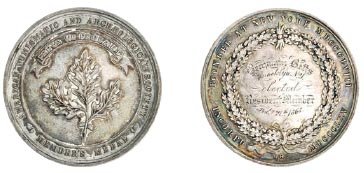
The 1876 membership medal in silver, inscribed to Benjamin Betts, who was president of the Society from 1870 to 1873 (ANS 0000.999.3345).
President Anthon responded:
Mr. Betts and gentlemen of the Society: It is with
feelings of pleasure and thankfulness that I receive this magnificent token of your esteem, and, I may perhaps venture
to say, your
affection. So entirely unexpected is your gift, that I am not prepared with any remarks appropriate to the occasion.
Let me,
however, be permitted to say, that in the course of many years nothing has occurred to me of a more gratifying nature.
The character
of your testimonial is entirely in accordance with my taste. I could not have selected or suggested anything so desirable
as this
beautiful and thus far unique memorial of the foundation and incorporation of our Society. At the same time, and without
any
affectation of modesty, I am constrained to say that I regard this Medal not as an acknowledgment for services rendered,
but rather
as an encouragement to greater industry and zeal in furthering henceforward the interests of the elegant and instructive
study to
which our Society is devoted. May we all continue to profit by it, and to cherish the kindly feelings of which your
valuable memento
gives such acceptable evidence (Proceedings 1878: 7).
Gold membership medals were also occasionally presented to important honorary members, such as the king of Italy. In 1901, several members contributed the cost of a gold medal to be presented in the name of the Society to King Victor Emmanuel III after he accepted an honorary membership (minutes, Executive Committee, April 25, 1901, ANS Archives).
The membership medal was struck over a number of years, as examples were needed. While most silver examples in the Society's cabinet have a thickness of 3 millimeters, two examples measure 4 and 5 millimeters. As these were purchased by members who joined in the 1890s, it would appear that the medals struck on thicker planchets represent later strikes.
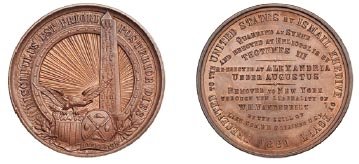
Cleopatra's Needle medal in bronze (ANS 1997.39.1).
Obv.: Egyptian obelisk, sunburst behind; below, arms of the United States, surmounted by an eagle, and arms of New York City to right. Around, DISCIPULUS EST PRIORI POSTERIOR DIES; at bottom, signed C. O. INV
Rev.: Around, PRESENTED TO THE UNITED STATES BY ISMAIL KHEDIVE OF EGYPT / 1881; in center, ten-line inscription: QUARRIED AT SYENE / AND ERECTED AT HELIOPOLIS BY / THOTHMES III / RE-ERECTED AT ALEXANDRIA / UNDER AUGUSTUS / REMOVED TO NEW YORK / THROUGH THE LIBERALITY OF / W. H. VANDERBILT / BY THE SKILL OF / LIEU. COM. H. H. GORRINGE U.S.N
designed by Charles Osborne and Gaston Feuardent
42 mm
Mintage
gold: possibly unique
silver: at least 2
bronze: unknown
white metal: unknown
It is unclear why this medal was omitted from Belden's catalogue (Belden 1915). Despite claims to the contrary by a number of recent writers and researchers, the records of the Society clearly include mention of this medal. Some of its history was recounted by Adelson, who noted that when the obelisk was brought to this country in 1880, "some prominent New York residents undertook to strike a medal commemorating the event" (Adelson 1958: 83). The designs were displayed before the Society on the evening of December 21, 1880, and approval of the design was given. A contemporary newspaper account stated that the medals were prepared with the approval and assistance of the acting president of the Board of Education, Stephen Walker, and under the supervision of Robert Hewitt, Jr., of the American Numismatic and Archaeological Society ("The Obelisk," Brooklyn Eagle, February 22, 1881). The reverse of the medal specifically honors William H. Vanderbilt, the principal financial contributor for the shipment of the obelisk from Egypt to New York, and Lt. Com. Henry H. Gorringe, the naval officer who had carried out this challenging task (Hoover 2012: 15).
The official reception for Cleopatra's Needle took place on February 22, 1881, in the Great Hall of the Metropolitan Museum of Art. Among the committee responsible for the ceremony were two prominent members of the Society, Robert Hewitt, Jr., and Algernon S. Sullivan. As part of the ceremony, Secretary of State William M. Evarts presented the obelisk from the Khedive of Egypt to the City of New York, with Mayor William R. Grace accepting.
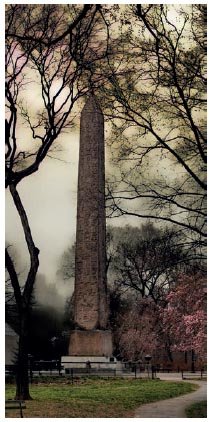
The obelisk of Thutmose III, commonly known as "Cleopatra's Needle", in New York's Central Park (photograph by Alan Roche).

Card holder for the Cleopatra's Needle medal in white medal; the holder is inscribed to one of the 100 honor students (ANS 1977.51.1; 85 × 103 mm).
On behalf of the American Numismatic and Archaeological Society, Sullivan then presented silver medals to Vanderbilt and Gorringe:
An appreciative token of the liberal financial donor,
Mr. William H. Vanderbilt, and of the skilful and indefatigable engineer, Lieutenant-Commander H. H. Gorringe, U.S.N.,
to whose mediary agency we owe this souvenir of
Egyptian methods, has been stamped upon medals to commemorate this event medalically, artistically, and historically.
The first
impressions from the die in silver, in the name of the distinguished society already named, and in view of this assembly,
I now
deliver to Mr. Vanderbilt and to Lieutenant-Commander Gorringe, whose great
services to the cause of art and historic enlightenment are hereby recognized by all the educational circles of New
York and America (quoted in Gorringe 1882: 54).
Sullivan then removed from its paper wrapping a "long flat box of handsome workmanship" and presented a silver medal, enclosed in its gold velvet case, to Gorringe. He then presented a similar box, also containing a silver medal, to a gentleman who accepted it on behalf of Vanderbilt, whose absence from the ceremony was deeply regretted. (Gorringe 1882: 54; "The Obelisk Received," New York Times, February 23, 1881).
The ceremonies concluded with the awarding of medals by Algernon Sullivan to 100 honor students from the city's public schools (d'Alton 1993: 63; "The Obelisk," Brooklyn Eagle, February 22, 1881). Struck in white metal, these medals were housed in a card booklet bearing on the front cover a central design with Egyptian hieroglyphics and the inscription HELIOPOLIS, XVI CENTURY B.C. / ALEXANDRIA. B.C. 22. / CENTRAL PARK. JAN. 22 1881 A.D. / PRESENTATION CEREMONIES, / FEBRUARY 22, 1881. / NEW YORK. The rear cover displayed the Society's seal and a presentation inscription from the American Numismatic and Archaeological Society by Robert Hewitt, Jr. The inside covers explained the use of the quotation from the poet Publilius (misspelled "Publius" in the booklet) Syrus, "discipulus est priori posterior dies", translated as "let the future profit from the lessons of the past". Due to the large crowd present, the school children were unable to receive their medals individually. A single teacher was appointed to receive the medals from Sullivan and later distribute them among the students.
Less than two weeks after the dedication of the obelisk, Gorringe was presented with a second example of this medal. Although there are no contemporary accounts concerning this medal, based on the symbols on the box, it was probably given by a Masonic lodge. Struck in pure gold and weighing 990 grains, the cover of the elaborate box in which it was contained bore a Masonic emblem and the date MARCH 4TH 1881. within a circle, and the inscription PRESENTED TO / HENRY H. GORRINGE, / LIEUT.-COM'DR U.S.N. Stamped on the inner cover of the box is a rising sun emerging from clouds and the inscription HELIOPOLIS, XVI CENTURY B.C. / ALEXANDRIA B.C. 22 / NEW YORK, JAN. 22, 1881 A.D. The medal itself was housed within an insert with fringes at top and bottom and metal rollers to the left and right, to give the appearance of a scroll. When its existence was first reported in Coin World in 1972, this medal was owned by a Georgia collector, who had purchased it from the Gorringe family (letter, Jay Guren to Chief Archivist, Masonic Hall, July 5, 1972; Guren 1972: 30). This medal, no longer accompanied by its presentation case, was later offered for sale in the January 2012 Stack's Bowers Americana Sale and is now part of the Society's cabinet (ANS 2012.9.1).

(Left) The gold medal presented to Henry H. Gorringe two weeks after the official ceremony (ANS 2012.9.1).

(Below) The presentation case in which Gorringe's gold medal was formerly housed (photograph courtesy of Coin World and the Chancellor Robert R. Livingston Masonic Library of the Grand Lodge).
With regard to the white-metal specimens, it would appear that the total mintage was somewhat greater than the 100 presented to school children. Several examples have been seen with presentations to institutions and individuals not included among the lucky students, including one example which bears a presentation inscription as late as 1906. As for the bronze medals, although mintage figures are not known, their infrequent appearance for sale would suggest a very small number struck.
At the Society's annual meeting on March 28, 1882,
Mr. Wright moved a special vote of thanks to Mr. Hewitt for the appropriate gift of a frame containing medals showing the
obverse and reverse of the
medals struck to commemorate the erection of the Egyptian obelisk in Central Park; also the original
impressions in wax taken from the dies before the medals were struck, together with a photograph with autograph of
Lieut.-Com. H. H. Gorringe, U. S. N." (Proceedings 1882: 8).
According to Adelson (1958: 84), "Robert Hewitt, Jr., began collecting memorabilia relating to the obelisk; and one year later, after he had framed the medals, photographs, and other objects in his collection, he donated them in his own name and in the name of the Society, to the New-York Historical Society and the American Geographical Society." It is not known whether or not these two references concern the same frame, whose location is currently unknown. The dies for this medal are currently in the cabinet of the American Numismatic Society, having been donated by Hewitt in 1911 (accession 1911.22).

George Washington (Evacuation Day) medal in bronze (ANS 0000.999.3354).
Obv.: Full-length statue of Washington surrounded by rays of light and a circle of thirteen stars; on either side are the dates 1783– and 1883. The medal is signed below the pedestal, C. OSBORNE INV. LEA AHLBORN FEC.
Rev.: The seal of the New York State Chamber of Commerce flanked by those of the City of New York and the American Numismatic and Archaeological Society; above and below is a twelve-line inscription surrounded by 38 stars: TO COMMEMORATE / THE / CENTENNIAL ANNIVERSARY / OF THE EVACUATION OF NEW YORK / BY THE BRITISH, / AND THE ERECTION / BY THE/ CHAMBER OF COMMERCE / OF THE STATE OF NEW YORK OF THE / WASHINGTON STATUE / IN / WALL STREET
designed by Charles Osborne; engraved by Lea Ahlborn
57 mm
Mintage
silver: 1
bronze: 332
According to a letter from Tage Brandt of the Royal Swedish Mint (Brandt to Georgia S. Chamberlain, March 24, 1953, enclosed with Chamberlain to George C. Miles, April 16, 1953, ANS Archives), the medals were struck at the Swedish Mint as follows:
| November 22, 1884 | 254 bronze |
| December 30, 1884 | 1 silver |
| April 2, 1885 | 50 bronze |
| October 23, 1885 | 27 bronze |
| unspecified date 1885 | 1 bronze |
In addition to the abovementioned medals, there exists in the cabinet of a prominent New Jersey collector a specimen in white metal, the planchet being slightly thicker than those of the silver or bronze examples.
Evacuation Day was a local holiday celebrated annually in New York, marking the anniversary of the departure of British troops from New York on November 25, 1783. Although the Treaty of Paris signed on September 3 of that year marked the official end of the American Revolution, the removal of British troops from New York marked the final end of their military presence in the newly independent nation. The British departure at noon on November 25 was followed by a parade of American forces down Manhattan, led by General Washington and Governor Clinton, to Fort George, where the British flag was lowered and replaced by the American. This was followed by ten days of celebration, ending with Washington's farewell address at Fraunces Tavern.
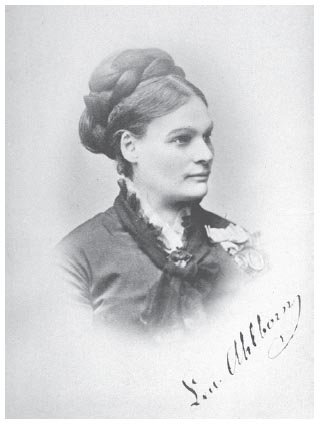
Lea Ahlborn, a Swedish printmaker and sculptor, en-graved the dies for three of the Society's early medals (ANS Archives).
The centennial celebration in 1883 was considered one of the great civic events of the century. Evacuation Day ceased to be observed after World War I (Jackson 1995: 384).
The medal was struck at the request of the Common Council of the City of New York and the Chamber of Commerce of the State of New York. It commemorated both the November 26, 1883, celebration of the centennial of the evacuation of New York by the British and the Chamber's erection of a statue of Washington by John Quincy Adams Ward on the steps of the Sub-Treasury Building in Wall Street (Belden 1915: 23; Jackson 1995: 393). It was on this site in 1789, at what was then New York's City Hall, that George Washington took the oath of office as the first president of the United States (Jackson 1995: 393; see also the New York City Bicentennial medal, no. 52, p. 137).

Presentation letter for the Evacuation Day medal signed by the secretary of the Chamber of Commerce of the State of New York (author's collection).
Although plans for a medal were in effect prior to the celebration, it appears the Society was not involved until a later date. On November 20, 1883, a letter from Lieutenant William B. Brokow was read before the Society's Executive Committee, asking for information about a medal he heard the Society would issue in celebration of Evacuation Day. The Secretary was directed to respond that the Society would not issue such a medal "as the time was too short" (minutes, Executive Committee, November 20, 1883, ANS Archives). Shortly after Evacuation Day, however, some of the remaining celebration money was given to representatives of the Society in order to produce a medal in commemoration of the event. Although the designs for the medal were prepared in New York, the dies and medals were produced at the Royal Mint in Stockholm. The first medals were presented at the Chamber of Commerce rooms on February 21, 1885 ("The Evacuation Day Medals," New York Times, February 20, 1885). Lea Ahlborn was elected an honorary member of the Society on January 20, 1885.

The brown book-style case in which the Evacuation Day medal was issued (private collection; 109 × 128 mm).
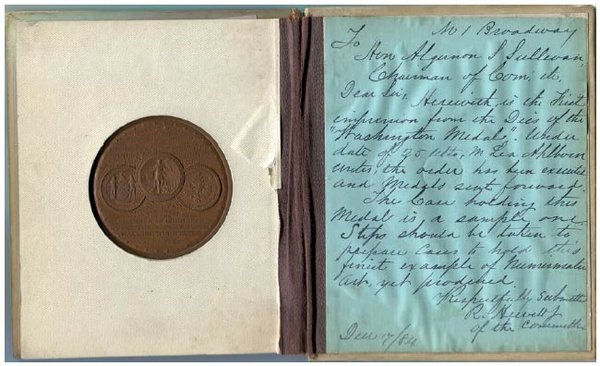
The beige prototype case, with a pasted-in note from Robert Hewitt to Algernon Sydney Sullivan describing the case as a sample and the medal it contains as the first impression from the dies (ANS 0000.999.20953).
The cases in which the medals were issued consist of a brown cloth book with gilt letters. The back cover exists both with and without the letters CCNY in gilt. A prototype in the cabinet of the ANS, containing the first medal struck, is in a light cloth without lettering. In addition, at least two full leather cases have been seen.
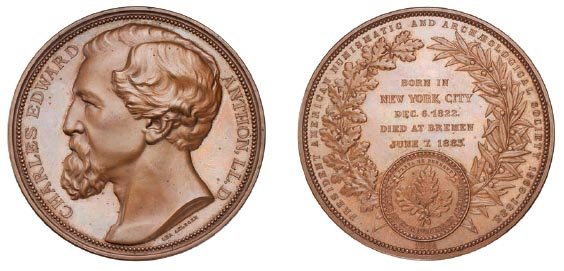
Charles Edward Anthon medal in bronze (ANS 0000.999.3361).
Obv.: Bust of Anthon, left; around, CHARLES EDWARD ANTHON, LL.D.; signed below bust, LEA AHLBORN
Rev.: Five-line inscription within a wreath composed of oak (left) and laurel (right), the junction covered by the seal of the Society, below which is the date 1884: BORN IN / NEW YORK CITY / DEC. 6. 1822. / DIED AT BREMEN /JUNE 7. 1883. Around, PRESIDENT AMERICAN NUMISMATIC AND ARCHAEOLOGICAL SOCIETY 1869–1883
by Lea Ahlborn
68 mm
Mintage
silver: 15
bronze: 85
This medal was struck in memory of Charles Edward Anthon, who was first elected president of the Society to fill the unexpired term of Frank H. Norton after he resigned from office on April 25, 1867. Anthon resigned on May 9, preferring to retain the office of Corresponding Secretary. He was again elected and served as president from March 26, 1868, until March 24, 1870, and from March 27, 1873, until his death on June 7, 1883 (Belden 1915: 9). Anthon was the nephew of Professor Charles Anthon of Columbia University ("Charles Edward Anthon" [obituary], New-York Times, June 9, 1883), who is best remembered for his involvement in the controversy over the translation of Joseph Smith's golden tablets.
The first notice to the membership concerning the Anthon medal was in a letter from Secretary William Poillon dated December 29, 1883, in which he wrote that a suggestion had been made to strike a medal in memory of Charles E. Anthon, "for many years the active president of our Society, and identified during a large part of his life with the progress of numismatics in this country". In an effort to ascertain whether or not there was sufficient interest in such a medal, subscriptions were requested for a bronze medal of about 40 American measurement (2½ inches), to be designed by Lea Ahlborn of the Swedish Mint; the price was set at $5 (circular, William Poillon for Executive Committee, December 29, 1883, ANS Archives).

(Above) Charles E. Anthon, c. 1867. Due to a production error, this photograph was misidentified as Charles H. Wright in Adelson's 1958 book (ANS Archives).
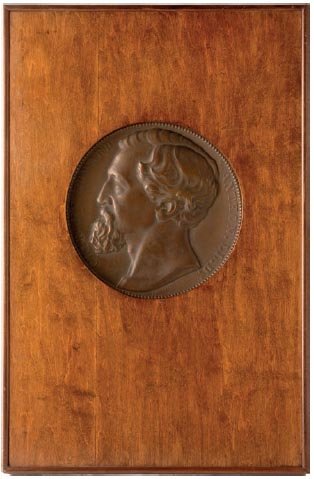
(Right) Plaque based on obverse of Charles E. Anthon medal. Note the different placement of the lettering (ANS 0000.999.55037; diam. 8½" in wooden frame).
In a follow-up circular the next October, Lyman H. Low, Secretary of the Anthon Memorial Committee, announced that the dies for the Anthon medal were ready. The Committee decided to issue the medal in silver also, at a price of $10, and orders were requested without delay (circular, Anthon Memorial Committee, October 1884, ANS Archives).
According to the report submitted by the Anthon Memorial Committee at the annual meeting in 1885, twelve silver and sixty-six bronze medals had been received, and most were already subscribed. Upon a motion by Prof. Solomon Woolf, it was decided that "when 85 bronze and 15 silver impressions shall have been struck, the Anthon medal dies be destroyed and deposited in the cabinets of the Society; also that the balance be ordered at once" (Anthon Memorial Committee 1885: 9). Thirty years later, both silver and bronze medals were still available at the original price (Belden 1915: 25).

Plaque depicting Charles E. Anthon by Solomon Woolf (ANS 0000.999.70718, diam. 8½″).
In the March 1885 issue of Numisma, the oftenacerbic Édouard Frossard wrote that "it is in fact a superb medallic monument, but alas, the head is not that of Anthon. The forehead lacks breadth, the nose is too aquiline, it gives the profile the martial appearance of one of the Danish kings, as seen on crown pieces. The expression of the eye and cheek is better, but still not strikingly resembling. It is a fine and expressive portrait, but not a good likeness" (Frossard 1885). Frossard's comments were discussed at a meeting of the Executive Committee on April 15, 1885. Although a response was prepared and read, no action was taken, in the hope that the controversy would soon die (minutes, Executive Committee, April 15, 1885, ANS Archives).
In addition to the medal, the Society has an 8½-inch plaque based on the obverse of this medal with some minor differences, as well as another 8½-inch plaque of Anthon, credited to Solomon Woolf.
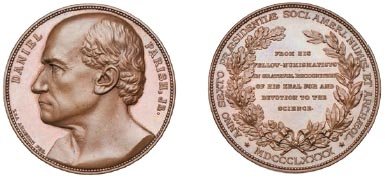
Daniel Parish medal in bronze (ANS 1940.100.448).
Obv.: Bust of Parish, left; around, DANIEL PARISH, JR.; signed to left of bust, LEA AHLBORN FEC.
Rev.: Six-line inscription within wreath of oak (left) and laurel (right): FROM HIS / FELLOW-NUMISMATISTS / IN GRATEFUL RECOGNITION / OF HIS ZEAL FOR AND / DEVOTION TO THE / SCIENCE. Surrounding the wreath, ANNO SEXTO PRÆSIDENTIÆ SOCI. AMERI. NUMIS. ET ARCHÆOL. / ★ MDCCCLXXXX ★
by Lea Ahlborn
46 mm
Mintage
gold: 1
silver: 1
bronze: unknown
Daniel Parish, Jr., joined the ANS on April 13, 1865, and held a variety of offices, including Corresponding Secretary, Librarian, and both First and Second Vice-President. In 1883 Parish succeeded Charles Anthon as President of the Society and held that office until March 16, 1896. In 1908 he was made Honorary President for Life, and he was later one of the five Governors of the Society. At the time of his death in 1914, Parish was the last survivor of the officers who served at the time of the Society's incorporation in 1865 (Proceedings 1914–15: xviii; Adelson 1958: 348–356). Parish was also a long-time member of the New-York Historical Society and was Chairman of its Executive Committee at the time of his death (Death notices, New York Times, December 19, 1914).
This medal was struck to commemorate President Parish's generous gifts to the Society's library, cabinet, and funds. In 1908 Parish became the third person to be named a Benefactor to the Society, receiving this distinction after Archer Huntington and Arabella (Mrs. Henry E.) Huntington. Among the most noteworthy of Parish's donations was his 1908 donation of 3,541 modern European coins and medals, valued at the time at $50,000 (Adelson 1958: 190, 376). The gold medal presented to Parish is now in the Society's cabinet; the solitary silver specimen was struck for James B. Wilson, a prominent member of the Society.
According to a letter from Charles Gregory to Charles H. Wright dated January 29, 1892, Lea Ahlborn made 37 medals for subscribers to the Parish medal as follows: 1 gold, 1 silver, 35 bronze. Medals were paid for and delivered to the following subscribers:
Despite this letter detailing the initial subscribers to the Parish medal, the final mintage of 35 bronze medals is possible but not certain. Belden recounted the striking of single medals in gold and silver but refrained from providing any number for the bronze strikes, noting only that "bronze medals were distributed among the members of the Society who had subscribed for them." He also noted that as of 1915, there remained one bronze for sale at $5 (Belden 1915: 27).
In The Numismatist, Albert Frey reported the total mintage as 83: one in gold for Daniel Parish, one in silver for James B. Wilson, and 81 bronze examples for members of the Society (Frey 1905: 360). According to Frey, the gold medal was presented to Parish by Charles Gregory at a special meeting of the Society on June 12, 1890. Repeating information reported in the July 1890 issue of the American Journal of Numismatics, the medal was incorrectly described by Frey as "the first gold medal that the Society ever issued" (AJN 1890: 27). Since Bauman Belden would presumably have had access to the same material as Frey, and had been active in the Society since 1886 (while Frey only joined much later), the number of bronze medals struck must be considered as unknown until definitive evidence is located.
In addition to the unique gold and three bronze examples, the Society has a thin silver shell of the obverse (ANS 0000.999.3368) as well as a 9¼-inch plaque, differing from the medal in minor detail.
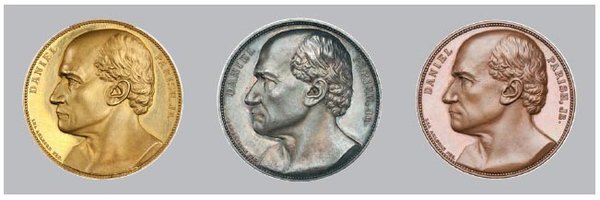
The unique gold and silver examples of the Daniel Parish medal, shown together with a bronze example (gold: ANS 0000.999.3366; silver: private collection; bronze: 1940.100.448).
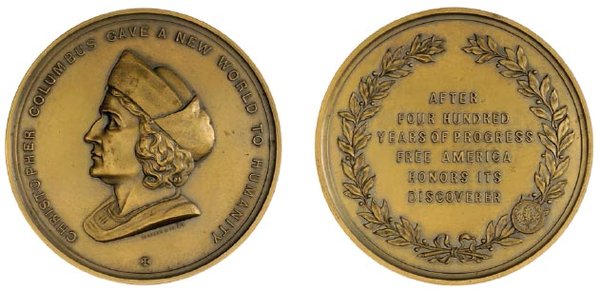
Columbus Quatercentenary medal in gold bronze (ANS 0000.999.3424).
Obv.: Bust of Columbus l. wearing a cap. Around, CHRISTOPHER COLUMBUS GAVE A NEW WORLD TO HUMANITY / ✠; signed below bust, TIFFANY & CO. N.Y.
Rev.: Six-line inscription within a wreath; superimposed on the wreath at 4:30 is the seal of the Society: AFTER / FOUR HUNDRED / YEARS OF PROGRESS / FREE AMERICA / HONORS ITS / DISCOVERER
designed by James H. Whitehouse; dies engraved by William Walker; struck by Tiffany & Co.
77 mm
Mintage
silver: unknown
bronze: unknown
gold bronze: unknown
This medal was issued to commemorate the 400th anniversary of the discovery of America in 1492. The Society adopted a resolution to issue a medal based on a proposal made by Sigmund Oettinger on January 16, 1893, which also included a desire that Tiffany & Co. design and strike the medal. A committee of three, consisting of President Daniel Parish, John M. Dodd, and Oettinger, was directed to approach Tiffany & Co. as the Society's representative (Weeks 1897: 23). Before Oettinger proposed the resolution, the Tiffany firm had been consulted; it gave assurances that it was not only willing to accept the commission, but "would willingly bear the entire expense of issuing the medal, and assume all the risk of its success, financial and artistic" (Weeks 1897: 23).
The medal was announced in the January 1894 issue of the American Journal of Numismatics, where it was said, "We believe it has long been in preparation, though the time of its appearance is 'the day after the fair'" (AJN 1894a: 53). The design of the medal was well received, though some criticism was made of the fact that while the manufacturer's name was prominently placed, that of the designer was omitted. The article further reported rumors "that the artist who made the model is a Mr. Whitehouse, and that the dies were engraved abroad." The medal was reported as having been "struck in red copper, bronze, gold bronze (which we hear was a failure), and silver…" (AJN 1894a: 54).
In the April 1894 issue of the Journal, an editorial clarified several points concerning the medal (AJN 1894b). This explained that the dies were actually engraved in New York rather than
abroad. A letter from Tiffany & Co. was printed, reading in part: The medal was designed by Mr. James H.
Whitehouse, who for more than thirty years has been prominent as one of our chief designers. The head was modelled
and
the die cut here by Mr. Wm. Walker, one of our corps of die-sinkers, and the entire work was done in one
of our shops in Union Square, under the supervision of Mr. Whitehouse. No medal has been struck in gold
bronze, but some bronze medals have been treated with gold and tellurium and have been greatly admired" (AJN
1894b: 79).
Since its issue, there has been some confusion regarding the metals in which this medal was struck. It would appear that only three versions were struck: silver, copper bronze, and gold bronze. On November 20, 1893, Tiffany & Co. sent medals in these three compositions to the Society (Weeks 1897: 23). The original plaster models were exhibited at the Society's Columbian Exhibition of Medals (AJN 1894a: 54).
In December 2003, a number of medals from the estate of a former medal designer at Tiffany, a Mr. Wheeler, came onto the market (eBay). Among the medals sold at that time was a bronze Columbus medal with the edge engraved bearing weights in copper, silver, and gold, as follows: COPPER BRONZED 170 DWTS, ST'G SILVER 191 5/10 DWTS, FINE GOLD 378 1/3 DWTS. Although no report of a gold specimen has been noted, it is apparent that such a medal was at least contemplated.
As originally envisioned by Whitehouse, the reverse was to bear an allegorical design. However, this was thought to be in too stark a contrast with the simple boldness of the obverse, and was not accepted. Instead, a simpler reverse consisting of an inscription within a wreath was substituted, the reverse design being "virtually suggested" by William Weeks (Weeks 1897: 23–24).
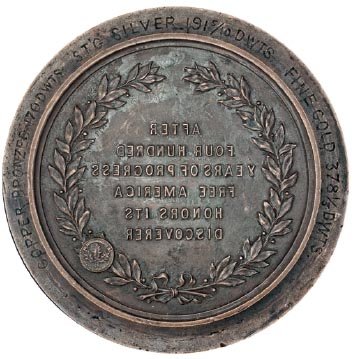
Bronze Columbus Quatercentenary medal with edge engraved to describe the weights of the medal in copper, silver, and gold (private collection). The photograph was taken with the edge reflected in a parabolic mirror; the image is reversed to show the edge right-reading rather than the face.
In a circular dated November 9, 1893, members of the Society were notified of the availability of the Columbus medal. Offered in three metals, the medals were priced at $10.50 in silver, $3.00 in gold bronze, and $2.00 in bronze. Cases for this medal were also available for an additional $1.25 each (circular, Columbus Medal, November 9, 1893). As of 1915, a few bronze medals were still available for $5.00 each (Belden 1915: 29). The dies for this medal, as well as those for the Grant Memorial medal, were presented to the Society in March 1915 (letter, Tiffany & Co. [G. F. Kunz] to American Numismatic Society, March 18, 1915).

William Augustus Muhlenberg medal in bronze (ANS 0000.999.6717).
Obv.: Bust of Dr. Muhlenberg, right. To left, reading upwards, WILLIAM AVGVSTVS / MVHLENBERG D.D.; to right, reading upwards, FOVNDER of St. LVKE'S / HOSPITAL; signed along the rim to the right of the bust V. D. BRENNER N.Y.
Rev.: Seven-line inscription, to the right of which is a branch of palm and oak, superimposed on which is the seal of the hospital: THE AMERICAN / NUMISMATIC and ARCHAEOLOGICAL / SOCIETY / COMMEMORATES BY THIS MEDAL / THE OPENING OF THE NEW / St. LVKE'S HOSPITAL / MDCCCXCVI
by Victor D. Brenner
50 mm
Mintage
gold: 1
silver: 10
bronze: 89
This medal was struck to commemorate the opening of the new St. Luke's Hospital building in New York City. The gold specimen was presented to the hospital on December 28, 1896, by a committee headed by Society President Andrew C. Zabriskie (Proceedings 1897: 46; Belden 1915: 21). In addition, during his trip to Paris in the summer of 1897, J. Sanford Saltus presented bronze medals to the Société Française de Numismatique and the Musée de la Monnaie (Saltus 1898: 9). One bronze medal has been noted with the edge engraved A. W. HARD DEC. 28. 1896; it is housed in a plush purple presentation case marked Victor D. Brenner / Die Cutter / New York on the inside lid (private collection).
St. Luke's Hospital was founded by Dr. William Muhlenberg, an Episcopal clergyman, in 1858 as a private hospital. The original building was located at Fifth Avenue and 54th Street. In 1896 it moved to new quarters at 113th Street and Amsterdam Avenue. St. Luke's merged with Roosevelt Hospital in 1979 (Jackson 1995: 779–780, 1035).
Victor D. Brenner first came to the ANS in 1894 through the efforts of Professor Sigmund Oettinger of City College (Stahl 1996: 317). The Muhlenberg medal was the first of six medals that he designed for the Society. The steel dies were cut directly by hand (Brenner 1907: 20). This process was described by Brenner in the catalogue for his 1907 exhibition at the Grolier Club in New York, and again three years later in The Art of the Medal (Brenner 1910). According to Brenner, after creating a wax model, "The translation of the model is made by tracing with a steel point upon a soft steel block called a die, when it is cut intaglio or called a punch when cut in relief. In the process of cutting into the steel, the left hand holds the die firmly in position; in the right hand is held a steel engraving-tool called a burin, with which the die is cut by the pressure of the palm guided by four fingers. The thumb is used as a counterbalance on the die so as to stop the pressure when the desired depth and length are reached" (Brenner 1910).
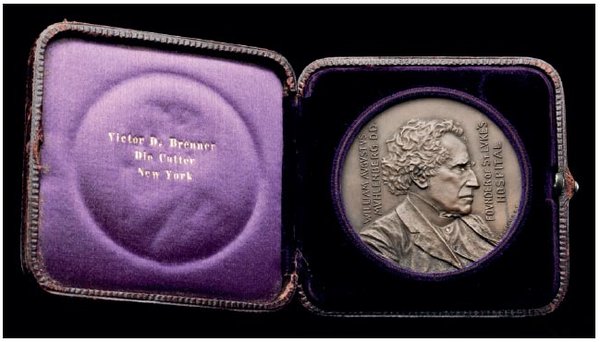
(Above) William Augustus Muhlenberg medal in bronze in original presentation case (private collection).
(Below) The original gold medal presented to St. Luke's Hospital, mounted in a large frame (courtesy of the library of St. Luke's—Roosevelt Hospitals).
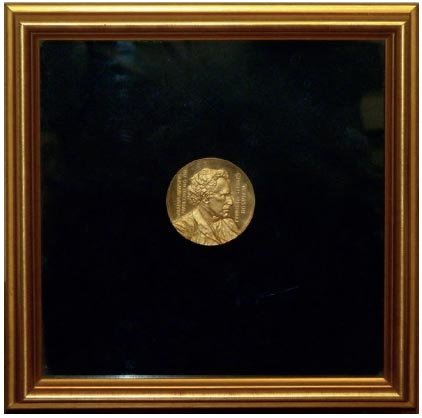
(Opposite, top) Engraving of the 1890s building for St. Luke's Hospital, seen from the south (courtesy of the library of St. Luke's—Roosevelt Hospitals).
(Opposite, left) Painting of William Augustus Muhlenberg, attributed to F. O. C. Darley, undated (courtesy of the library of St. Luke's—Roosevelt Hospitals).
(Opposite, right) Victor D. Brenner, undated. Brenner designed several of the Society's medals of the late nineteenth and early twentieth centuries (ANS Archives).
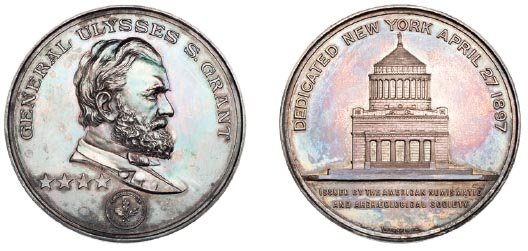
Grant Monument medal in silver (ANS 0000.999.7292).
Obv.: Bust of Grant, right; below is the seal of the Society. Four stars, denoting his rank, are between the bust and seal. Around, GENERAL ULYSSES S. GRANT; on truncation, signed TIFFANY
Rev.: A view of Grant's tomb. Around, DEDICATED NEW YORK APRIL 27 1897; in exergue, ISSUED BY THE AMERICAN NUMISMATIC / AND ARCHÆOLOGICAL SOCIETY; at 6:00, signed TIFFANY & CO.
by Tiffany & Co.
64 mm
Mintage
gold: 1
silver: 81
bronze: 500
According to the Society's notice of January 21, 1897, announcing its intention to issue a medal for the dedication of the Grant Monument, members were informed that prices would not exceed $10 for silver medals and $3 for bronze. Members were invited to subscribe for one silver and an unlimited number of bronze medals (untitled circular for Grant Monument medal, January 21, 1897, Grant Monument Medal scrapbook 1, ANS Archives). Ultimately, the bronze medals, housed in a "neat case", were available for $2.50 to members of the Society and to the public through Tiffany & Co. (untitled circular for Grant Monument Memorial Medal, undated, Grant Monument Medal scrapbook 1, ANS Archives).
The single gold specimen was presented to General Horace Porter, Grant's former secretary and the president of the Grant Monument Association, on the evening of April 23, 1897, at the Academy of Medicine Building, New York. The edge of Porter's gold medal bore the inscription "Presented to General Horace Porter by the American Numismatic and Archaeological Society, April 23, 1897" (Grant Monument Medal Committee 1898: 57). A detailed account of this event can be found in the Society's Proceedings for 1898, including the texts of addresses by Society President Zabriskie, General Porter, and two other dignitaries— George Macculloch Miller of St. Luke's Hospital and Seth Low of Columbia University (Grant Monument Medal Committee 1898).
In addition to the gold medal, silver specimens were presented to sixteen distinguished individuals: Mrs. Julia Dent Grant; President McKinley of the United States; the mayor of New York; the emperors of Austria-Hungary, Russia, Germany, China, and Japan; the queens of the United Kingdom and the Netherlands; the kings of Sweden-Norway, Spain, and Italy; Pope Leo XIII; the president of France; and Li Hongzhang, the former Viceroy of Zhili in China (Grant Monument Medal Committee 1898: 57).
These medals, housed in special cases, were accompanied by presentation letters from the Society. Due to a problem relating to etiquette, there was a slight delay with the medal for the Emperor of Japan. It appears that the case and the letter had different forms of address, with one improperly including the personal name of the emperor, Mutsuhito. In a letter to J. Sanford Saltus, the Secretary of the Legation of Japan requested that the form of address be changed to "His Majesty the Emperor of Japan", after which the medal was forwarded without incident (letter, K. Matsui to J. Sanford Saltus, July 12, 1897, Grant Monument Medal scrapbook 2, ANS Archives). The remaining silver medals were available for purchase by members of the Society at a price of $10.00 (Belden 1915: 33). A number of bronze medals were also presented to American and foreign numismatic organizations (Grant Monument Medal Committee 1898: 57).
Although the silver medals have serial numbers stamped on the edge, there does not appear to be any corresponding list to indicate the disposition of these medals by number. Of the silver presentation medals, the one presented to the Queen of the Netherlands reportedly does not bear a serial number and, while no longer housed in its presentation case, is accompanied by the letter of presentation (Claudia Maartensevan Ham, personal communication).
Three bronze medals were given to J. Sanford Saltus, to be presented as he saw fit in the name of the Society, while he was in Paris during the summer of 1897. He gave these to the Musée de la Monnaie, the King of Siam (who was then in Paris), and the duc d'Orléans. This last medal was presented in remembrance of the service in the United States Army during the Civil War by Orléans's father, the comte de Paris (Saltus 1898: 9). The dies for this medal were presented to the Society in March 1915 (letter, Tiffany & Co. to American Numismatic Society, March 18, 1915, ANS Archives).
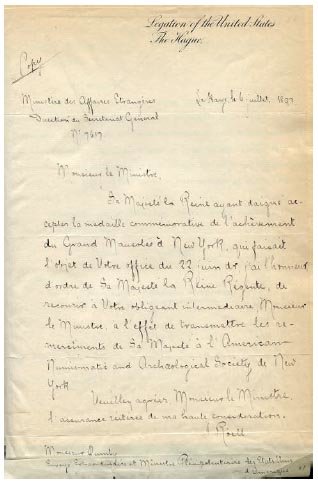
Copy of the presentation letter accompanying the silver Grant Monument medal sent to Queen Wilhelmina of the Netherlands (Grant Monument Medal Scrapbook 2, ANS Archives).
A number of bronze medals appear to have been retained by the Grant Monument Association for later use. One was given to the Prince of Wales when he toured New York in 1919 (Sotheby's 1997: lot 202). Another bronze example (in a private collection) was presented to Marshal Joffre in 1922, upon the centenary of Grant's birth.
The bronze medals were issued in purple card boxes with gold imprint on the cover. General Porter's gold medal was, until recently, thought to have been lost. Among his papers and effects at the Georgetown University Library is the rosewood presentation case marked TIFFANY & CO NEW-YORK which originally housed the gold medal. When presented to the library it contained a silver example of the Society's Hudson-Fulton medal. The inside of the cover contains the inscription PRESENTED TO / GENERAL HORACE PORTER / by / The American / Numismatic & Archæological / Society / April 23rd. 1897. The gold medal is reportedly now in New York in the possession of the National Park Service (e-mail, Lucas Buresch to Joseph Ciccone, ANS Archives; Steve Laise, personal communication).
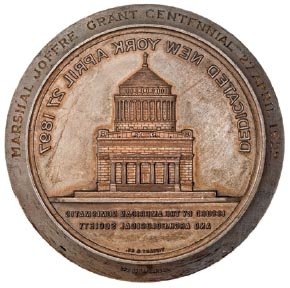
(Left) Grant Monument medal in bronze, with edge inscription for presentation to Joseph Joffre, Marshal of France, on his visit to Grant's Tomb in 1922 (private collection). The photograph was taken with the edge reflected in a parabolic mirror; the image is reversed to show the edge right-reading rather than the face.

(Below) Marshal Joffre speaking at Grant's Tomb on April 27, 1922, in commemoration of the centenary of Grant's birth (photograph by International Newsreel Corp.).
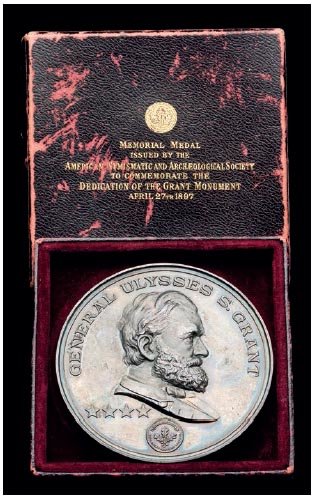
(Left) The original box in which the Grant Monument medal was issued, with an example in silver (private collection). As several silver medals have been seen in blue boxes, it is likely that this box may have originally been meant for a bronze medal.
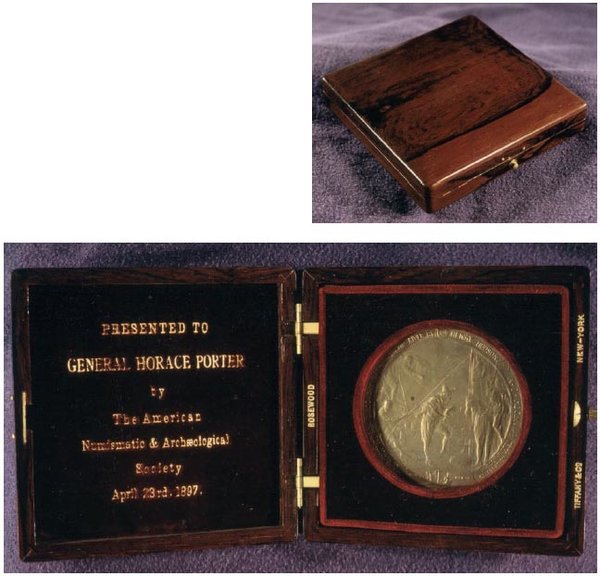
(Below right and bottom) The rosewood presentation case for General Porter's gold Grant Monument medal, now containing an example of the Society's Hudson-Fulton medal (courtesy of Georgetown University Library, reproduced with permission).
There is a related pin given to members of the Municipal Grant Monument Committee. Made by Tiffany & Co., the pin measures approximately 20 × 24 millimeters and consists of a gilt bust of General Grant superimposed on a gilt and white enamel depiction of his tomb; below, on a ribbon of blue enamel on a gilt wreath, is the inscription Municipal Grant Monument Committee / APRIL 27TH. 1897. This pin is housed in a small purple card box similar to those used for medals.
Members of the Reception Committee were given blue fish-tail ribbons imprinted with the Society seal and the date April 23rd, 1897; these were suspended from a red, white, and blue bow-shaped ribbon.

(Above) Ribbon worn by members of the Reception Committee at the Society's presentation of the gold medal to General Porter (ANS Archives).
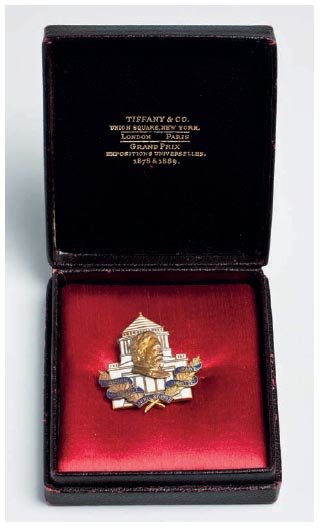
(Left) Gilt and enamel pin by Tiffany & Co. given to members of the Municipal Grant Monument Committee (private collection).
In seeking designs for this medal, the Society sought submissions from a number of firms and artists, including Tiffany &
Co., Gorham
Co., Victor D. Brenner, and Black, Starr & Frost
(undated list in Grant Medal Committee file, ANS Archives). The scope of artistic input was somewhat limited, as the
Society had already decided on the basic design of a 2½-inch medal: On reverse should appear view of monument and around it
"Dedicated April 27th, 1897" and on obverse, bust of General Grant and below it the seal of the Society. Inscription
"General U. S.
Grant" and separating head from seal, four stars (the symbol of rank) (Grant Monument Medal Committee 1898: 55).

An alternative design sketch that was not used, probably by Peter L. Krider Co. (Grant Monument Medal Scrapbook, ANS Archives).
The Society has several sketches representing designs that were not used, by Tiffany & Co., Victor J. Petry of Philadelphia,
and Peter L. Krider Co. of
Philadelphia. Although the design submitted by Brenner is not present in the
Society's archives, it was described in a letter from the artist to the Grant Medal Committee dated January 27, 1897:
I propose to
cut the dies; on the obverse to be a fine reproduction of the Photograph with your circular, to be cut in the same
style as the Dr.
Muhlenberg medal, and as shown in sketch. The American Eagle with its outspread wings resting on the Seal of the Society
proclaims
his glory. To the sides, battle axes tied with ribbons; above, four stars prominently appear with General Ulysses
S. Grant. Reverse, to be a fine reproduction of the Grant Tomb, to fill all space possible;
below and under the dividing line, "Dedicated, New York, April 27, 1897" (letter, Victor D. Brenner to Grant Medal
Committee, January 27, 1897, ANS Archives).

National Conference of Charities and Corrections medal in bronze (ANS 1987.147.17).
Obv.: Winged angel of mercy descending with hands extended in protection over two seated figures, a female representing poverty and a male criminal. In exergue, ·ISSUED· BY·THE·AMERICAN·NUMISMATIC· / ·AND· ARCHAEOLOGICAL·SOCIETY· / · NEW · YORK·;at 4:00, signed V D BRENNER 98
Rev.: To the right, an oak tree, its branches and foliage extended across the field; superimposed on the foliage is a nineteen-line inscription: ·TO·COMMEMORATE· / ·THE ·SESSION· OF·THE ·25TH· / ·NATIONAL·CONFERENCE·OF· / ·CHARITIES·AND·CORRECTION· / ·IN·THE· CITY·OF·NEW·YORK· / ·MAY·18TH·25TH· 1898· / ·PRESIDENT· / ·WILLIAM·RHINELANDER· STEWART· / ·NEW·YORK· / ·VICE ·PRESIDENTS· / ·CHARLES·R·HENDERSON· ·THOMAS·E· ELLISON· / ·CHICAGO· ·FORT·WAYNE · / ·ISAIAH · JOSEPHI· / ·NEW·YORK· / ·TREASURER· / ·LEVI · L·BARBOUR·DETROIT· / ·GENERAL·SECRETARY· / ·HASTINGS·H·HART· / ·ST. PAUL·;at 5:00, signed V. D. BRENNER
by Victor D. Brenner
77 mm
Mintage
gold: 1
silver: 30
bronze: 253
This medal was struck at the impetus of Society member William Rhinelander Stewart to mark the 25th National Conference of Charities and Correction, which was held in New York City, May 18–25, 1898. Upon receiving Stewart's proposal that the medal be issued under the auspices of the Society, approval was given on the conditions that the Society bear none of the expense, that it could approve the designs, that members could purchase examples in any metals used to strike medals, and that the dies be cancelled and deposited with the Society (Stahl 1996: 318–319).
The single gold specimen was presented to William Rhinelander Stewart, President of the Conference, and bore on its edge the inscription "Presented to William Rhinelander Stewart, by officers, members, and the Local Committee of One Hundred of the Twenty-fifth National Conference of Charities and Correction, in recognition of his invaluable services as President of the Conference of 1898". Fifteen silver specimens were presented to the officers of the Conference and of the Local Committee of One Hundred, as well as the speakers at the quarter-centennial celebration at Carnegie Hall; 235 bronze specimens were presented to members of the Conference and contributors to its funds. Members of the American Numismatic and Archaeological Society were each permitted to purchase one silver and one bronze, for a total of fifteen silver and eighteen bronze (Belden 1915: 35).
Silver specimens were issued in a square purple card box lined with purple velvet; the inner cover is gilt stamped with the name of the medalist. There is also an example in the Society's cabinet that bears the following hand-engraved edge inscription: TO MY FRIEND OGDEN WOOD PARIS 1901. V. D. BRENNER (ANS 0000.9999.6722).
William Rhinelander Stewart was elected a resident member on November 21, 1892 (Proceedings 1893: 46). In 1908 he presented his collection of 314 United States and foreign coins to the Society (Belden 1915: 15).
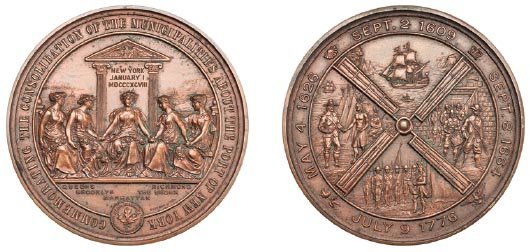
Greater New York (Charter Day) medal in bronze (ANS 1920.147.440).
Obv.: Five seated female figures representing the five boroughs; below each is the name of the borough represented. Behind the figures, within an ornamented pediment supported by two columns, is a tablet inscribed NEW YORK / JANUARY 1 / MDCCCXCVIII; in the background is a view of New York harbor, and below is the seal of the Society. Around, COMMEMORATING THE CONSOLIDATION OF THE MUNICIPALITIES ABOUT THE PORT OF NEW YORK
Rev.: The arms of a Dutch windmill; within the arms are four vignettes depicting (left) Peter Minuit purchasing Manhattan Island from the Indians, (top) Henry Hudson's ship the Halve Maen, (right) the Dutch, led by Peter Stuyvesant, evacuating Fort Amsterdam, and (bottom) a Continental officer reading the Declaration of Independence to American troops. Along the rim, separated by symbols appropriate to the events, are the dates reflected in the vignettes: (tulip) MAY 4 1626 (scallop shell) SEPT. 2 1609 (crown) SEPT. 8 1664 / JULY 9 1776 (eagle)
designed by Edward Hagaman Hall; dies by Tiffany & Co.
64 mm
Mintage
gold: 1
silver: unknown
bronze: unknown
The single gold medal was presented to Andrew H. Green, the "Father of Greater New York", on October 6, 1898 (Historical and Memorial Committee 1899); silver and bronze specimens were sold through Tiffany & Co. The Historical and Memorial Committee of the General Citizens' Committee on the Celebration of Municipal Consolidation adopted this medal as the official medal of the Charter Day Celebration and bore its expense; the Society merely approved the design and allowed the use of its seal. The celebration itself, scheduled for May 4, 1898, was cancelled due to the war with Spain (Belden 1915: 37).
According to a report printed in the Brooklyn Eagle on March 20, 1898, bronze medals were to be sent to the crowned heads of Europe, as was done with the Grant medal the preceding year ("The Charter Day Medal," Brooklyn Daily Eagle, March 20, 1898). However, there does not seem to be any evidence that this idea was ever acted upon. The gold medal is currently in the collection of an East Coast collector. It is housed in its original leather presentation case and bears the following inscription engraved on the edge: · TO HON. ANDREW H. GREEN, THE FATHER OF GREATER NEW YORK, OCTOBER 6. 1898. A TOKEN OF ESTEEM FROM HIS FELLOW CITIZENS. The cover of the presentation case bears a similar inscription. A second gold medal was originally intended to be struck for presentation to Brooklyn statesman James S. T. Stranahan ("Andrew H. Green Honored," New York Times, October 7, 1898). However, his death on September 3, 1898, obviated the need for a second gold medal (Jackson 1995: 1126).
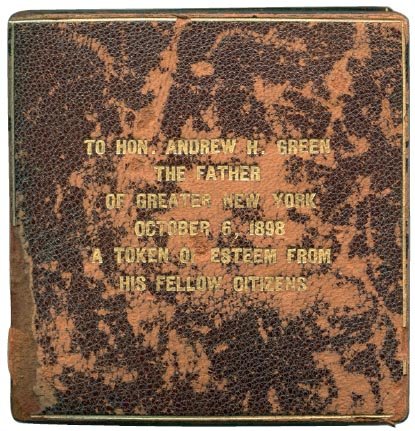
Leather-covered presentation case for gold Charter Day medal given to Andrew H. Green (private collection).

Charter Day medal in gold, with edge inscription for presentation to Andrew H. Green (private collection). The photograph was taken with the edge reflected in a parabolic mirror; the image is reversed to show the edge right-reading rather than the face.
Green first recommended in 1868 the consolidation of Manhattan with the many municipalities and unincorporated areas of Kings, Queens, Richmond, and southern Westchester Counties. In 1890 he again requested action by the state legislature, which resulted in his appointment as president of the Commission of Inquiry on Consolidation. The Consolidation bill, which Green helped draft, was passed by the legislature in 1897 and took effect on January 1, 1898 (Jackson 1995: 505). The consolidation was not welcomed by all residents, with the greatest opposition coming from Brooklyn, which was then the fourth-largest city in the United States, with a population in excess of 800,000 in 1890 (Jackson 1995: 277–278; Census Office 1895: 370).
On November 13, 1903, Green was murdered by a man who had mistaken him for another elderly gentleman who had
stolen the killer's girlfriend (Foord 1913: 261). In response, the Society passed the following resolution:
Resolved The recent news of the sad death of the Hon. Andrew H. Green by
assassination has been a great shock to the community, and while he was not a member of our Society, it is the desire
of its members
to express their deep sorrow at his loss, and their high respect for him as a fellow-citizen (Proceedings 1904: 22).
In the July 1904 issue of the American Journal of Numismatics, an article was published concerning a proposal for the striking of a quarter dime, or 2½ cent coin. According to that article, Andrew Green was a persistent, though unsuccessful, advocate of this odd denomination (AJN 1904: 22).

Prince Henry of Prussia medal in copper (ANS 0000.999.6728).
Obv.: Uniformed bust of Prince Henry, left. Around, ISSVED ·BY·THE·AMERICAN·NVMISMATIC· AND·ARCHÆOLOGICAL·SOCIETY / ·NEW· YORK·FEBRVARY·1902·; signedV. D. BRENNER in field to right of bust
Rev.: Mercury riding on a cloud, bearing on his right arm fruits and flowers, and in his left a caduceus; to the right are the German and American flags. Around, TO·COMMEMORATE·THE·VISIT·OF·HIS· ROYAL·HIGHNESS·PRINCE·HENRY·OF·PRVSSIA·; at 5:00, signed V. D. BRENNER
by Victor D. Brenner
69 mm
Mintage
gold: 4
silver: 301
copper: 2
aluminum: 1
In 1902 Prince Henry of Prussia came to the United States for the launching of a schooner yacht ordered by his brother, Emperor Wilhelm II of Germany. Christened Meteor III by Alice Roosevelt on February 25, the yacht was 161 feet long and cost $200,000 ("Miss Roosevelt Names Kaiser Wilhelm's Yacht," New York Times, February 26, 1902; "Emperor's Yacht coming," New York Times, November 7, 1903). Although the idea for this medal came from Edward Adams, it was the sculptor, Victor D. Brenner, who offered to underwrite the issue, accepting the risk of the entire cost except for the gold. Moreover, the Society was allowed to sell as many silver medals as it wished, retaining all profits after Brenner's fees (Stahl 1996: 320).
One medal in virgin gold was presented to Prince Henry. Three additional gold medals were struck for Edward D. Adams and J. Pierpont Morgan; of these, one was presented to the Metropolitan Museum of Art (MMA 02.17.1) and one to the Society (Belden 1915: 39). A gold medal, believed to be from the J. P. Morgan collection, was sold by Stack's in their sale of November 29–30, 1989. Of the two copper medals, one is in the Society's cabinet and the other was presented to James D. Hague, who had donated the gold used in the medal presented to Prince Henry. The single aluminum specimen was struck for the Society. A small die break is generally seen on the obverse at 6 o'clock, though one silver example in the Society's cabinet shows no evidence of the die break (ANS 0000.999.6725).
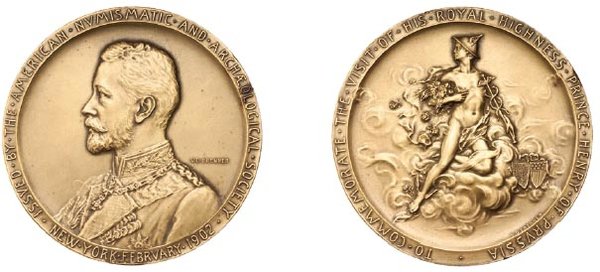
Gold example of the Prince Henry of Prussia medal in the Society's cabinet (ANS 0000.999.6723).
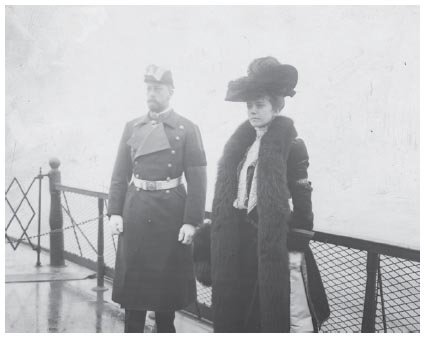
Prince Henry of Prussia and Alice Roosevelt at the christening of Meteor III, 1902 (Bain News Service, Library of Congress LC-DIG-gg-bain-16297).
In acknowledging receipt of the medal, Prince Henry sent the following note to the Society (letter, Prince Henry of Prussia to American Numismatic and Archaeological Society, April 25, 1902, ANS Archives):
Kiel, April 25, 1902
I have received the beautiful medal, which the American Numismatic and Archaeological Society has presented me with.
Deeply sensible of all the kindness shown to me by the American people I can only express once more my heartfelt thanks, this time to the distinguished society, which has caused the splendidly executed medal to be struck commemorating my recent visit to the United States.
Heinrich Prinz von Preußen
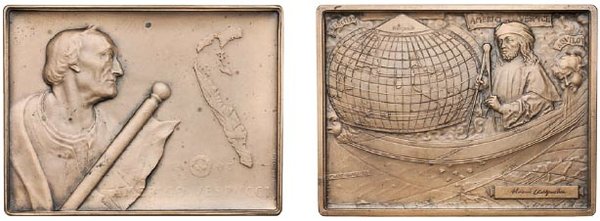
Amerigo Vespucci medal in bronze (ANS 0000.999.6730).
Obv.: Half figure of Vespucci, head right, holding a partially opened map or chart; to the right is a map of the New World, taken from the then recently discovered 1507 map of Martin Waldseemüller. Between the bust and the map at lower right, 19 (seal of the Society) 03 / AMERIGO VESPVCCI; along lower right edge, signed V. D. Brenner
Rev.: To the left, a reproduction of the small hemispherical map inserted in the Waldseemüller wall map of 1507; at the right is a bust of Vespucci holding dividers and below is a facsimile signature of Waldseemüller. In the lower left portion of the field is the artist's signature V. D. Brenner
by Victor D. Brenner
76 × 58 mm
Mintage
gold: 1
silver: 101
bronze: 59
copper: 1
This was the first in a short-lived "series of medals commemorative of notable events in the history of this country, or of persons who have rendered distinguished services in the discovery or development of America" (Committee on Medals 1903: 9). It was issued in honor of Amerigo Vespucci, the explorer for whom two continents were named. It also honors Martin Waldseemüller who, together with Matthias Ringmann in the book Cosmographiae Introductio, first proposed the name of the continent and in 1507 issued the first map to depict the new discoveries as entirely new continents, separate from Asia.
The single gold specimen was originally struck for J. P. Morgan and bears his name engraved on the edge. In 1978 the Society acquired this example through the generosity of Harry W. Bass, Jr. (Brady 1978: 26–27; ANS 1978.230.1). Silver medals were issued at a price of $7, with bronze examples offered for $5. Those medals not subscribed for were purchased by the members of the Medals Committee (Committee on the Publication of Medals 1908: 17).
The serial numbers for this medal are generally found with the numbers stamped backwards. At least one pair of uniface examples was struck in bronze; a set was donated to the Society in 2000 (ANS 2000.1.341, 2000.1.342) Also, at least one set of large bronze plaques bearing the design of this medal was cast for the Society (Committee on the Publication of Medals 1908: 17).

John Paul Jones medal in bronze (ANS 0000.999.5954).
Obv.: Bust of Jones, three-quarters left; behind is a laurel branch and to the left a small shield with an anchor. In panel below, JOHN·PAVL·JONES / ·1747·1792·;along right edge, signed V. D. Brenner
Rev.: In the foreground at right is a standing figure of Fame, left, blowing a trumpet; in the background is a funeral procession, right. Above, AMERICA· CLAIMS·HER·ILLVSTRIOVS·DEAD;below,·PARIS· ANNAPOLIS·1905·; at bottom left is the seal of the Society.
by Victor D. Brenner; struck by the Paris Mint (silver and bronze only)
80 × 60 mm
Mintage
gold: 1
silver: 100
bronze: 100
This medal was issued to commemorate the removal of the remains of John Paul Jones from Paris to Annapolis in 1905. It was the second in the series of medals commemorative of notable events or distinguished persons in American history. Although the original intent was to issue one medal in this series yearly, it soon became evident that this was not to be. At the Society's annual meeting on January 16, 1905, the Committee on Medals begged "leave to report that, notwithstanding diligent efforts, it has been unable as yet to arrange definite terms for the design and issue of the medal for which the necessary authentic data have, after much delay, been successfully gathered" (Committee on the Publication of Medals 1905: 8).
Although the original plan was to issue this series of medals in chronological order, the discovery of the remains of John Paul Jones and their subsequent transfer to the United States was considered so important an event as to warrant a departure from the original plan. Victor D. Brenner, who was given the commission for this medal, was in Paris when the ceremonies surrounding the transfer of remains took place (Committee on the Publication of Medals 1907: 19).
Of the 201 medals struck, the Society retained one each in bronze, silver, and gold. Silver examples were also presented to the United States Naval Academy at Annapolis and to General Horace Porter, recent Ambassador of the United States to France. The remaining medals were offered to members of the Society, with orders accepted for a period of one month ending January 1, 1907. Bronze medals were offered at a price of $8, and silver for $10 (Committee on the Publication of Medals 1907: 20). Those medals that were not sold by the end of the subscription period were purchased by members of the committee, leaving a surplus of $467.17. At least one set of large bronze plaques was cast for the Society (Committee on the Publication of Medals 1908: 17). In addition, an unknown number of sets of uniface clichés were made bearing the cornucopia and bronze edgemarks; a number is stamped in each of the four corners of the back of the cliché.
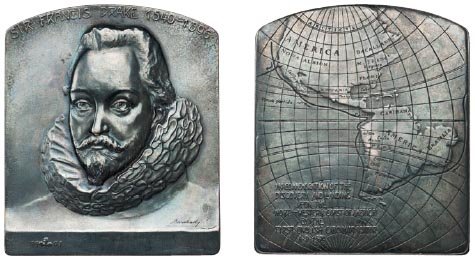
Sir Francis Drake medal in silver (ANS 1987.147.169).
Obv.: Bust of Drake, slightly left, in ruff collar. Above, SIR FRANCIS DRAKE 1540–1596; at lower right, signed Marschall; below, in lower left corner, 19 (oak leaves from the Society's seal) 07
Rev.: A portion of the "Silver Map" medal showing the Americas; towards the bottom is a seven-line inscription: IN COMMEMORATION OF THE / DISCOVERY AND LANDING / VPON THE / NORTH-WESTERN COAST OF AMERICA / BY THE / FIRST ENGLISH CIRCVMNAVIGATOR / A·D· 1579
by Rudolf Marschall; struck by the Imperial-Royal Mint, Vienna
56 × 65 mm, with arched top
Mintage
gold: 1
silver: 102
bronze: 102
This was the third issue in the series of medals commemorative of notable events or distinguished persons in American history. Sir Francis Drake was the first Englishman to circumnavigate the world. He landed on the coast of California on June 17, 1579, and promptly claimed the country for Queen Elizabeth, proclaiming the area "Nova Albion".
Through the cooperation of Lady Fuller-Elliott-Drake, the obverse portrait was based on an oil painting from life by Abraham Janssens which was still in possession of the Drake family in 1907. The reverse depicts a portion of the famed "Silver Map" medal, which was made some years after the completion of Drake's voyage in 1580 and which depicts, on its two sides, the route of Drake's circumnavigation on an outline map of the known world (Committee on the Publication of Medals 1908: 15–16).
The silver and bronze examples in the Society's collection bearing serial number 1 were donated by Edward D. Adams in 1908 (ANS 1908.9.1, 1908.9.2). In addition to the 201 medals issued by the Society, at least one set of uniface strikes was made; the obverse was sold by Presidential Coin and Antique Co. in 1989. Four additional examples were struck, two each in silver and bronze, marked A and B, for the artist. There was also at least one set of large bronze plaques cast, bearing the design of this medal for the Society (Committee on the Publication of Medals 1908: 17). The entire mintage was reported as having been struck at the Imperial-Royal Mint in Vienna (Committee on the Publication of Medals 1908: 17). Examination of the silver medals reveals the JC mintmark of Josef Christian Christlbauer, who produced medals both for the Imperial-Royal Mint and privately. The dies are currently in the possession of the Metropolitan Museum of Art, having been donated by Edward D. Adams in 1908 (MMA 08.128.1, 08.128.2).
The initial offering allowed members until February 29, 1908, to purchase one medal in either metal, at a price of $10 for bronze or $12 in silver. After that date, the Committee would be authorized to dispose of the remaining medals as it thought best. One medal was presented to Lady Drake, who acknowledged receipt in a letter that indicated "she was surprised 'to see how excellently the likeness has been preserved, and not that only, but also the expression, the spirit of the picture' and that 'this most artistic medal portrait will be preserved as one of our choicest family treasures'" (Committee on the Publication of Medals 1908: 17).
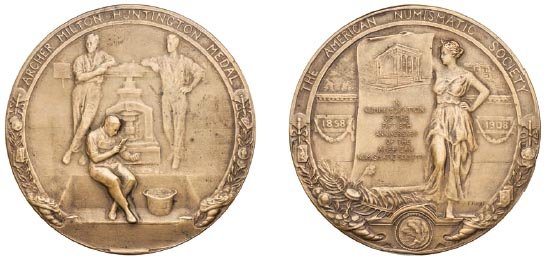
Archer Milton Huntington medal in bronze (ANS 0000.999.4326).
Obv.: Two male figures standing on each side of a coin press; in front is a third male figure, seated, examining a coin through a magnifying glass. Around top, ARCHER MILTON HUNTINGTON MEDAL
Rev.: Standing female figure, facing left, holding a scroll upon which is a representation of the Society's building, along with an eight-line inscription: IN / COMMEMORATION / OF THE / FIFTIETH / ANNIVERSARY / OF THE / AMERICAN / NUMISMATIC SOCIETY; on either side are the dates 1858 and 1908; below, the Society's seal and THE AMERICAN NUMISMATIC SOCIETY
by Emil Fuchs; struck by Whitehead and Hoag, Medallic Art Co.
68 mm
Original mintage
gold: 1
silver: 11
bronze: 25
The solitary gold specimen was presented to Archer Huntington. Only eleven silver and twenty-five bronze medals were originally produced, but additional medals have been struck over the years. Since 1918, silver medals have been awarded on a yearly basis for distinguished scholarship in numismatics. Additional bronze medals were also struck and presented to contributors to the Society's two exhibitions in 1914, that of United States and Colonial coins, from January 17 to February 18, and that of United States paper money and notes, March 26 to May 15 (Belden 1915: 47). Originally struck by the firm of Whitehead and Hoag, later strikings have been by the Medallic Art Company.
At the meeting in celebration of the Society's fiftieth anniversary in April 1908, George Kunz offered a proposal that the Society strike a medal bearing a portrait of Archer Huntington on the obverse and a view of the new building on the reverse. In addition to a gold specimen to be presented to Huntington, silver examples would be used as awards for those who made substantial contributions to numismatics, with bronze medals available for sale.
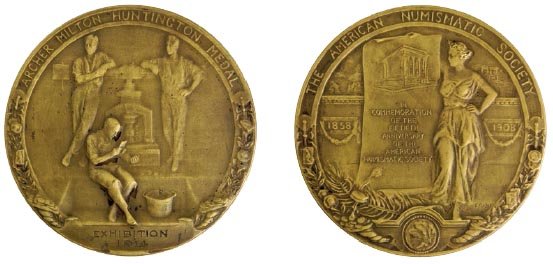
(Above) Archer Milton Huntington medal in bronze, with engraved inscription added as for lenders to the Society's 1914 exhibitions (ANS 0000.999.4316).
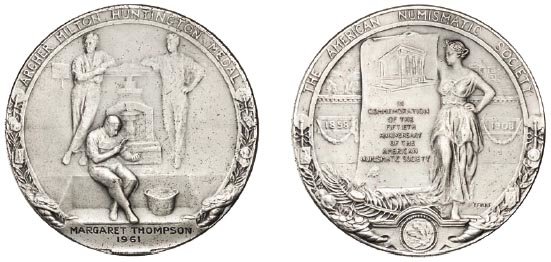
(Below) Archer Milton Huntington medal in silver, awarded to Margaret Thompson in 1961 (ANS 1998.96.1).
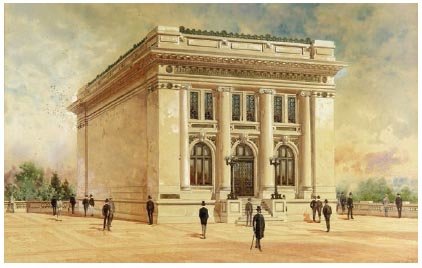
Architect's rendering of the Society's original building at Audubon Terrace, completed in 1908 (ANS Archives).

Pencil sketch by Victor D. Brenner, showing his original proposed design for the Archer Milton Huntington medal (ANS Archives).
A potentially embarrassing situation had to be resolved with regard to the design of this medal. Two months earlier, Victor D. Brenner had submitted a sketch for just such a medal to Bauman Belden, the Society's Recording Secretary. However, the chairman of the Committee on the Publication of Medals, Edward D. Adams, intended to have a different artist prepare the medal. Concerned that the Society might in some way be obliged to Brenner for the production of this medal, both Adams and Belden corresponded with Brenner to determine what the artist's understanding was with regard to the medal. Brenner responded, "After having done a certain amount of work, I could find no one of the gentlemen interested willing to take up the responsibility of the medal and in consequence have destroyed all the studies I had."
Subsequent to Kunz's resolution, Huntington made it known that he did not wish his portrait to appear on the medal. The commission was given to Emil Fuchs, who had recently been elected a corresponding member of the Society on the recommendation of Archer Huntington (letter, Bauman Belden to Emil Fuchs, January 4, 1908, ANS Archives). Fuchs produced a design in accordance with Huntington's preferences (Stahl 1996: 323–325).

Fiftieth Anniversary medal in silver with oak leaf clasp (ANS 0000.999.3176).

Fiftieth Anniversary medal in bronze (ANS 0000.999.6738).
Obv.: Seal of the American Numismatic Society
Rev.: Three-line inscription: MDCCCLVIII / ·APRIL·VI· / MCMVIII
struck by Tiffany & Co.
25 mm
Mintage
gold: 1
silver: 25 (suspended from a clasp depicting an oak leaf with two acorns)
bronze: 100 (without clasp)
The obverse was based on the Society's new seal, designed in 1907 by Victor D. Brenner. This medal was produced for the attendees at the Society's fiftieth anniversary celebration on April 6, 1908. The single gold specimen was presented to Archer Huntington. Silver specimens were presented to the eleven members of the Society's Council. The bronze medals were presented to the other attendees at the celebration.
All of the silver medals were originally issued bearing the reverse design. In 1923, Howland Wood forwarded a silver medal to the Medallic Art Co. with a request to smooth off the reverse and engrave OFFICIAL REPRESENTATIVE BRUSSELS 1923 around the edge and VICTOR TOURNEUR across the middle (letter, Howland Wood to C. C. Trees, March 9, 1923, ANS Archives).
This alteration seems to have met with approval, as Wood forwarded an additional seven silver medals to the Medallic Art Co. to have the reverses similarly smoothed off and then engraved with the names of some recent Council members with their dates of appointment (letter, Howland Wood to C. C. Trees, April 26, 1923, ANS Archives):
| Albert Gallatin | October 20th, 1922. |
| Harrold E. Gillingham | May 6th, 1918. |
| Robert James Eidlitz | January 15th, 1916. |
| Stephen H. P. Pell | November 16th, 1916. |
| Herbert Scoville | January 17th, 1922. |
| W. Gedney Beatty | January 30th, 1917. |
| John Reilly, Jr. | March 26th, 1914. |
The ANS cabinet currently contains five of these seven engraved medals. The inscriptions appear slightly modified from the form originally requested by Wood:
JOHN REILLY JR. / COUNCIL / 1914 (serial number 16; ANS 0000.999.6735)
W. GEDNEY BEATTY / COUNCIL / 1917 (serial number 23; ANS 0000.999.6736)
HERBERT SCOVILLE / COUNCIL / 1922 (serial number 26; ANS 1937.146.11)
HARROLD E. GILLINGHAM / COUNCIL / 1918 (serial number 24; ANS 1955.15.1)
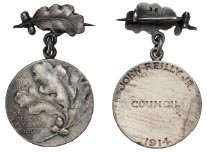
Fiftieth Anniversary medal in silver with the reverse smoothed off and engraved for John Reilly, Jr., who was first elected to the Society's Council in 1914 (ANS 0000.999.6735).

Invitation card for the special meeting celebrating the Society's fiftieth anniversary, at which this medal was distributed (ANS Archives).
ROBERT JAMES EIDLITZ / COUNCIL / 1918 (serial number 25; ANS 1940.100.451)
Of the seventeen unaltered silver medals, one currently resides in the Society's collection (serial number 12; ANS 0000.999.3176). The ten bronze examples owned by the Society bear serial numbers ranging from 58 to 128, indicating the numbering was probably consecutive, regardless of composition. Based upon the medal with a serial number higher than 126, it is possible that the actual mintages are slightly higher than reported. The bronze examples bear the serial numbers and maker's mark on the edge, while the silver specimens are marked on the reverse of the oak-leaf suspender. All the bronze examples in the Society's cabinet display some degree of verdigris, as do those examined in private collections, suggesting that they were issued with some verdigris in the patina.
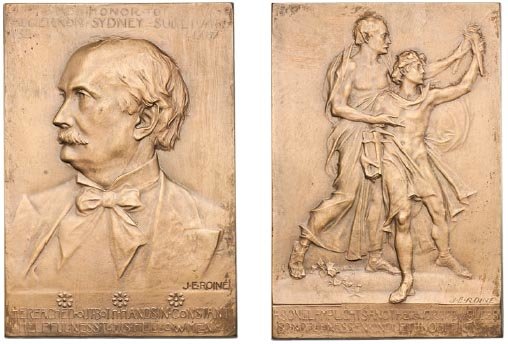
Algernon Sydney Sullivan medal in bronze, struck by J. K. Davison's Sons (ANS 1940.100.450).
Obv.: Bust of Algernon Sydney Sullivan, head left. Above, ⁕ IN ⁕ HONOR ⁕ OF ⁕ / ALGERNON · SYDNEY·SULLIVAN / 1826 1887; below, (three flowers) / HE·REACHED·oUT·BoTH·HANDS·IN· CoNSTANT / ⁕ HELPFULNESS·To HIS·FELLoW· MEN ⁕; at lower right, signed J·E·ROINÉ; at lower right, signed J·E·ROINÉ
Rev.: An older man reaching out to aid a youth, and with his flaming torch lighting the torch of the younger. Below is a quotation from James Russell Lowell: AS·ONE·LAMP·LIGHTS· ANOTHER·NOR·GROWS·LESS / SO·NOBLENESS ·ENKINDLETH·NOBLENESS·; at lower right, signed J·E· ROINE
by J. Édouard Roiné; struck by Arthus Bertrand (?), J. K. Davison's Sons
60 × 88 mm
Mintage
silver: unknown
bronze: unknown
Although this medal was not originally commissioned by the American Numismatic Society, its connection to the Society justifies its inclusion in this listing. Until a group of forty medals, each housed in its original blue cloth book, was found at the Society in 1983, little was known of this medal. Most of the small hoard discovered was offered for sale to the Society's members for $75 each, with a maximum order of two per member ("Early ANS Medals Offered by Society," ANS Newsletter, Summer 1984, p. 5). Although it was originally believed that all the medals were bronze, it later turned out that a small number, possibly five or six, were silver. The book contains, in addition to the medal, a biography and tributes to Sullivan.
In order to understand this heretofore enigmatic medal and its relation to the American Numismatic Society, it might be best
to quote
from the book in which it is housed: The Algernon Sydney Sullivan Medal is issued and presented by the American Numismatic Society as
the successor, in this matter, to the Algernon Sydney Sullivan Memorial Committee. The medal may be issued
from time to time by the society in commendation of excellence of character, conduct and attainments, and to encourage
in others the
humane and noble use of their abilities, so conspicuous in the life of Mr. Sullivan.
More
especially, it is the intention to issue the medal to young men and women admitted to practice at the bar in New
York City. For it was in the practice of the law in that city that the greater part of Mr.
Sullivan's life was spent; and it is a significant fact that the members of the bar who observed him in the daily
conduct
of their profession, held him in admiration and affection (Kobbé 1911: 9).
The Algernon Sydney Sullivan Memorial Fund was established by Sullivan's son and law partner, George H. Sullivan. In 1913 he gave the Society the medals in their books, along with a small endowment to support future striking as needed. Five medals were to be presented yearly to those new attorneys in New York City who had done best in the bar examination. However, the medals and the fund remained unused for years, because nobody was willing to take responsibility for selecting the winners of the medal. In 1929, realizing that the Society would never be able to fulfill its trust and award the Sullivan medals, George Sullivan reestablished the Algernon Sydney Sullivan Memorial Fund as an endowment for the purchase of medals, preferably by foreign artists (Adelson 1958: 187). The Sullivan medals remained unissued.
The Society's cabinet contains two bronze examples with different finishes. The first, with a smooth finish, is stamped on the edge with BRONZE and a triangle, possibly indicating it was struck by Arthus Bertrand (ANS 0000.999.4310). The second medal has a matte finish and bears the edge stamp DAVISON PHILA. (ANS 1940.100.450).

Algernon Sydney Sullivan medal in bronze, with triangle mintmark (ANS 0000.999.4310).
Algernon Sydney Sullivan, who became a member of the Society in 1880, was a prominent New York lawyer. Several years after his death in 1887, a memorial committee was established to preserve the memory of his personality as a model for others. The committee consisted of seventy-seven citizens, including former President Grover Cleveland, Governor Roswell P. Flower, Mayor Hugh J. Grant, Bishop Henry C. Potter, Andrew Carnegie, and Cyrus H. McCormick. Among the means adopted by the committee to preserve Sullivan's memory were the issuance of a biographical pamphlet, the erection of a drinking fountain in Van Cortlandt Park in New York City, and the presentation of an oblong portrait plaque to various educational institutions and public bodies (Kobbé 1911: 10–13).
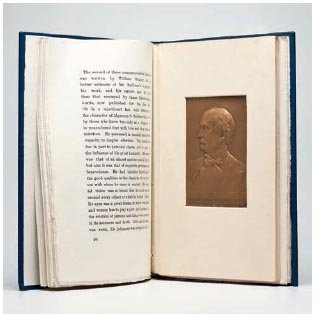
(Above) The medal seen in its cardboard frame in the Algernon Sydney Sullivan memorial book (Kobbé 1911).
In 1925, George Sullivan and the New York Southern Society, of which Algernon Sydney Sullivan had been the first president, created a different Algernon Sydney Sullivan Award medal (Algernon Sydney Sullivan Foundation n.d.). This award consists of a framed uniface medallion based on the reverse of the earlier Sullivan medal and is accompanied by a framed description of the award and a copy of a brief biography of Sullivan. It is awarded to deserving students at selected colleges and universities in the southern United States. A similar award was established in memory of his wife, Mary Mildred Sullivan, by the New York chapter of the United Daughters of the Confederacy. That award is presented to persons who demonstrate "the spirit of helpfulness and an awareness of the beauty and the intangible elements of life". Today, both awards are administered by the Algernon Sydney Sullivan Foundation, established by George Sullivan in 1934.

Centennial of the Catholic Diocese medal in silver (ANS 0000.999.4356).
Obv.: Central portrait medallion of Archbishop John Farley, left, surrounded by portraits of his six predecessors as prelate of the Diocese of New York: Bishop Concanen, Bishop Connolly, Bishop Dubois, Archbishop Hughes, Cardinal McCloskey, and Archbishop Corrigan. Above, representing the Holy Trinity, is a dove with trefoil; below is a pectoral cross. Around central portrait, JOHN·M· FARLEY / ⁕ ABP. ⁕; around outside, ✠·CARD·ABP· McCLOSKEY· ✠·ABP·M ·CORRIGAN· ✠ ·ABP·J· HVGHES· ✠ / ·B P ·J·DVBOIS· ✠·BP ·CONCANEN ·O·P· ✠·BP·CONNOLLY·O·P·; at 4:00, signed J·E· ROINE; at 8:00, small ANS seal
Rev.: Oblique view of St. Patrick's Cathedral from the west; on either side are representations of St. Peter's Church of 1808, in Barclay Street, and St. Patrick's Church of Mott Street, consecrated in 1815. At top are the arms of Pope Pius X; below are those of Pope Pius VII, who created the diocese in 1808; to the right are the arms of Archbishop Farley and to the left those of the diocese of New York. Around, CENTENARY · OF THE · ESTABLISHMENT OF · THE · DIOCESE OF · NEW · YORK / 1808 1908
by J. Édouard Roiné; struck by Medallic Art Co.
76 mm
Mintage
gold: 1
silver: 101
bronze: 101
The single gold specimen, reportedly bearing serial number 1, was presented to Pope Pius X. The silver and bronze specimens numbered 1 were presented to Archbishop Farley. Silver and bronze specimens numbered 2 through 101 were struck for the American Numismatic Society and sold for $10 and $5, respectively; they each bear the edge stamps of the Medallic Art Co. along with a diamond-D (Committee on the Publication of Medals 1910: 26; Belden 1915: 53). 2
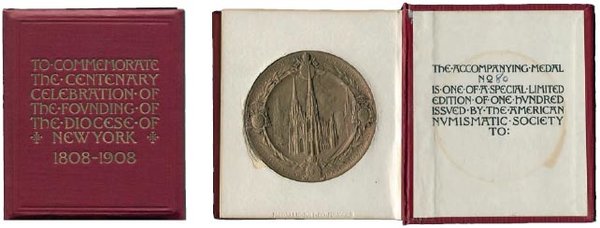
(Above) The red case in which the Centennial of the Catholic Diocese medals issued by the Society were housed, showing the statement of limitation in the inside back (ANS 1984.75.1; 111 × 127 mm).
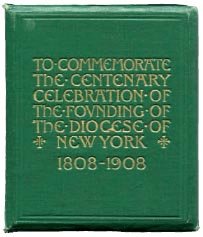
(Left) The green case for the Centennial of the Catholic Diocese medals issued by the diocese in 1908 (private collection).
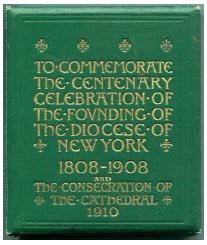
(Right) The modified green case for the additional Centennial of the Catholic Diocese medals issued in 1910 (private collection; 109 × 126 mm).
Unnumbered bronze specimens were struck in 1908 for the Roman Catholic Church in New York by J. K. Davison's Sons, Philadelphia. They are sometimes found in green boxes similar to those issued by the Society, but lacking the numerical limitation on the inside back cover. A gold example, lacking a serial number, was until recently in the possession of Anthony Terranova, the well-known East Coast coin dealer, who was informed that it was the one given to Pope Pius X but apparently never forwarded to him. While the lack of a serial number raises questions as to whether or not it was the medal presented to Pope Pius, the medal's provenance, coupled with the fact that Belden does not indicate the gold medal presented to the Pope bore a serial number, indicates this medal could very well be the same one struck for His Holiness.
Additional medals were issued by the Diocese in 1910 for the consecration of the cathedral. These were struck by the Medallic Art Company and issued in green cases similar to the original issue, but with the additional inscription AND / THE·CONSECRATION· OF / ✠ THE·CATHEDRAL ✠ / 1910.
| Subscribers | Silver | Bronze | Total | |
| Archbishop Farley | 1 | 1 | 2 | |
| Society's cabinet | 1 | 1 | 2 | |
| Patrons | 4 | 4 | 4 | 8 |
| Honorary presidents | ||||
| Honorary members | 1 | 1 | 1 | |
| Members (life) | 30 | 29 | 18 | 47 |
| Members (annual) | 9 | 4 | 7 | 11 |
| Associate members | 1 | 1 | 1 | |
| Corresponding members | 1 | 1 | 1 | |
| 39 | 34 | 73 | ||
| Medals on hand | 37 | 67 | 104 | |
| Total | 76 | 101 | 177 |
In its 1911 Proceedings, the Society provided statistics concerning the distribution for this medal and the Cleveland medal (p. 68). The report for this medal indicated the subscription numbers shown in the table above (Committee on the Publication of Medals 1911: 15):
There are two uniface lead impressions of an un-adopted pattern in the Society's cabinet. Measuring about 70 millimeters on 80 × 80 millimeter planchets, the design, while similar to the issued medal, is less bold in design and execution (ANS 0000.999.4382 and 0000.999.4383):
Obv.: A central medallion with a bust of Archbishop Farley surrounded by busts of Cardinal McCloskey, Bishop Dubois, Bishop Concanen, Bishop Connolly, Archbishop Hughes, and Archbishop Corrigan; below is a cross with a dove in the center.
Rev.: Small-size view of St. Patrick's Cathedral within a wreath; above is a portrait of Pope Pius VII, while below is a portrait of Pius X.
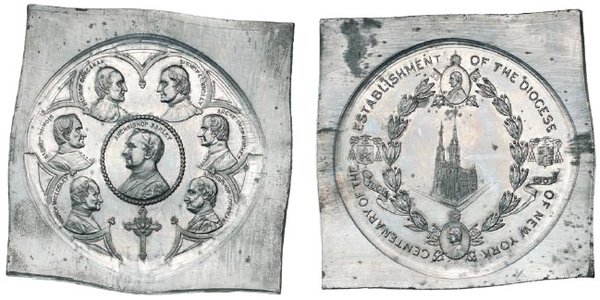
Uniface lead impressions of rejected design (ANS 0000.999.4382 and 0000.999.4383).
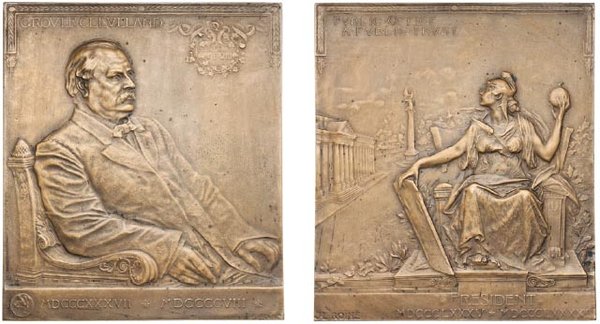
Grover Cleveland memorial medal in bronze (ANS 0000.999.4385).
Obv.: Half-length seated portrait of Cleveland, right; above, to the right, within a wreath of ivy, are the words VOX POPULI. Above left, GROVER CLEVELAND; below, (ANS seal) MDCCCXXXVII ⁕ MDCCCCVIII ⁕
Rev.: A seated female figure representing Democracy, her faced turned upward as if reading the words excerpted from Cleveland's October 25, 1881, speech accepting nomination for Mayor of Buffalo: PVBLIC·OFFICE / A·PVBLIC·TRVST. Democracy holds a starred sphere in her left hand, representing the states in the Union, and supports in her right hand the tables of the law. The building to the left is suggestive of public office, while the oak trees represent the peace and shelter of retired life; the monumental column surmounted by an eagle in the background is symbolic of force and alertness. Below right, ⁕ PRESIDENT ⁕ / MDCCCLXXXV ★ MDCCCLXXXXIII; below left, signed J·E·ROINÉ
by J. Édouard Roiné; struck by the Medallic Art Company
78 × 89 mm
Mintage
gold: 2
silver: 50
bronze: 100
This medal was issued to commemorate the life and public works of President Grover Cleveland. It was offered for sale in a circular dated March 1, 1910, with silver specimens priced at $10 and bronze ones at $5. Two gold specimens of this medal were struck (Belden 1915: 55): one is in the Society's collection; the other was sold by Presidential Coin and Antique Co. in its December 14, 1991, auction, lot 355. One silver specimen was presented to Mrs. Cleveland, and one bronze to the president's son, Richard Cleveland (Committee on the Publication of Medals 1911: 15). In addition, four silver medals bearing serial numbers 3, 10, 16, and 46 were "junked" on September 24, 1918 (Medals ledger, ANS Archives). It is quite likely that none of these four were actually melted, as a silver medal bearing the serial number 46 was reliably reported in 2012.
| Subscribers | Silver | Bronze | Total | |
| Mrs. Cleveland | 1 | 1 | ||
| Richard Cleveland | 1 | 1 | ||
| Society's cabinet | 1 | 1 | 2 | |
| Patrons | 3 | 3 | 10 | 13 |
| Honorary presidents | 1 | 1 | 1 | |
| Honorary members | ||||
| Members (life) | 17 | 20 | 9 | 29 |
| Members (annual) | 14 | 9 | 7 | 16 |
| Associate members | 2 | 1 | 2 | 3 |
| Corresponding members | 1 | 1 | 1 | |
| 36 | 31 | 67 | ||
| Medals on hand | 14 | 69 | 83 | |
| Totals | 50 | 100 | 150 |
In accordance with the instructions of Edward D. Adams, in 1909 the Medallic Art Company forwarded to the Society the dies and collar from which this medal was struck (letter, Medallic Art Co. to Bauman L. Belden, September 15, 1909, ANS Archives).
The breakdown of the distribution of this medal as of early 1911 was as shown in the table above (Committee on the Publication of Medals 1911: 15).
In addition to the regular struck medals, at least three large bronze casts of the obverse and a pair of uniface casts included in the 1910 International Medallic Exhibition of the American Numismatic Society were produced. The first was to be placed on a boulder at the entrance to Cleveland Road in Tamworth, New Hampshire, where Cleveland had a vacation home. The other two were for display in New Jersey, at the Grover Cleveland Home in Caldwell and at the Cleveland High School in Cranford, which is no longer in existence (Adelson 1958: 182). A recent visit to the Cleveland Home confirmed the plaque was still on display.

The 76-mm Hudson-Fulton medal in silver (ANS 0000.999.4358).
Obv.: Henry Hudson and sailors on the Halve Maen watch the hoisting of a heavy article from outside the ship. Around top, DISCOVERY OF HUDSON RIVER BY HENRY HUDSON A·D·MDCIX; at lower left, THE AMERICAN NUMISMATIC SOCIETY; at lower right, HUDSON-FULTON CELEBRATION COMM:; in exergue, HALVE MAENE; in lower right corner, signed E·FUCHS
Rev.: Three seated female figures representing Steam Navigation, History, and Commerce; above is a portrait of Robert Fulton. In the background are views of New York in 1807 and 1909. Below portrait, ROBERT FULTON / 1765 1815; in exergue, FIRST USE OF STEAM NAVIGATION / ON THE HUDSON RIVER / 1807; in lower right corner, signed E. FUCHS
by Emil Fuchs; struck by Tiffany & Co., Whitehead and Hoag
76 mm
Mintage
silver (76-mm size): 100
Officially, there is no obverse or reverse. According to Edward D. Adams, By reason of the importance and
distinctive character of each design, neither supplementing the other, and because the events commemorated occurred
two hundred
years apart, the faces of the medal do not properly come under the customary designation of obverse and reverse. There
is no reverse
to describe or illustrate the obverse; each side is complete by itself. Chronologically the Hudson side
would be the obverse and the Fulton side the reverse. Practically this technical relation will change
according to the artistic tastes or sympathies of the observer. In order to facilitate the exhibition and examination
of each side,
from time to time, as may be desired, some of the cases prepared by the Commission for the presentation examples have
been made to hang or stand, so that the medal may be reversed in position (Adams 1909: 154).
| Size | Gold | Solid silver | Silver-plated hard metal | Bronze | Aluminum |
| 4 inches | Commission and principal guests | Public sale | |||
| 3 inches | Heads of nations and American Numismatic Society | American Numismatic Society | |||
| 2½ inches | Citizens' committees and official aides | Official banquet and aquatic games | |||
| 2 inches | Other guests and aquatic games | Public sale | |||
| 1½ inches | Aquatic games | Awards of merit for public schools | Aquatic games | ||
| 1¼ inches | Aquatic games | Visiting sailors and public sale |
After Adams 1909: 153.
| Size | Mintage | Issue price |
| 4-inch silver | 1,000 a | |
| a |
Of these, 342 were returned to Whitehead & Hoag by the Hudson-Fulton Celebration Commission, leaving a net issue
of 658 (Waters 2009: 9).
|
$10.00 b |
| b |
This price applies only to Commissioners; the medals for Principal Official Guests were
presented by the Commission.
|
|
| 4-inch bronze | 1,250 | $2.00 |
| 4-inch bronze in halves | 900 | |
| 3-inch gold | 11 | |
| 3-inch silver | 100 | |
| 2½-inch silver | 1,000 | $4.00 |
| 2½-inch bronze | 2,200 | |
| 2-inch silver | 2,750 | |
| 2-inch aluminum | 30,000 | $0.25 |
| 1½-inch silver c | ||
| c |
Several 1½-inch silver-plated medals have been seen with the words YONKERS
NY instead of THE AMERICAN NUMISMATIC SOCIETY on the
obverse.
|
176 |
| 1½-inch bronze | 266 | |
| 1½-inch silver-plated (with ribbon) | 4,912 | |
| 1¼-inch silver | 44 | |
| 1¼-inch silver-plated special | 20,200 | |
| 1¼-inch silver-plated | 60,000 | $0.10 |
This design was adopted by the Hudson-Fulton Celebration Committee as its official medal; it was issued in various sizes and metals, as shown in the table above. Only the 76-millimeter silver medals were issued by the American Numismatic Society. Two gold medals were struck and presented to the presidents of the American Numismatic Society and the Metropolitan Museum of Art. An additional eight medals were struck in virgin Alaskan gold for presentation to the heads of nations represented by warships at the Hudson-Fulton celebration: the United States, the United Kingdom, the Netherlands, Germany, France, Italy, Mexico, and Argentina; the edge of each was engraved "To the Government of (name of Government) from the Hudson-Fulton Celebration Commission, September 25–October 9, 1909. A token of Friendship and Appreciation" (Hall 1910: 1112). These medals were housed in leather cases, suitably stamped, and were accompanied by engrossed and illuminated letters bound in book form with hand-tooled covers.

Examples of each size of the Hudson-Fulton medal issued by the Hudson-Fulton Celebration Commission (clockwise from upper right: 4-inch bronze, ANS 0000.999.4374; 3-inch gold, ANS 0000.999.4357; 2 ½-inch bronze, ANS 0000.999.4365; 2-inch aluminum, ANS 0000.999.4378; 1 ½-inch bronze, ANS 0000.999.4375; 1 ¼-inch silver-plated, ANS 0000.999.4315).
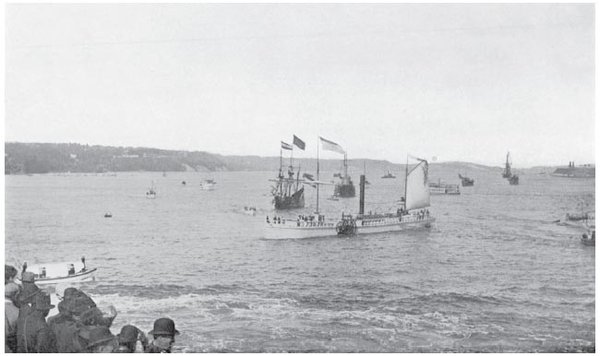
Replicas of the Halve Maen and Clermont in the Hudson River at Newburgh, part of the naval parade for the Hudson-Fulton Celebration (Hall 1910: 1285).
The gold medals and their bound letters were produced by Tiffany & Co. (Hall 1910: 1112). 3
A total of 124,698 medals were issued, making it one of the most popular commemorative medals ever struck in this country. Curiously, the same artist designed a medal for the coronation of King Edward VII in 1902 that proved even more popular. More than 900,000 medals were sold utilizing a common obverse depicting conjoined busts of King Edward and Queen Alexandra, paired with many different reverses (Fuchs 1925: 162). Apart from the eight gold presentation medals, all the Hudson-Fulton medals were struck by Whitehead & Hoag. The accompanying tables indicate the sizes, compositions, and uses of each, as well as mintages and, where known, issue prices. Several 1½-inch medals have been reported bearing YONKERS, NY in place of THE AMERICAN NUMISMATIC SOCIETY on the obverse. Both bronze and gilt bronze examples are known; the single 76-millimeter gilt bronze specimen known to the writer is marked BRONZE SAMPLE on the edge.
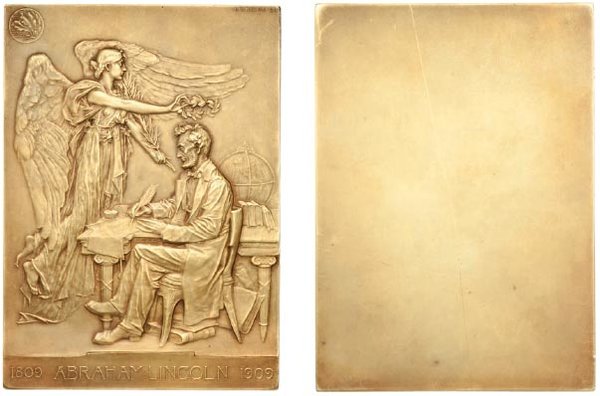
Abraham Lincoln centennial medal in gold (ANS 1909.325.1).
Obv.: Full-length seated portrait of Lincoln at a table, signing the Emancipation Proclamation while Fame is crowning him. The seal of the Society is in the upper left corner. Below, 1809 ABRAHAM ⁕ LINCOLN 1909; in upper right corner, signed J. E. ROINÉ SCP
Uniface
by J. Édouard Roiné; struck by Whitehead & Hoag, Medallic Art Co.
73 × 101 mm
Mintage
gold: 2
silver: 75
bronze: 100
These uniface plaquettes were originally struck by the Whitehead & Hoag Co.; restrikes by the Medallic Art Company were made in 1959. Silver strikes were originally sold for $10 and bronze for $5.
The gold specimen in the Society's collection bears no serial number. It was the gift of Archer Huntington on November 13, 1909 (ANS 1909.325.1). The second gold example was sold by Sotheby Parke Bernet on November 20, 1974 (Sotheby Parke Bernet 1974). Three silver examples bearing serial numbers 3, 4, and 40 are recorded as having been "junked" on September 24, 1918 (Medals ledger, ANS Archives). In addition to the 100 numbered bronze examples, a small number of additional plaquettes marked "sample" were produced for exhibition and sales purposes (letters, H. C. Page to Bauman L. Belden, April 17, 1914, August 5, 1914, ANS Archives).
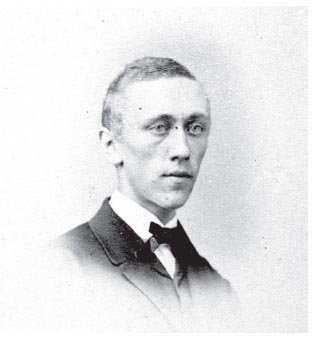
Robert Hewitt, Jr., c. 1866 (ANS Archives). Hewitt's involvement with the Society's medals spanned the decades from the Cleopatra's Needle medal in 1881 to the Lincoln Centennial medal in 1909.
Robert Hewitt, a prominent collector of Lincoln medals, joined the Society on February 22, 1866 and remained active until his death on October 6, 1913 (Proceedings 1914: 3). Shortly thereafter, Mrs. Hewitt donated his collection of Lincoln medals to the Smithsonian Institution. Among the 1,200 medals and plaques were silver, bronze, and lead examples of the Society's Lincoln Centennial plaquette (Smithsonian Institution 1919: 27). Based upon correspondence in the Society's archives, there may be some question as to the ownership of the lead strike.
In a letter to Bauman Belden dated August 5, 1914, Herman C. Page, manager of the Metal Sales Department at Whitehead & Hoag, responded to an earlier inquiry by Belden concerning the Lincoln plaquettes. Page related that he instructed Mrs. Hewitt to return the lead proof that he had loaned her husband. He also requested return of a bronze example marked "sample", and upon receipt both would be returned to the Society if desired. The lead proof, which bore Mr. Page's name on the reverse, was the first impression of the die and was lent to Mr. Hewitt for exhibition purposes only (letter, Page to Belden, August 5, 1914, ANS Archives). Later that month, Page again wrote to Belden, noting that Mrs. Hewitt informed him that Belden had given her the Society's permission to keep the sample plaquette and the lead proof with the collection, but that the plaques were to be returned to Whitehead & Hoag upon the disposal of the collection or Mrs. Hewitt's death (letter, Page to Belden, August 22, 1914, ANS Archives). Today, the lead proof resides in the collection of the Smithsonian Institution.
Page also referred to galvanos and plaster casts of this plaquette. It appears that several copies were made in each of these formats. He indicated that some of these had a different legend than the final version, suggesting that they had been made prior to Roiné's sale of the design to the Society (letter, Page to Belden, August 5, 1914, ANS Archives). One plaster cast is currently in the possession of the Society. According to Adelson, one of the galvanos was on display at the Society when he was writing his centennial history in 1958 (Adelson 1958: 183).
Although at least some medals were struck as early as 1909 (letter, Bauman Belden to Edward D. Adams, September 7, 1909, ANS Archives), neither this nor the New Theatre medal was offered for sale until 1916. According to the 1911 report of the Committee on the Publication of Medals, the Lincoln Centennial medal had already been prepared and would be offered to the members later that year (Committee on the Publication of Medals 1911: 15). There is no indication of the reason for the seven-year delay. It is possible, however, that the lackluster sales of the Catholic Diocese and Cleveland medals, coupled with the number of new medals waiting to be offered, was a consideration.
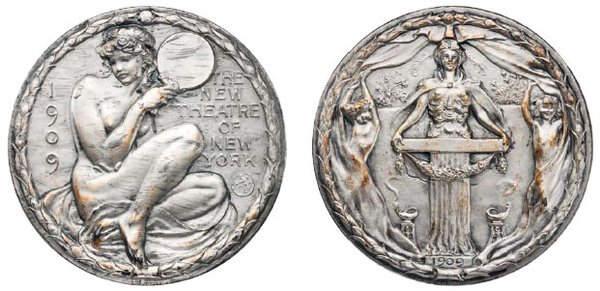
New Theatre of New York medal in silver, 77 mm (ANS 0000.999.56773).
Obv.: Seated nude female holding a mirror, floral wreath around. In left field, vertically, 1909; in right field, THE / NEW / THEATRE / OF / NEW / YORK / (seal of the Society); below wreath, signed B. L. Pratt.
Rev.: Standing female holding a tablet from which is suspended a garland; the curtain is drawn and held at each side by a nude child; below, on each side of the standing figure is an oil lamp, while at the bottom is the date 1909. Floral wreath around. Below wreath, signed B. L. Pratt
by Bela L. Pratt; struck by the Medallic Art Company
77 mm, 106 mm
Mintage
77 mm gold: at least 1
silver: 50
bronze: 50
bronze: 50
This medal was struck to commemorate the opening of the New Theatre on November 6, 1909. Dissatisfied with the current state of theater, a group of notable New Yorkers banded together to found the New Theatre, one that would reflect their sophisticated taste. Intended to be non-commercial in nature, with profits placed in an endowment fund, committees were to be appointed to approve various aspects of production, such as scenery and costumes.
Located at 62nd Street and Central Park West in a magnificent, Italian Renaissance building that cost $3,000,000, the theater opened with a performance of Shakespeare's Antony and Cleopatra. Unfortunately, the New Theatre never proved popular, having earned a reputation as being only for the wealthy, and survived for only two years. The building was then leased to another manager and renamed the Century Theater. In 1929 the building was demolished and replaced with the Century Apartments (Atkinson 1970: 123–124).
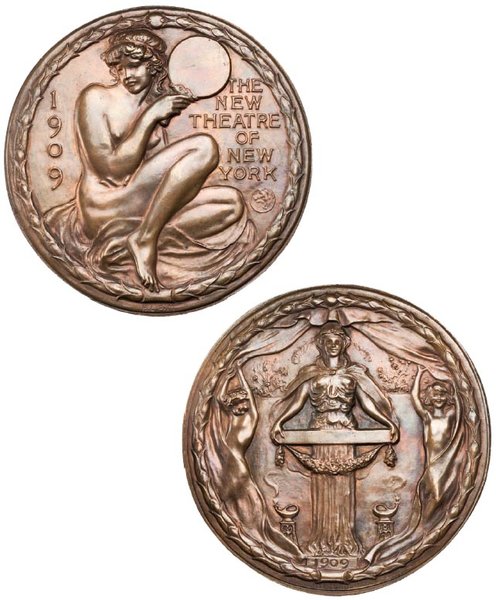
Large-size New Theatre of New York medal in bronze with untrimmed edge, 106 mm (ANS 0000.999.4402).
From its inception, the founders of the New Theatre intended to present medals regularly to individuals who made substantial contributions to the American theater. During its brief existence, the New Theatre awarded three such Founders' Medals, the recipients being Shakespearean scholar Horace Howard Furness, actress Ellen Terry, and New Theatre director Winthrop Ames. It appears that the Society's longtime benefactor, Archer Huntington, had a hand in all three gold medals presented by the New Theatre. However, only the medal given to Ellen Terry may be considered the same as the ANS issue.
On December 18, 1910, the founders of the New Theatre announced their intention to present a gold medal to Ellen Terry "in recognition of her distinguished services to dramatic art" ("Medal for Ellen Terry," New York Times, December 19, 1910). Presented on January 15, 1911 (Sam 1988: 179), this was was the second Founders' Medal to be awarded. The first was presented to Shakespearean scholar Dr. Horace Howard Furness on April 12, 1910, in Philadelphia.
According to Bauman Belden, the gold medal presented to Terry bore the same design as the one sold by the American Numismatic Society in commemoration of the opening of the New Theatre. Based only on this information, it would seem reasonable to believe that the gold medal contained an engraved inscription bearing Miss Terry's name, and possibly other information. While several contemporary accounts of the presentation include an illustration of the obverse of the medal, identical to that of the Furness medal ("Gold Medal for Ellen Terry", Boston Evening Record, December 30, 1910), experience has shown Belden's descriptions of the Society's medals to be very reliable. Thus, the gold medal presented to Ellen Terry almost certainly bore the design of the ANS issue.
There has never been any satisfactory explanation for the issuance of this medal in two sizes. The record in the ANS medals ledger for this issue is very sparse. The few sales noted are only for the 77-millimeter medal, with no mention at all of the larger version. The silver and bronze 77-millimeter medals were numbered 1 through 50 (Belden 1915: 57). Silver 77-millimeter medals were originally sold for $10 and bronze, regardless of size, for $5; they were struck by the Medallic Art Co. (Belden 1915: 57). In 1917, a number of medals were liquidated to help alleviate financial difficulties experienced by the Society (Adelson 1958: 204). According to Society records, five silver medals bearing serial numbers 4, 5, 6, 8, and 11 were "junked" on September 24, 1918. The large bronze medals were not numbered and are generally found untrimmed and without a finish, although an example with an old, trimmed edge was sold as lot 237 in Presidential Coin and Antique Company's Auction 83, June 23, 2013. During the 1970s, some of these large, untrimmed bronze medals were available through a well-known coin dealer, Charles McSorley. Others appearing on the market in the 1970s and 1980s were trimmed and given modern finishes. A silver example of the 106-millimeter medal was listed as number 3503 in the catalogue of medals from the ANS collection exhibited during the 1910 International Medallic Exhibition (American Numismatic Society 1910: 252). Despite this record, the Society's cabinet does not contain a specimen in silver, and neither Belden nor the Society's medals ledger makes any mention of one.
The issue date of the ANS New Theatre medal has raised questions for collectors for a number of years. Although it is dated 1909, there was a five-year gap between the presentation of the medal to Ellen Terry and the first recorded sale of the medal by the Society. In his 1977 Check List, Jeremiah Brady dated the New Theatre medal to 1917, commenting "usually dated 1909, but delivered in 1917". Another reason the record appears obscured is that for some of the years between 1909 and 1917 the ANS Proceedings did not include reports from the Committee on the Publication of Medals. Finally, the ANS medal sales ledger, which usually provides very specific information about mintage figures and dates of sales, provides little useful information about this medal. Fortunately, other sources help clarify the issue.
The New Theatre medal is recorded in the ANS medals ledger right after the Lincoln Centennial medal and before the Declaration of War medal, thus establishing the 1916 date of its entry into the ledger to be correct. However, not only was the gold medal presented to Ellen Terry in 1911, but Belden listed this medal in his 1915 book, noting that a number of medals in both sizes were still available (Belden 1915: 57). The dating of ANS medals in general is somewhat difficult during this period, as a number of medals are found where the earliest recorded date of distribution is at odds with the date on the medal and other documentation regarding production or stock on hand.
The catalogue of the medals in the Society's collection exhibited during the 1910 International Medallic Exhibition contains a section on medals issued by the Society. Entries 3501 through 3504 list bronze and silver 77-millimeter medals (3501), obverse and reverse dies for the 77-millimeter medal (3502), a silver 106-millimeter medal (3503), and obverse and reverse dies for the 106-millimeter medal (3504), establishing that the medals had been struck by that time.
In 1915, the Society published Bauman L. Belden's Medals and Publications of the American Numismatic Society, with an Historical Sketch (Belden 1915). This medal is listed among those for 1909, with the comment that it was struck to commemorate the opening of the New Theatre. After noting the presentation of a gold medal to Ellen Terry, Belden indicated that a number of 77-millimeter bronze and silver medals were still available, as well as 106-millimeter bronze examples; only the smaller medals were numbered.
Finally, there is in the ANS Archives a note dated December 28, 1909, from Archer Huntington to Bauman Belden, which makes
clear that the Society did little more than allow its seal to be placed on the medal.
It reads, "Herewith I enclose to you copy of a form of Resolution which should be carefully filed for future reference,
as it refers to
a matter which the Medal Committee will shortly have to consider." The enclosed resolution reads as follows:
Resolved:
That in view of the change of plan in the issuing of the New Theatre Medal and in the change of the form of the medal
itself, those
examples already struck of the original form be issued by the American Numismatic Society to its members or others;
it being
understood that, in consideration of the remuneration received by the American Numismatic Society through the sale
of these medals,
the New Theatre shall bear no further burden of expense, either for the cost of making the medals or dies. That the
dies shall be
deposited with the American Numismatic Society, and no further examples shall be struck without permission of the New
Theatre
(letter, Huntington to Belden, December 28, 1909, ANS Archives).
It would seem that the ANS issue may have been the original design and was intended to commemorate the opening of the New Theatre. These medals were struck sometime before December 28, 1909. In a letter to his mother dated January 25, 1909, Bela Pratt wrote that he had just received two orders for medals from Archer Huntington, including one for the New Theatre (letter, Bela Lyon Pratt to Sarah Whittlesey Pratt, January 25, 1909, Pratt letters 2011–12: letterid=1909-0125-BLP-SVWP). Nearly three months later, Pratt wrote again to his mother that he had shown photos of his design to Huntington, who said, "I consider it the very best medal ever made by an American sculptor, the best ever made in this country, and I have seen them all" (letter, Bela Lyon Pratt to Sarah Whittlesey Pratt, April 11, 1909, Pratt letters 2011–12: letterid=1909-0411-BLP-SVWP). Finally, in another letter to his mother dated October 3, 1909, Pratt mentioned that Huntington wanted changes made to the New Theatre medal including removal of the central figure on the reverse (letter, Bela Lyon Pratt to Sarah Whittlesey Pratt, October 3, 1909, Pratt letters 2011– 12: letterid=1909-1003-BLP-SVWP).
Based on Huntington's description of the ANS medal as the original design and Pratt's account of the changes requested in October, it would appear that the Furness version was reworked from the original design. However, until the medal presented to Ellen Terry is located, we will not be certain whether she actually did receive a gold example with the first, commemorative design.
The first Founders' Medal was presented to Shakespearean scholar Horace Howard Furness on April 12, 1910, in Philadelphia. Although it was intended to award the medal to Furness at the opening of the New Theatre, this could not be done due to his health at the time ("Dr. Furness Gets a Medal," New York Times, April 13, 1910). In discussing the presentation of the medal to Furness, Winthrop Ames noted Furness's work as an editor of Shakespeare's plays as the reason he was chosen to be the "first recipient of the first medal the New Theatre would present to those who have contributed to the dramatic art in this country" ("New Theatre Gives First Honor Medal to Dr. H. H. Furness," New York Times, April 24, 1910). The Furness medal is currently located with the Furness Family Papers at the University of Pennsylvania. Based on the similarity of design as well as the Huntington letter, it seems that the medal presented to Furness was a slightly reworked version of the one issued by the ANS:
Obv.: Seated nude female holding a mirror, floral wreath around. In right field, THE / NEW / THEATRE
Rev.: A nude child on either side of the medal holds open the curtain of a stage, revealing a ten-line inscription, all within a floral wreath: PRESENTED TO / HORACE H. FURNESS / — 1909 — / BY THE FOUNDERS OF / THE NEW THEATRE / IN RECOGNITION OF HIS / DISTINGUISHED SERVICES / TO DRAMATIC ART / — IN — / AMERICA
Winthrop Ames, the managing director of the New Theatre, was presented with a gold Founders' Medal at a meeting of the founders on November 4, 1909. The presentation was made by William K. Vanderbilt following the unanimous adoption of a resolution reading, "Resolved, that Mr. Vanderbilt, on behalf of the founders present to Mr Ames a Founders Medal of the New Theatre in recognition of the energy, perseverance, tact, skill, and painstaking efforts displayed by him in the midst of many difficulties surrounding the building and opening of the theatre" ("Winthrop Ames Honored," New York Times, November 5, 1909).
This was an entirely different design from the Bela Pratt medal issued by the Society. The Founders' Medal presented to Ames was an 89-millimeter medal designed by Gutzon Borglum. An example of this medal was exhibited in the 1910 International Exhibition of Contemporary Medals along with a plaster model (described in the catalogue as having been presented in 1910; Baldwin 1911: 15). A 16½-inch bronze cast of the obverse was sold by Stack's in its Philadelphia Americana Sale of September 23, 2009. Although Borglum's New Theatre medal had no connection with the ANS, Archer Huntington gave the dies to the Society. A full account of this medal and a related marble relief at the American Numismatic Society was published in the Winter 2009 issue of the ANS Magazine (Silberberg 2009).
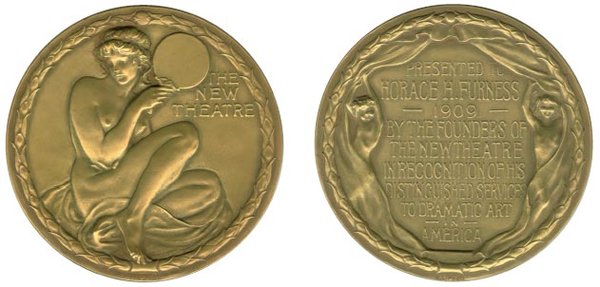
New Theatre Founders' Medal in gold, presented to Horace H. Furness (courtesy of the University of Pennsylvania Library).
This medal, issued in gold, gold-plated bronze, and silvered white metal, can be described as follows:
Obv.: Rear view of a standing nude female holding the masks of Comedy and Tragedy. In fields, THE / WORLD / A / STAGE / THE / STAGE / A / WORLD
Rev.: A partially opened curtain, though which can be seen the performance of a play. Across upper part of design, THE / NEW THEATRE; in exergue, PRESENTED BY THE FOUNDERS TO / WINTHROP AMES / NOVEMBER / 1909.

The New Theatre medal by Gutzon Borglum, not issued by the ANS, in silver-plated white metal (ANS 2009.33.1).
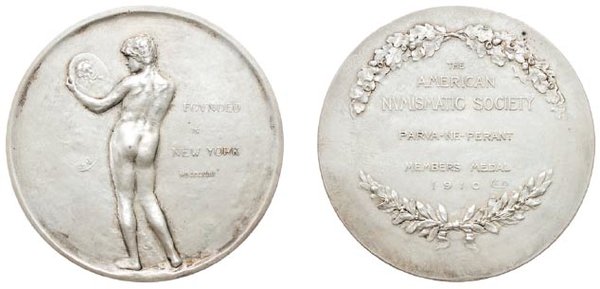
The 1910 Membership medal in silver, showing the rejected reverse die with a spelling error in "pereant" (ANS 1913.6.1).
Obv.: Nude male, standing with his back to the spectator, examining a portrait medallion which he is holding. In right field, FOVNDED / IN / NEW YORK / MDCCCLVIII; in left field, signed .G.B
Rev.: A wreath of oak branches and one of laurel below. A space is left below the laurel wreath for engraving the name and year of election of the member. In the center, a six-line inscription: THE / AMERICAN / NVMISMATIC / SOCIETY / PARVANE-PERANT / MEMBERS MEDAL / 1910; signed .G.B
by Gutzon Borglum; struck by Tiffany & Co.
77 mm
Mintage
silver: unknown
bronze: unknown
In 1907 the name of the Society was changed back from the American Numismatic and Archaeological Society to the American Numismatic Society. As a result of this change in name and the resulting change in seal, it was felt that a new membership medal was warranted (Adelson 1958: 184). This first version of the second member's medal is remarkable in that the Society's motto was misspelled "Parva Ne Perant" instead of "Parva Ne Pereant". All examples so far examined do not have a member's engraved name. It would therefore appear that the error was noticed before any examples were sold. A silver specimen can be found in the Society's collection (ANS 1913.6.1), donated by J. Sanford Saltus.

The 1910 Membership medal in silver, with the corrected reverse die used for the medals sold to members (ANS 0000.999.4387).
Obv.: Nude male, standing with his back to the spectator, examining a portrait medallion which he is holding. In right field, FOVNDED / IN / NEW YORK / MDCCCLVIII; in left field, signed .G.B
Rev.: A wreath of oak branches above and one of laurel below. A space is left below the laurel wreath for engraving the name and year of election of the member. In the center, a six-line inscription: THE / AMERICAN / NVMISMATIC / SOCIETY / PARVANE-PEREANT / MEMBER'S MEDAL / 1910
by Gutzon Borglum; struck by Tiffany & Co., Medallic Art Co.
77 mm
Mintage
gold: unknown
silver: unknown
bronze: unknown
This version of the second membership medal bears a modified reverse displaying the correct motto, PARVA NE PEREANT. The corrected reverse die also modified the word "members" by the addition of an apostrophe and no longer bears the initials of the sculptor, Gutzon Borglum. The dies and earliest strikings are by Tiffany & Co.; later strikings were authorized as needed to supply specimens for members and were struck by the Medallic Art Company. Silver specimens were originally priced at $8 and bronze at $4; the prices included engraving the name and year of election of the member. The dies were the gift of J. Sanford Saltus (Adelson 1958: 184). Because additional medals were ordered at various times as needed, these medals can be found with a variety of maker's edge stamps.
Gold membership medals have occasionally been presented to individuals as special marks of favor. In 1913 Samuel Avery, Jr., offered the sum of $2,500 towards a fund intended to increase the Society's collection, provided three other donors would contribute a similar amount. Unfortunately, only two other donors came forward—Archer M. Huntington and J. Sanford Saltus. Avery agreed to alter his terms so that the fourth donation of $2,500 could be made up of a number of smaller donations, and also allowed the fund to be started with only three donors. For his generosity, Avery was presented with a gold membership medal (Adelson 1958: 193).

The silver membership medal of Edward T. Newell, who was elected to membership in the ANS in 1905 (ANS 1968.44.3).
Another gold membership medal was presented to Queen Elisabeth of Belgium in 1919. In that year Albert I and Elisabeth of Belgium became the first king and queen to visit the United States. 4
Silver membership medals have also been presented on occasion, such as that presented to Isaac Greenwood shortly before his death in 1911. He was, at the time, the Society's oldest member, and that was the reason for the presentation. Greenwood joined the Society in 1859 and served as Second Vice-President from July 28, 1864, until March 22, 1866. Also in 1911, Greenwood gave the Society his collection of more than 3,000 coins, medals and banknotes, as well as his numismatic books (Adelson 1958: 192).
There is a single gold-plated bronze specimen in the Society's cabinet (ANS 1967.30.3), bearing the name of Gilbert S. Perez. It is not clear if this medal was originally struck in gilt, or if the plating was applied afterwards.
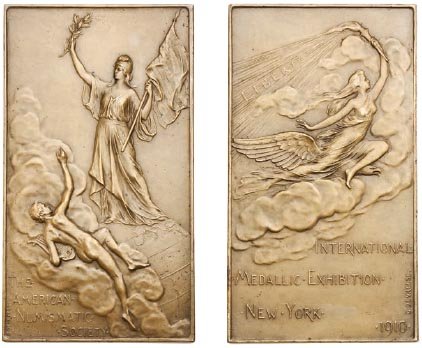
International Medallic Exhibition medal in bronze (ANS 0000.999.4010).
Obv.: Columbia, standing on a globe, holding a laurel branch in her right hand and a flag in her left, faces a nude male with lyre rising upward on a cloud. At lower left,·THE·/·AMERICAN·/·NUMISMATIC· /·SOCIETY ·; signed G. DEVREESE.
Rev.: Draped female, holding the torch of Liberty, borne through the clouds on an eagle. Below, · INTERNATIONAL·/·MEDALLIC·EXHIBITION·/ · NEW·YORK ·; at lower right,·1910 ·; signed G. DEVREESE.
by Godefroid Devreese; struck by Alphonse Michaux
50 × 89 mm
Mintage
gold uniface: 2
bronze: 2
bronze uniface: unknown
This medal was produced as a result of the Society's 1910 International Exhibition of Contemporary Medals. It was decided to award the commission of a commemorative medal to the medalist with the best exhibit, and Godefroid Devreese was awarded that honor. The artist sent his finished dies to New York in time for them to be exhibited at the 1912 annual meeting (Adelson 1958: 184). According to Society records, only one bronze example was struck for its cabinet (ANS 0000.999.4010). In addition, one two-sided and several uniface artist's proofs were produced by A. Michaux (De Witte 1911–12: no. 98).
The reason for not striking additional examples for sale to members is not clear. In his listing, de Witte noted that examples would be struck for sale by the Society. In a 1913 letter to John Waterbury, the new chairman of the Committee on the Publication of Medals, explaining the status of various medals in progress, Bauman Belden wrote, "The Council has also authorized the striking of the medal by Devreese for the International Medallic Exhibition for 1910 with the idea of offering it for subscription in the early fall. We have here the dies for this medal. One example was struck before the dies were sent to us, and that example we have. No other medals have, so far, been struck" (letter, Belden to Waterbury, April 16, 1913, ANS Archives).
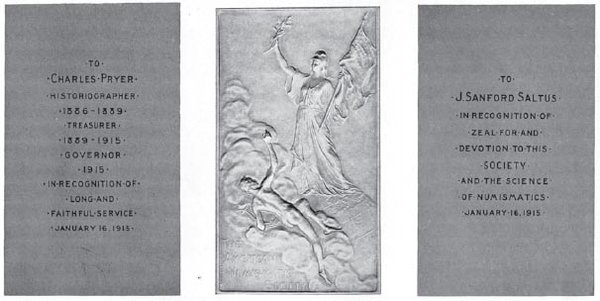
Plate from the Society's Proceedings for 1915, showing the inscribed medals for Pryer and Saltus (Proceedings 1915: frontispiece).
Based on this correspondence, it would appear that the Council did intend to strike examples of this medal for the membership. The Council also discussed using one side of this medal as the obverse for the Saltus Award, but that idea was eventually rejected (Adelson 1958: 185). While the reasons may never be known, it is possible that this medal was simply caught up with the same issues that caused a delay in issuing the New Theatre and Lincoln Centennial medals.
Although never offered for sale, Devreese's medal was used as an award by the Society. At least two uniface gold examples
were struck
utilizing the obverse die and bearing inscriptions on the reverse. They were presented to retiring Treasurer Charles
Pryer and to J. Sanford Saltus at the Society's annual meeting on January 16, 1915 (Proceedings
1915: 28). The medal awarded to Charles Pryer bore the inscription: ·TO· ·CHARLES·PRYER· ·HISTORIOGRAPHER· ·1886 - 1889· ·TREASURER· ·1889 - 1915· ·GOVERNOR· ·1915· ·IN·RECOGNITION·OF·
·LONG·AND· ·FAITHFUL·SERVICE· ·JANUARY 16. 1915 ·
The medal presented to J. Sanford Saltus carries the inscription: ·TO· ·J. SANFORD
SALTUS· ·IN·RECOGNITION·OF· ·ZEAL·FOR·AND· ·DEVOTION·TO·THIS· ·SOCIETY· ·AND·THE·SCIENCE· ·OF·NUMISMATICS· ·JANUARY·16.
1915 ·

Ernest Babelon medal in bronze (ANS 1956.177.1).
Obv.: Bust of Babelon, left. Around, ERNEST·BABELON· ·DE·L'INSTITUT ·; in the field to the right of the bust, signed G. DEVREESE. / 1910
Rev.: Helmeted bust of Athena, left, holding a spear in her right hand and in her left a shield, the top of which bears a portion of the Panathenaic festival procession. Around, CONGRES INTERN·DE NUM·ET D'ART DE LA MED·BRUXELLES 1910 ·; in the field behind Athena's head, signed R. BOSSELT
by Godefroid Devreese (obverse) and Rudolf Bosselt (reverse); struck by Alphonse Michaux
65 mm
Mintage
silver: 156
bronze: 505
This medal was issued jointly by the American Numismatic Society and the Société Hollandaise-Belge des Amis de la Médaille d'Art. The generally quoted mintage figures relate only to those produced for the American Numismatic Society. One hundred silver and two hundred bronze medals were struck for the Society, which offered them for sale at $10 and $5, respectively. When adding those struck for the Société Hollandaise-Belge, a much larger figure would emerge; the mintage figures given are taken from de Witte's monograph on Devreese and appear to be more accurate (De Witte 1911–12: no. 96). In 1984 a hoard of 100 bronze medals was found in the Society holdings and offered to its members at $25. The bronze medals were issued in light blue, circular card boxes.
The obverse design, by Devreese, was created as a large model and reduced by the Janvier reducing machine; the reverse was engraved directly into a steel die by Bosselt. The medal commemorates the International Numismatic Congress held in Brussels in 1910.
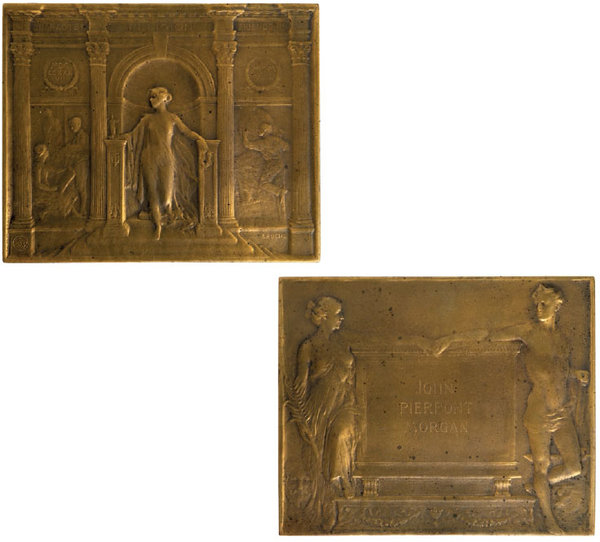
J. Pierpont Morgan memorial medal in bronze (ANS 0000.999.4395).
Obv.: Façade of a building with four columns. In the center, a female figure representing Art descends a flight of stairs; in her right hand is a statuette, and in her left a laurel wreath. On either side are representations of Painting and Sculpture. Above, under the pediment, are the words CHARACTER RELIGION FRIENDSHIP; immediately below, within wreaths, are the dates MDC / CCXXX / VII and MCM / XIII; at lower left, the Society's seal; at lower right, signed E. FUCHS
Rev.: A tablet inscribed JOHN / PIERPONT / MORGAN; on either side is a standing figure: a draped female holding a palm branch, representing Fame, and a nude male with a sledge hammer and anvil, representing Industry.
by Emil Fuchs; struck by Whitehead & Hoag
90 × 74 mm
Mintage
gold: 1
silver: 100
bronze: 200
Several unadopted patterns exist for this medal. The Society has in its collection a bronze example with no inscription on the reverse tablet. On the obverse, the inscription under the pediment reads ARTIFICVM·VICT ORIAE·FRVCTVI· POSTERITAT IS·REPORTANTVR; below, within the wreaths, are AÑO / DOMI / NI and M / DCCCC / XI (ANS 0000.999.4393). Another version exists as an electrotype with a similar obverse but with the full date M / DCCCC / XI and a reverse inscription within the tablet reading IOHANNI·PIERPONT / MORGAN·TOT·BENE~ / FICIORVM·IN·MVSEVM / METROPOLITANVM·NOVI / EBORACI· COLLATORVM / MONVMENTVM (private collection).

Silver electrotype of an unadopted design for the J. Pierpont Morgan medal, dated 1911 and referring to Morgan as a benefactor to the Metropolitan Museum of Art (private collection).
This medal was issued to commemorate the recently deceased "John Pierpont Morgan and his influence upon the art development of this country" (Committee on the Publication of Medals 1914: 12). The original intent was to issue this medal during Morgan's lifetime, probably with the inscription referencing the Metropolitan Museum and without any involvement by the Society. However, in his letter to John Waterbury in 1913, Bauman Belden wrote, "While Mr. Huntington did not originally intend that this medal should be issued by our Society, he suggested at the last Council meeting that in view of Mr. Morgan's death it might be well for the Society to issue this as a commemorative medal, and to issue it as promptly as possible. This would, of course, necessitate a change in the original inscription, and I find that this can be done by softening the dies and engraving the inscription upon them" (letter, Belden to Waterbury, April 16, 1913, ANS Archives).
The silver and bronze medals were offered for sale in a circular dated November 14, 1913, priced at $10 and $5, respectively (untitled circular advertising the John Pierpont Morgan medal, November 14, 1913, ANS Archives). The silver medals were housed in white card boxes with blue trim and watered tops bearing fleurs-de-lys, while the bronze were housed in plain white boxes. The sole gold medal was presented to the Morgan family (Committee on the Publication of Medals 1914: 12). Currently in the collection of the Morgan Library, the 10-karat gold medal is housed in a black leather case with white silk and cream velvet lining (Morgan Library ARC 1158.01).
Morgan became a life member of the Society on April 24, 1902, and was elected an honorary member on January 21, 1911 (Proceedings 1911: 8).
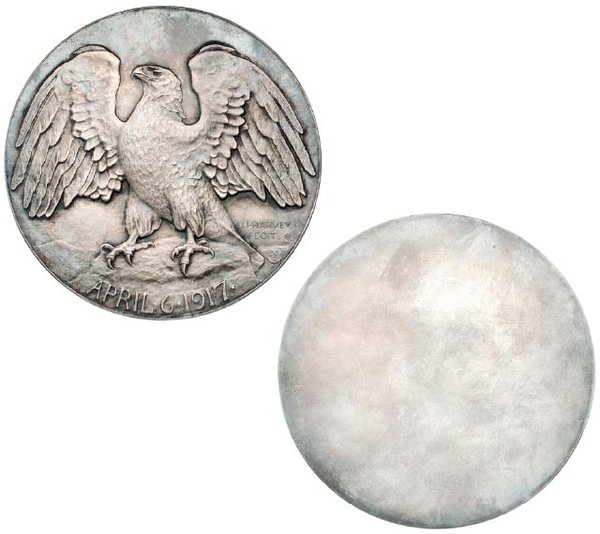
Declaration of War medal, uniface production strike in silver (ANS 1961.37.24).
Obv.: A bald eagle with outstretched wings, perched on a rock bearing the date APRIL · 6 · 1917 ·; to the right, below the eagle's wing, are the Society's seal and the artist's name, ELI · HARVEY / FECIT. ©
Uniface
by Eli Harvey; struck by the Medallic Art Co.
90 mm
Mintage
gold: 1
silver: 50
bronze: 113 (including some examples of no. 32)
The idea for this medal originated with Edward D. Adams, who paid the cost of the dies. The design concept itself originated with Secretary of the Treasury William G. McAdoo. It was originally conceived as a smaller medal, to be suspended from a bar and issued in connection with the "Liberty Loans". The medal was to have been available for purchase only by subscribers to the loan, with different bars to indicate the varying loans. This plan was abandoned due to the lack of government sanction for the project, and the small medal was replaced with a larger version (Committee on the Publication of Medals 1918: 25).
Although first designed as two-sided, this was ultimately issued as a uniface medal. According to the Committee on the Publication of Medals, the date of the declaration of war would suffice, along with the "fighting attitude of our national bird … to convey in symbol the spirit with which our country has entered the conflict" (Committee on the Publication of Medals 1918: 25).
Eli Harvey's model for the eagle was approved by William T. Hornaday, Director of the New York Zoological Park. The medal's design was used by the Bankers Trust Company in their Third Liberty Loan Circular, with a large bronze plaque on display at the company's office (Adelson 1958: 216).
Examples of this medal were presented to General Pershing, Secretary of the Navy Daniels, and other dignitaries (Adelson 1958: 215). Additional bronze medals were presented to the Metropolitan Museum of Art, the American Museum of Natural History, and the Library of Congress (Committee on the Publication of Medals 1918: 25).
The single gold specimen was sold to J. P. Morgan, Jr., and currently resides in the Morgan Library (Stahl 1992: 30). It does not bear any edge marks and is housed in a dark blue leather box stamped Medallic Art Co., with a white silk and cream-colored velvet lining (Morgan Library ARC 1157.002). In addition to the 113 numbered bronze examples, one unnumbered bronze example was also listed in the ANS medals ledger.
This medal was offered for sale in a circular dated August 30, 1917. Subscriptions were to be received only until September 29, 1917, with maximum mintages of 250 bronze and 50 silver. Issue prices were $10 for bronze and $20 for silver examples (untitled circular for the Declaration of War medal, August 30, 1917, ANS Archives).
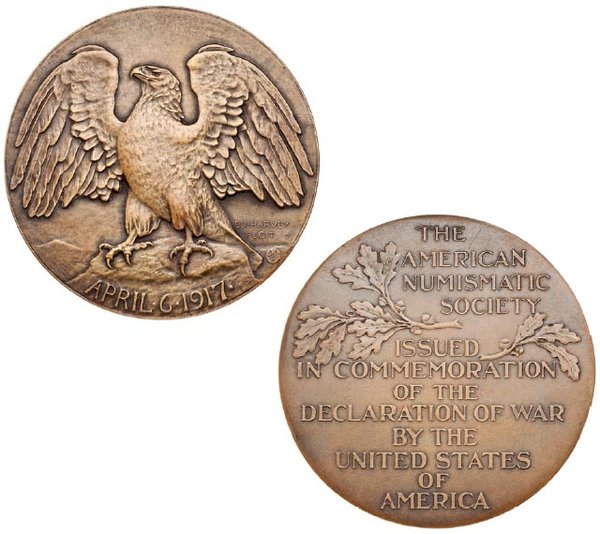
Two-sided trial strike of Declaration of War medal in bronze (ANS 1992.155.1).
Obv.: A bald eagle with outstretched wings, perched on a rock bearing the date APRIL · 6 · 1917 ·; to the right, below the eagle's wing, are the Society's seal and the artist's name, ELI · HARVEY / FECIT. ©
Rev.: Two oak branches and a twelve-line inscription: THE / AMERICAN / NUMISMATIC / SOCIETY / ISSUED / IN COMMEMORATION / OF THE / DECLARATION OF WAR / BY THE / UNITED STATES / OF / AMERICA
by Eli Harvey; struck by Medallic Art Co.
90 mm
Mintage
included in the mintage for no. 31; at least 2 bronze known
In recent years, two specimens of the Declaration of War medal have surfaced that bear impressions from the reverse die. The first was purchased by the Society in 1992. The second, which is holed, was sold in a Presidential Coin & Antique Co. auction (PCAC 66, lot 438).
The first was described in the section on medals of the 1992 annual report of the ANS. Alan Stahl proposed there that it was a trial piece and that after examination, "a committee … felt that the reverse was redundant and detracted from the whole medal" (Stahl 1992: 30). The trial was then mixed up with the entire order. This medal (serial number 69; ANS 1992.155.1) was one of eleven examples ordered by John Waterbury, president of the Manhattan Trust Co. (Stahl 1992: 30).
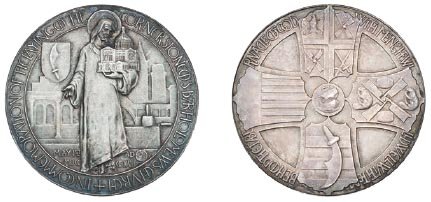
St. Bartholomew's Church medal in silver (ANS 0000.999.4408).
Obv.: St. Bartholomew standing in front of a cityscape, holding a model of the church. To his right is a shield bearing a flaying knife; at his feet are the date MAY 1ST AD / MDCC CCXVII and the seal of the Society. Around, †IN COMMEMORATION OF THE LAYING OF THE CORNERSTONE OF S·BARTHOLOMEWS CHVRCH
Rev.: A cruciform composed of the shields with the arms of the Episcopal Diocese of New York, St. Bartholomew's Church, New York City, and the United States; in the center is a roundel bearing a sailing vessel. Around, BEHOLD THE TABERNACLE OF GOD WITH MEN & HE WILL DWELL WITH THEM
Designed by Bertram Goodhue, modeled by Attillio Piccirilli; struck by Medallic Art Co.
51 and 38 mm
Mintage
51 mm gold: 3
silver: 11?
bronze: unknown
38 mm bronze: unknown
The cornerstone of St. Bartholomew's Church, on Park Avenue and 51st Street, New York City, was laid on May 1, 1917. Although the Society did not actually distribute this medal at all, it was issued under its auspices based on the suggestion of William B. Osgood Field, a member of the Society's Board of Governors and one of the vestrymen of St. Bartholomew's Church (Adelson 1958: 216).
Three gold medals were struck. One was placed in the cornerstone of the building, a second was retained by St. Bartholomew's, and the third was presented to Bishop David Greer. As this last medal has since been returned to St. Bartholomew's Church, all three are currently in its possession. A limited number of 51-millimeter silver medals were presented to members of the vestry, the church's governing council. The 38-millimeter bronze examples were given to those individuals who made contributions toward the cost of the building. The model of the building as depicted on the obverse is that which was originally envisioned by the architect, Bertram Goodhue (Percy Preston, archivist of St. Bartholomew's Church, personal communication, February 19, 2008).
In May 1917, Field wrote to the Society's President, Edward Newell, that the church planned to have two gold and eleven silver medals struck. With regard to the bronze medals, Field mentioned that 2,000 bronze medals would be required for distribution to all who made a contribution towards the building. He proposed to use the smaller size of 1½ inches in order to reduce costs (letter, Field to Newell, May 9, 1917, ANS Archives).
As for the Society, Field believed the Society should receive one example of each kind struck. Moreover, he asked Newell if anyone else would like to order a gold medal, and that if any extras were ordered, he would like one each in gold and silver (letter, Field to Newell, May 17, 1917, ANS Archives). Despite these intentions, by January 1918, Sydney Noe wrote to Field asking whether or not the medal had been issued. He noted that permission to use the Society's seal was conditioned upon some acknowledgment to the Society and that some medals be given to them. As of then, they had not received any medals and had been unable to obtain any information about them, though Robert Eidlitz believed the medals had already been issued (letter, Noe to Field, January 9, 1918, ANS Archives). On March 25, 1918, the Society finally received one of the large silver medals from the rector of St. Bartholomew's.
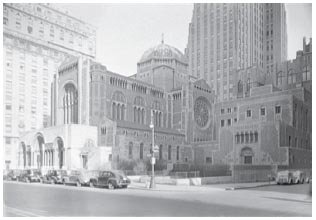
(Above) St. Bartholomew's Church, 1941 (Gottscho-Schleisner collection, Library of Congress, LC-G612-T-39250).

(Below) The 38 mm bronze St. Bartholomew's Church medal issued to donors by the church (ANS 0000.999.4412).
Based on the available information, it appears that of the 51-millimeter medal, three gold, at least eleven silver, and a small number of bronze medals were struck. In addition, around 2000 38-millimeter bronze medals were struck for distribution to those who made donations towards the church building. None were offered for sale.

French and British War Commissions medal in bronze (ANS 1933.64.38).
Obv.: Head of Victory, right, wearing a helmet to which are attached a sprig of oak, a lily, and a cluster of pine needles, emblematic of England, France and the United States. Around, TO COMMEMORATE THE VISIT TO NEW YORK OF THE FRENCH AND BRITISH WAR COMMISSIONS 1917; on Victory's collar, signed D C FRENCH
Rev.: France, represented by an armored figure of Joan of Arc, and chivalrous England, represented by a medieval knight, seek the aid of American Liberty. At lower right, signed E. B. LONGMAN / SC. 1917
Obv. by Daniel Chester French, rev. by Evelyn B. Longman; struck by the Medallic Art Co.
63 mm
Mintage
gold: 5
silver: 109
bronze: 171
After the United States entered World War I in 1917, the Allied powers sent commissions to begin military coordination. The first to arrive were the French and British commissions, and New York City's mayor, John Purroy Mitchel, organized a tremendous welcome. According to the Society's Proceedings for 1919, this medal was issued at the request of Mayor Mitchel's Committee of Reception, and was the second civic medal with which the Society was associated (Committee on the Publication of Medals 1919: 19).
The French and British commissions came to New York from
May 9 to 12, 1917. On May 7, Mayor Mitchel issued a proclamation as follows: To the Citizens of New York:
The French Special Mission to the United
States and the British Special Mission to the United States will
honor the City of New York by their presence as its guests between the 9th and 12th days of May. Their
coming will emphasize the alliance of the United States with the other free peoples of the world in
declaring war against the Imperial Government of Germany in the defense of liberty and
democracy.
Wherefore I, John Purroy Mitchel, Mayor of the City of New
York, do hereby direct that during the visit of these guests of the City of New York the flags
of France and of Great Britain shall be displayed upon
all public buildings in the city, and I call upon all inhabitants of the city appropriately to decorate and illuminate
their
buildings and display therefrom beside the flag of the United States the emblems of France, Great Britain, and the
other nations allied with us "to make the world safe for
democracy" (quoted from "City, in Tricolor, Waits for Envoys,"
New York Times
, May
8, 1917).
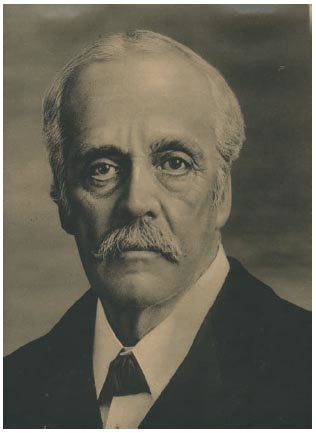
Foreign Secretary Arthur J. Balfour, head of the British Commission, 1917 (New York Times mid-week pictorial supplement, May 17, 1917).
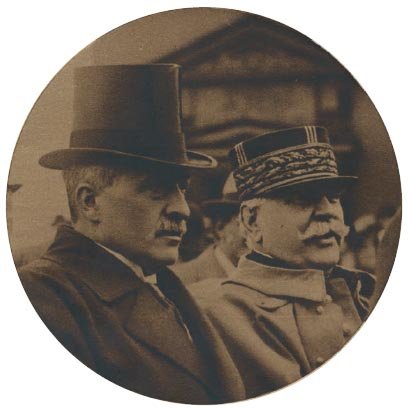
Minister of Justice René Viviani and Marshal Joseph Joffre of the French Commission arriving in New York City on May 9, 1917 (New York Times midweek pictorial supplement, May 17, 1917).
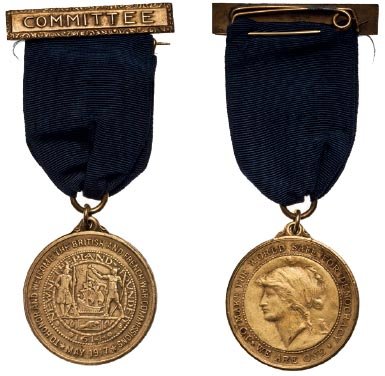
Badge issued to members of the mayor's Committee of Reception to welcome the French and British War Commissions, 1917 (ANS 1917.121.1).
Among the highlights of the visits were the French Commission's visit to Brooklyn for the unveiling of a statue of Lafayette in Prospect Park and trips to Grant's Tomb, Washington's headquarters at Newburgh, and West Point ("City, in Tricolor, Waits for Envoys," New York Times, May 8, 1917).
The five gold medals were presented to former Prime Minister René Viviani and Marshal Joseph Joffre of the French Commission, Foreign Secretary Arthur Balfour and Lieutenant General G. T. M. Bridges of the British Commission, and former Mayor Mitchel (Adelson 1958: 217). The silver and bronze examples were offered for sale at $10 and $5 respectively (Richman 1988: 143).
The documentary evidence for the mintage figures are a bit ambiguous. According to the ANS medals ledger, 5 gold, 106 silver, and 127 bronze medals were distributed. However, the report of the Committee on the Publication of Medals included in the proceedings of the annual meeting in 1919 indicates the figures struck to have been 5 gold, 109 silver, and 171 bronze (Committee on the Publication of Medals 1919: 19).

Catskill Aqueduct medal, 76 mm, in bronze (ANS 0000.999.20936).
Obv.: Female head symbolic of the City of New York facing right. Beaded rim.
Rev.: Nude youth holding a vase from which pours the life-giving water of the new aqueduct. In the background are the Catskill Mountains, source of the aqueduct's waters. To left and right of figure, TO COMMEMORATE THE COMPLETION / OF THE CATSKILL AQUEDUCT / AN ACHIEVEMENT OF CIVIC SPIRIT / SCIENTIFIC GENIUS AND FAITHFUL LABOR / 1905 NEW YORK 1917
Obv. by Daniel Chester French, rev. by Daniel Chester French and Augustus Lukeman; cast by the Medallic Art Co.
76 mm
Mintage
silver: 23
bronze: 76
The obverse of the Catskill Aqueduct medal was designed and modeled by Daniel Chester French, while the reverse was a collaboration between French and Augustus Lukeman. The two worked on the design together, with Lukeman responsible for its execution (Richman 1988: 145–147). Prices at the time of issue for members of the Society were $25 for silver and $7 for bronze. Although authorization was given for production of a gold medal for J. P. Morgan's collection, there is no evidence that such a medal was made (Hall 1918: 903).
The circular announcing publication of this medal was issued by the Mayor's Catskill Aqueduct Celebration Committee, rather than by the ANS. Ten silver and six bronze medals were presented to certain individuals associated with the aqueduct. The committee that oversaw the medal consisted of Robert W. de Forest, Edward Hagaman Hall, Edward T. Newell, John B. Pine, and Arthur Williams.
Unlike most other medals published by or with the approval of the Society, its seal is not included in the design. The publication circular does not indicate any mention of the Society except as recipient of payment for the medals. Finally, examination of the Society's medal sale ledger reveals the following notation for this medal: "Not issued by this Society — and we disposed of 13 silver and 70 bronze copies" (Medals ledger, p. 54, ANS Archives).
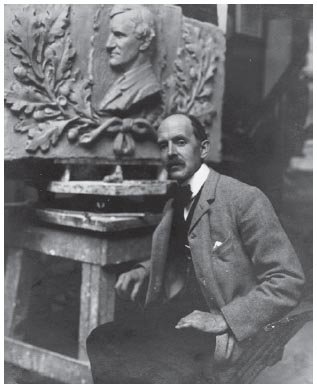
Daniel Chester French in his studio, with the model for the plaque for the Frances Parkman Monument, c. 1905 (author's collection).
Despite the evidence cited, this medal has, by tradition, been included with those published by the Society. While that alone would not be sufficient to consider this an ANS medal, the report by the Committee on the Publication of Medals in the 1918 Proceedings indicates that the Society did, in fact, authorize this medal at the request of Robert W. de Forest (Committee on the Publication of Medals 1918: 25). It is for this reason that the medal is included as an issue of the American Numismatic Society.
Robert W. de Forest, chairman of the Catskill Aqueduct Medal sub-committee, was also President of the Metropolitan Museum of Art's Board of Trustees. He presented to the museum three examples, one of silver and two of bronze in different colors (Richman 1988 145–147). Nine of the ten silver medals allocated to the Mayor's Catskill Aqueduct Celebration Committee were presented to the following:
The tenth silver medal was collectively presented to all the assistant engineers, contractors, workmen, and other individuals whose work contributed to the successful completion of the aqueduct. This medal was placed in the custody of the American Society of Civil Engineers and bore on its edge the inscription TO ALL WHO HAVE CONTRIBUTED BY THEIR VISION, GENIUS, LOYALTY AND LABOR (Hall 1918: 903–904).
In addition to the 3-inch cast medals, the Medallic Art Company struck 2000 38-millimeter bronze medals bearing the same design. These should not be considered as having any connection with the ANS. Of the 2000 small bronze medals struck, two were given to each of 600 schools for presentation to students for the best essay on the subject of the aqueduct. About 750 were sent to members of the Mayor's Committee who were each charged $1.00 for the medal, while a few were sold to other interested individuals (Hall 1918: 909).

The 38 mm Catskill Aqueduct medal in bronze, issued by the Mayor's Catskill Aqueduct Celebration Committee (ANS 1985.81.205).
The 38-millimeter obverse die was also used in 1932 to strike a small medal in memory of Daniel Chester French. The reverse of that bronze medal bears an eight-line inscription: A / TOKEN IN / REMEMBRANCE OF / DANIEL CHESTER FRENCH / NATIONAL SCULPTURE SOCIETY / FEBRUARY 10, 1932 / MEDALLIC ART COMPANY / NEW YORK. In 1931, the Medallic Art Company adopted the female head depicted on the obverse as their logo, a symbol that is still in use today (Johnson n.d.: slide 20).
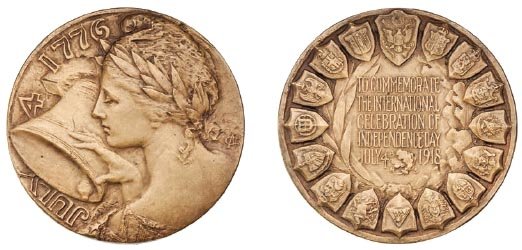
Independence Day medal in bronze (ANS 1919.179.1).
Obv.: Allegorical female lightly touching the Liberty Bell. Around, JULY 4 1776; at right, signed with AGN monogram.
Rev.: Five-line inscription within a circle of shields bearing the arms of the sixteen countries participating in the celebration: TO COMMEMORATE / THE INTERNATIONAL / CELEBRATION OF / INDEPENDENCE DAY / JULY 4 (oak leaf) 1918
by Allen G. Newman; struck by the Medallic Art Co.
63 mm
Mintage
silver: 39
bronze: 63
Issued in 1919, this medal was struck at the suggestion of Robert Eidlitz to mark the international celebration of the Fourth of July the previous year (Adelson 1958: 217). Among the nations participating in this celebration were the sixteen whose shields can be seen on the reverse: the United Kingdom, Belgium, Greece, Brazil, Chile, Uruguay, Argentina, Nicaragua, Guatemala, Peru, Cuba, Portugal, Serbia, Italy, and France, as well as the United States.
After inquiries were made of three or four sculptors regarding designs for this medal as well as their ability to work within the required schedule, the commission was given to Allen G. Newman. Subscription for this medal was limited to members of the Society and members of the Mayor's Committee on National Defense, with prices fixed at $10 for silver and $5 for bronze ("Independence Day Medal," circular, June 28, 1919, ANS Archives).
In an undated letter to Sydney Noe, Allen Newman described his original, unadopted sketch: "The Liberty Bell was selected as a motif as it lends itself to the idea of a celebration. Putting it in the arm of Mercury, the Herald of the Gods, with his staff denoting peaceful intercourse suggests that the celebration is universal. As Mercury was born in the fourth month, the number four was always held sacred to him." Newman also suggested the legend read "Universalis dies Libertatis" (letter, Newman to Noe, undated, ANS Archives).
The 63 bronze examples include one without a serial number (medals ledger, ANS Archives).
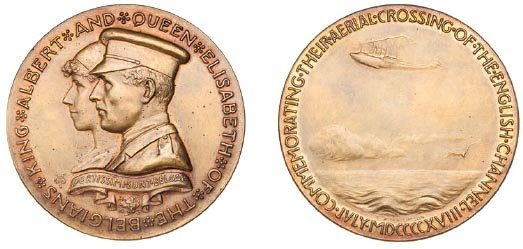
King and Queen of the Belgians medal in bronze (ANS 0000.999.4429).
Obv.: Conjoined busts of King Albert I and Queen Elisabeth of Belgium, facing left. Around, KING ∗ ALBERT ∗ AND ∗ QUEEN ∗ ELISABETH ∗ OF ∗ THE ∗ BELGIANS ∗; on ribbon under busts, FORTISSIMI· SUNT · BELGAE; below, oak leaves from ANS seal; to left, TSS monogram
Rev.: An airplane flying over the English Channel. Around, · COMMEMORATING·THEIR·AERIAL· CROSSING·OF·THE·ENGLISH·CHANNEL· / JVLY · MDCCCCXVIII
by Theodore Spicer-Simson; struck by the Medallic Art Co.
63 mm
Mintage
gold: 1
silver: 97 (including 3 presentation medals)
bronze: 136
brass: 2
tinted metal: 1
The idea for this medal came from J. Sanford Saltus, who was very interested in the doings of European royalty. In 1918 the king and queen of Belgium flew over the English Channel to Great Britain to celebrate the silver wedding anniversary of King George V and Queen Mary. As was often the case with medals he proposed, Saltus offered to pay for the dies and the gold medal to be presented to King Albert and Queen Elisabeth, which was made from gold obtained by melting Belgian coins. Saltus also bore the expense for presenting unnumbered silver specimens to honorary members King Victor Emmanuel III of Italy, King Alfonso XIII of Spain, and King Manuel II of Portugal, as well as a tinted-metal example to the British Numismatic Society (Adelson 1958: 218–219). The three unnumbered silver medals were included in the total silver mintage of 97.
Theodore Spicer-Simson joined the ANS on May 6, 1918. He was awarded the Saltus Award medal in 1955.
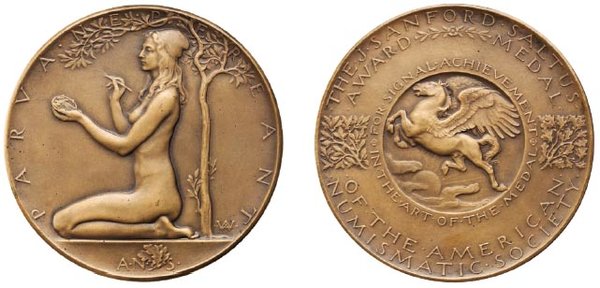
J. Sanford Saltus Award medal in bronze (ANS 0000.999.4431).
Obv.: A nude woman, kneeling left beside a tree, holding a medal in her left hand and a sculptor's tool in her right. Around, PARVA·NE·PEREANT; in exergue, A·N· (oak leaves) S; at lower right, signed FE (AAW monogram) CIT
Rev.: In a central medallion Pegasus, the sun and clouds in the background. Above, · THE · J·SANFORD· SALTUS · / AWARD MEDAL; below, · OF · THE · AMERICAN · / · NUMISMATIC · SOCIETY ·; around central medallion, FOR·SIGNAL·ACHIEVEMENT / IN·THE·ART·OF· THE·MEDAL
by Adolph A. Weinman; cast by Tiffany & Co., struck by Medallic Art Co.
78 mm
Mintage
silver: unknown
bronze: unknown
The Saltus award, which ranks as the most prestigious recognition of achievement for medallic sculpture, originated in 1913 when J. Sanford Saltus donated $5,000 to establish a permanent fund for the striking of an award medal to be given "…sculptors for distinguished achievement in the field of the art of the medal, to authors who have merited signal honor for numismatic research and scholarship, or to those who have materially aided in broadening the knowledge of the Science of Numismatics" (letter, J. Sanford Saltus to Archer M. Huntington, October 22, 1913, quoted in Adelson 1958: 191–192). Because the Archer Huntington medal award was also intended to honor numismatic research, the Society decided, in order to distinguish the two awards, that the Saltus medal would be reserved for excellence in medallic art (Adelson 1958: 213). Since 1919, fifty-five medals have been awarded (see Appendix 2 for list of recipients). Originally given only to American artists, since 1983 the award has been presented to foreign medalists as well, beginning with the award to Guido Veroi. In addition to the awarded medals and those in the Society's cabinet, several sets of shells exist, as well as one unawarded silver example now in the possession of a prominent New Jersey collector.

J. Sanford Saltus, 1908, with autograph note describing the occasion when the photograph was taken (author's collection).
The first award, to James Earle Fraser, was a cast medal. However, as this method of manufacture proved unsatisfactory, struck examples have been given since 1920 (Adelson 1958: 214). The struck medals were produced by the Medallic Art Company (letter, Sydney Noe to Medallic Art Co., March 3, 1920, ANS Archives). The Society's cabinet contains two silver examples acquired in 1920, one cast (ANS 1920.167.2) and one struck (ANS 1920.167.1). Other noteworthy specimens owned by the Society include a silvered electrotype of the obverse, the gift of Robert Weinman (ANS 1976.263.5), a pair of joined electrotype shells (ANS 0000.999.4432), and two bronze examples. The first of these was cast by Tiffany & Co. (ANS 0000.999.4430), while the other bears the Medallic Art Co. imprint (ANS 0000.999.4431). The Society also has a set of large galvanos, which used to hang in the reception office in the building on Audubon Terrace and is now on display in its exhibit hall. Over the years, there has been no consistent pattern for the engraving of this award, so that the presentation inscription may be found either on the edge or on the field.

Joan of Arc medal in gold (ANS 0000.999.4441).
Obv.: Half-length figure of Joan in armor, left, holding a sword by the blade, so that a cross is formed by the junction of the grip, blade, and guard. Around, in Lombardic capitals, ::HOMAGE::⚜::TO :⚜:THE:⚜:MAID:⚜:OF:⚜:FRANCE::; below, to left and right of vegetal ornament, signed · A H ·
Rev.: The banner of Joan of Arc, with three others in the background. Around, in Lombardic capitals, ⋮ JOAN ⋮ OF ⋮ ARC ⋮ PARK ⋮ NEW ⋮ YORK ⋮ DEDICATED ⋮ JANUARY ⋮ 6 ⋮ 1919 ⋮; below, oak leaves with small letters A N S
by Anna V. Hyatt; struck by the Medallic Art Co.
65 mm
Mintage
gold: 1
silver: 74
bronze: 119
lead: 1
This medal was issued to mark the dedication of the Joan of Arc Park in New York City on January 6, 1919. In 1915 an equestrian statue of Joan of Arc by Anna Vaughn Hyatt was erected in Riverside Park in New York, in commemoration of the 500th anniversary of Joan's birth. Members of the Joan of Arc Statue Committee with ties to the Society included J. Sanford Saltus (Honorary President), George Frederick Kunz (President), and Bauman L. Belden. A loan exhibit of paintings, pictures, medals, coins, and other items relating to Joan of Arc was held at the Society from January 6 to February 8, 1913 (Joan of Arc Statue Committee 1913). In 1919, the section of Riverside Park around the statue was named Joan of Arc Park.
The pedestal upon which the statue rests contains a number of historic pieces of stone, the inclusion of which was the idea of George F. Kunz, who wanted to include in the monument something personally connected to the life of Joan of Arc. The pedestal includes most of a group of 229 blocks obtained by the Statue Committee from the turret of the Château de Rouen, where Joan of Arc was imprisoned by the English after her capture in 1430 (Kunz 1915: 20–23). In 1916, a year after the statue's dedication, another stone was set into the pedestal, one from the cathedral at Reims where, in 1429, Charles VII was crowned King of France (Kunz 1915: 24–25).
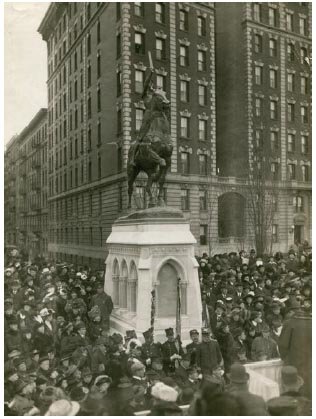
Unveiling of the statue of Joan of Arc on December 6, 1915 (Bain News Service, author's collection).
Prior to placement of the capstone, a copper box was placed inside the pedestal. In addition to a number of documents, the box contains coins from the United States and France, mostly dated 1915, as well as a number of medals, including two ANS medals, those for Grant's Tomb and J. P. Morgan. Additional French medals include a silver Washington Before Boston, a medal of Lafayette by Duvivier struck for the National Guard of Paris in 1789, a silver medal from the Franco-American Union for the erection of the Statue of Liberty in New York harbor, as well as others relating to Joan of Arc or the friendly relations between France and the United States (Kunz 1915: 25–28).
The single gold specimen of this medal was issued bearing serial number 1; the silver examples carry serial numbers 2 through 75. The issue price for this medal was $10 for silver and $5 for bronze. Medals were available to members of the committee in charge of the dedication of the park, as well as members of the Society ("Medal Commemorating the Dedication of Joan of Arc Park, New York," circular, April 15, 1919, ANS Archives).
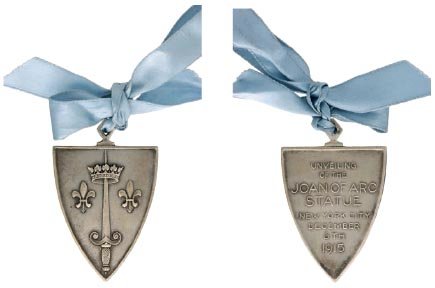
Silver medal produced by Tiffany & Co. for the dedication of the statue of Joan of Arc in 1915 (ANS 1915.241.1).
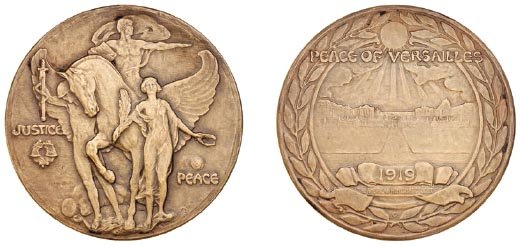
Treaty of Versailles medal in bronze (ANS 1985.81.7).
Obv.: A nude male astride a winged horse; on either side are the male embodiment of Justice and the female personification of Peace. To left, JUSTICE (scales and wreath); to right, (ANS seal) / PEACE; at lower right, signed with CB monogram.
Rev.: A view of the Palace of Versailles where the peace treaty was signed. Surrounding the palace is a decorative wreath. Above, PEACE OF VERSAILLES; on ribbon, 1919; below, THE AMERICAN NUMISMATIC SOCIETY
by Chester Beach; struck by the Medallic Art Co.
63 mm
Mintage
silver: 113
bronze: 318
The design for this medal was the result of a competition limited to sculptor-members of the Society. A total of fifteen designs were received by the closing date of January 15, 1919. Since the decision to strike a medal and the acceptance of a design preceded the actual conclusion of the treaty, striking of the medal was delayed until after the treaty was signed (Adelson 1958: 219).
The original circular described the complex allegorical images in detail: On the obverse Peace is shown with the palm branch and
wreath of victory—a beautiful womanly embodiment. On the other side of the winged horse, there is the manly form of
Justice—a figure
of Right Triumphant. The helmet of conflict is still upon his head, but the sheathed sword shows that the battle has
been won. At
the side, the wreathed scales appear. Justice and Peace advance together. Above the longing for peace and justice,
however, the
treaty of 1919 is distinguished beyond all others by the earnest desire that in future, war may be eliminated. The
powerful figure
mounted on Pegasus expresses the idea of the League of Nations incorporated in this treaty. The clasped
book of the law and the dynamic outstretched arm need no interpreting—the forcefulness of the type and its virility
suggest that
henceforth the principles of righteousness will be in control. The thought is further emphasized in the fallen figure
of destruction, whose torch is being trampled beneath the foot of Justice. In its lines, in its planes and in the composition
this
is a monumental design.
On the reverse is shown the palace of Versailles where the treaty was
signed. The sun is bursting through the clouds of war and its rays light up the facade. The whole is framed by a decorative
wreath.
The inscription Peace of Versailles, 1919, and the name of The American Numismatic Society complete the
design ("Medal Commemorating the Signing of the Treaty of Peace," circular, undated, ANS Archives).
Silver and bronze medals were offered to members of the Society at $10 and $5, respectively; by special action of the Council, bronze medals were offered for sale to non-members at the same price ("Medal Commemorating the Signing of the Treaty of Peace," circular, undated, ANS Archives).
George F. Kunz of Tiffany & Co. placed an order for ten silver Peace Treaty medals, requesting that three be left unfinished. The appearance of these medals apparently differed little from the regular, finished examples. It seems that they were delivered to the Society as part of an order of medals without having been separated out or distinguished in any way. As a result, they were distributed with the regular medals. Two additional unfinished medals were therefore ordered, which were to be given serial numbers 68 and 69 (letter, Sydney Noe to Mr. [Henri?] Weil, May 3, 1919, ANS Archives).
Another issue that arose with this medal involved the artist's signature and name of the manufacturer. According to a motion approved by the Council on November 4, 1918, "no medal issued in the name of the Society shall bear the imprint of the manufacturer; and the signature of the sculptor shall be confined to a monogram or initials, the size and location of which shall be specifically approved by the Committee on Publications of Medals" (letter, Sydney Noe to Mr. [Henri?] Weil, April 5, 1919, ANS Archives). While the restriction on the artist's name lasted for some time, only a few medals were struck without reference to the mint responsible.

Prince of Wales medal in bronze (ANS 1985.81.185).
Obv.: Bust of Edward in military uniform, right; to the right are the Prince of Wales plumes and ribbon with motto I SERVE. Around, EDWARD·PRINCE OF WALES; below plumes, signed with JF monogram.
Rev.: Standing figure of Columbia, her arms open in welcome; on either side of the field are oak branches, and below the inscription is the Society seal. In field, COMMEMORATING / THE VISIT OF / H·R·H· THE PRINCE / OF WALES / TO THE / UNITED STATES / NOVEMBER / M·C· M · X I X / A·N·S
by John Flanagan; struck by the Medallic Art Co.
63 mm
Mintage
gold: 1
silver: 145
bronze: 227
brass: 1 5
As usual with medals concerning European royalty, this medal was suggested by J. Sanford Saltus, who wrote to Sydney Noe, "If the Prince of Wales comes to the U.S. or even any part of America, I want a medal struck in honour of His visit." Saltus also offered to pay all costs associated with the artist, diesinker, one gold medal for presentation to the Prince, and six silver specimens for the Society (letter, Saltus to Noe, June 7, 1919, ANS Archives).
In an undated circular, silver medals were offered by subscription at $10, and bronze medals for $5 ("Medal Commemorating the Visit of H. R. H. the Prince of Wales to the United States, November, MCMXIX," circular, undated, ANS Archives). Although originally stated as closing January 1, 1920, the subscription date was later extended to March 1, 1920 (letter, Sydney Noe to C. C. Stillman, March 18, 1920, ANS Archives).
The gold medal was presented to the Prince of Wales on board HMS Renown on November 18, 1919. Present on behalf of the Society were Edward Newell, John Reilly, Jr., Henry Russell Drowne, Harrold E. Gillingham, and W. Gilman Thompson, the presentation being made by Newell. At the time of the presentation, Newell asked the prince if he would accept an honorary membership in the Society and was asked to make the request in writing. On December 1, 1919, Prince Edward was made an Honorary Fellow of the Society.

Presentation of the gold medal to the Prince of Wales on HMS Renown, November 18, 1919 (ANS Archives). (At front, left to right) Edward T. Newell, Edward Prince of Wales, William Gilman Thompson, John Flanagan, Henry Russell Drowne).
The gold medal was housed in a box whose wood came from a tree planted by the prince's grandfather who, as Prince of Wales, had visited the United States in 1860. This medal was sold by Sotheby's (1997: lot 201) in 1997 and was purchased by the Society with money donated by its past president, Harry Bass (ANS 1998.82.1). The elmwood box in which the medal was originally housed was not included in the sale and appears now to be lost.
Also included in the Sotheby's auction (lot 270) was a plaque by Flanagan issued for the same event and bearing a similar portrait but in informal, civilian dress. Measuring 6 3/8 inches in height, the plaque shows a bust of the Prince facing right, with the Prince of Wales plumes to the right; below is a depiction of HMS Renown. The inscription reads EDWARD / PRINCE OF WALES / ÆTATIS XXV / NEW YORK / NOVEMBER — XVIII – XXII / M·C·M· XIX. After his accession as King Edward VIII and subsequent abdication, a slightly reworked version of this plaque was made (Giordano 2009: CM361).
In 1979, Presidential Coin and Antique sold a bronze example with serial number 184 bearing the edge inscription S.M. JACKSON JACOBS MAYORS COMMITTEE RECEPTION TO DISTINGUISHED GUESTS. NOV. 18, 1919.
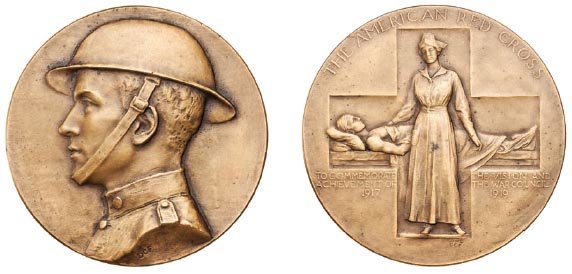
American Red Cross War Council medal in bronze (ANS 0000.999.4469).
Obv.: Helmeted bust of a doughboy, left. On truncation of bust, signed D C F
Rev.: A nurse standing before a bed-ridden patient within an incuse cross. Above, THE AMERICAN RED CROSS; below, to left and right of cross, TO COMMEMORATE THE VISION AND / ACHIEVEMENT OF THE WAR COUNCIL / 1917 1919; below lower arm of cross, signed WHL / DCF
by Daniel Chester French; struck by the Medallic Art Co.
70 mm
Mintage
gold: 12
silver: 4
bronze: 205
As with the Catskill Aqueduct medal several years earlier (see p. 101), the Society's role in the creation of this medal was minimal. Nevertheless, the Society's authorization and its participation in the medal's production and sale merit its inclusion in this catalogue.
The commission for this medal was offered to French by Robert de Forest in a letter dated March 31, 1919, with French accepting on April 9 (Richman 1988: 148). De Forest suggested to French that "either the program of your Catskill medal should be followed, that is a large medal which could be cast for presentation, with a possible reproduction in smaller size, or else the medal should be of the largest size that can be stamped with a die" (letter, de Forest to French, April 10, 1919, quoted in Richman 1988: 148).
The model for the obverse was French's nephew Prentiss French. The original reverse design showed a nurse behind a recumbent, wounded soldier. The change of positions as seen on the finished model, where the nurse stands in front of the soldier, was made on the suggestion of the artist Will H. Low. As a result, the reverse carries both French's and Low's initials (Richman 1988: 149). Another, presumably earlier version of this design was exhibited by French at the 1923 National Sculpture Exhibition and illustrated in that catalogue. Listed as a struck medal, this version is most easily distinguished on the obverse by the vertically arranged letters AEF to the right of the bust and the more complete signature on the truncation (National Sculpture Society 1923: 291, 356).
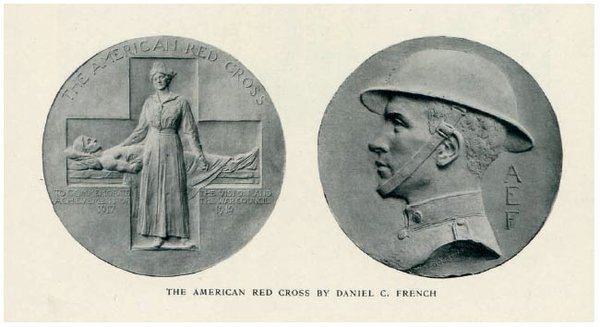
The version of the American Red Cross War Council medal exhibited by Daniel Chester French at the 1923 National Sculpture Exhibition, with minor differences on the obverse (National Sculpture Society 1923: 291).
French charged $1,250 for the artwork and $250 to make the dies, claiming he would normally have charged $2,500. Prices quoted for production were $4.00 each for 50 bronze medals or $3.75 each for 100–125 medals (Richman 1988: 155 n. 21).
The circular announcing the sale of bronze copies of the medal is dated January 15, 1921, and carries the names of both the American Red Cross and the American Numismatic Society at the top. It describes the twelve gold medals as having been presented to the members of the American Red Cross's War Council, the name of each recipient being engraved on the rim. An additional four medals in silver were noted as having been issued, but without further information. With the approval of the National Society, bronze examples were to be offered for sale to "Chapters and members of the Red Cross as well as to art museums and lovers of art". The subscription price for a bronze medal was $6 ("The American Red Cross Medal," circular, January 15, 1921, ANS Archives).
Although the mintage in bronze was 205 examples, the Society handled the sale of only 178. According to the medals ledger, the serial numbers of the bronze medals were 1–205, and 27 bronze medals were delivered directly to de Forest (medals ledger, ANS Archives). However, according to an account dated March 21, 1921, the medals delivered to the Society were to be numbered 51–228. Assuming the reported numbers of 12 gold and 4 silver are correct, and assuming all medals have a unique serial number regardless of composition, we would still be left with 7 medals unaccounted for with the numbers listed. The mintage figures listed should therefore be considered as approximate.
One of the silver medals can be found in the collection of the Metropolitan Museum of Art, donated by Robert de Forest (MMA 21.37). The edge bears the Medallic Art Co. stamp, but no indication regarding composition or serial number.
This medal was not the first effort at a collaboration between the Society and the American Red Cross. In early 1918, Edward Newell had discussed with George Peck of the American Red Cross the joint publication of a "Triumph Token". Designed by Victor D. Brenner, the model was approved by the Red Cross Committee with the intention that it be struck in bronze and sold for $1.00. In a letter dated March 16, 1918, Newell made a request to Peck, "In the same way that the seal of the American Numismatic Society is to be used as an indication that the Triumph Token has received the approval of those presumably able to adjudge its merits, so permission to employ the seal of the Red Cross Society is desired that there may be an understanding that no profit will accrue to any of the agencies through whom this token will be published" (letter, Newell to Peck, March 16, 1918, ANS Archives).
In his reply to Newell later that month, Peck conveyed the news that he had discussed with Mr. S. M. Greer, the Director of Development, American Red Cross, "the matter of the medal proposed to be issued by the Numismatic Society as a measure for aiding the Red Cross." Unfortunately, Greer thought it not advisable due to limitations imposed on the Red Cross by its charter and the possible appearance of this being merchandising (letter, Peck to Newell, March 27, 1918, ANS Archives).
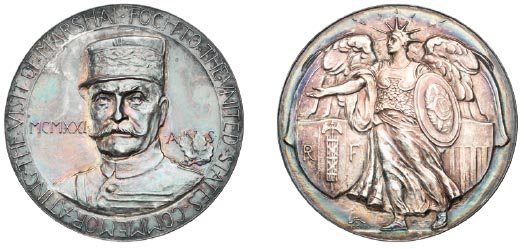
Marshal Foch medal in silver (ANS 0000.999.4467).
Obv.: Nearly facing bust of Foch in military uniform. Around, COMMEMORATING · THE · VISIT · OF·MARSHAL·FOCH·TO· THE·VNITED·STATES·; in left field, MCMXXI; in right field, ·A·N·S· / (oak leaves)
Rev.: The welcoming figure of Victory, with the shields of France and the United States on either side. At lower left, signed (RA monogram) / ·FECIT·
by Robert Aitken; struck by the Medallic Art Co.
64 mm
Mintage
gold: 1
silver: 94
bronze: 206
copper: 1
This medal was issued at the suggestion of J. Sanford Saltus, who offered to cover expenses. Due to the short time available before Foch's visit, the medal was offered to Aitken as a commission, rather than through open competition. Fortunately, the marshal was scheduled to be at Audubon Terrace to lay the cornerstone of the new building of the adjacent American Academy of Arts and Letters. Acting President John Reilly, Jr., presented the gold medal to Foch on November 19, 1921, in a ceremony at the Society, attended by Council members and select guests. Subsequent to the visit, silver and bronze examples were offered to members of the American Numismatic Society, the Alliance Française, and the Institut Français aux États-Unis (Adelson 1958: 223–224). Prices for this medal were set at $10 for silver and $5 for bronze. Orders were required to be received by December 15, 1921, with the exception of those from abroad, provided they were posted prior to the stated date ("Medal Commemorating the Visit of Marshal Foch to the United States, MCMXXI," circular, undated, ANS Archives).
According to the ANS medals ledger, a bronze medal bearing serial number 2 was placed in a box with a number of documents and deposited in the cornerstone of the new building of the American Academy of Arts and Letters on November 19, 1921. The cornerstone was laid by Marshal Foch after the presentation of the gold medal.
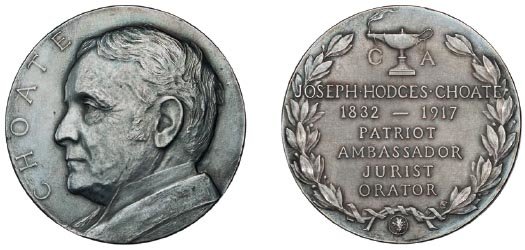
Joseph Hodges Choate medal in silver (ANS 0000.999.4464).
Obv.: Bust of Choate, left. Around left, CHOATE; in lower right field, signed HA
Rev.: Six-line inscription within a wreath: JOSEPH · HODGES·CHOATE / 1832 — 1917 / PATRIOT / AMBASSADOR / JURIST / ORATOR. Above, lamp of knowledge flanked by the letters C and A; below, the seal of the ANS.
by Herbert Adams; struck by the Medallic Art Co.
64 mm
Mintage
silver: 98
silver: 238
Joseph Choate (1832–1917) was a well-known lawyer and diplomat, who served as ambassador to Great Britain under President McKinley and later as head of the American delegation to the 1907 Hague Conference (Century Association 1918: 23). He was active in a number of New York cultural organizations, including the Metropolitan Museum of Art, of which he was one of the founding trustees (Jackson 1995: 219). In one of his celebrated legal cases, Choate defended Luigi Palma di Cesnola, the first director of the Metropolitan Museum of Art, in the bitter libel suit by prominent ANS member Gaston L. Feuardent (Tomkins 1989: 91). 6
This medal was struck in cooperation with the Century Association, of which Choate had been president. In 1919 the ANS lent a number of medals and plaques for an exhibition held at the Century. As a result, that association decided to issue a series of medals in honor of men who had distinguished themselves in public service, the arts, letters, or other activities. The Choate medal was the first in this series.
In addition to members of the Society, subscriptions for this medal were offered to members of the Century Association, the Bar Association, the Harvard Club, and a limited list of other friends and collectors. The issue price was $10 for a silver specimen and $5 for one in bronze ("The Choate Medal," circular, undated, ANS Archives).
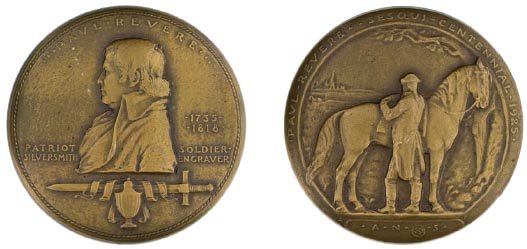
Paul Revere medal in bronze (ANS 0000.999.20962).
Obv.: Bust of Revere, left; below is a sword entwined with a fillet and a silver urn, the whole enclosed by a cable border. Above, ◂ ▸ ▸ PAUL ▴ REVERE ◂ ◂ ▸; to right, ▴ 1735 ▴ / ▾ 1818 ▾; to left and right, ▾ PATRIOT SOLDIER ▾ / SILVERSMITH ENGRAVER
Rev.: Revere standing beside his horse, awaiting the lantern signal from the church steeple. Around, ◂ PAUL ▴ REVERE ▴ ▴ SESQVI—CENTENNIAL ▴ 1925 ▸; in exergue, ▴ A ▴ N ▴ (ANS seal) ▴ S ▴; to left and right of exergue, signed A F
by Anthony de Francisci; struck by the Medallic Art Co.
63 mm
Mintage
silver: at least 65
bronze: 173
This medal was issued to commemorate the 150th anniversary of Paul Revere's historic ride. Due to the topics J. Sanford Saltus had chosen to sponsor, many of the medals issued in the preceding years had related to foreigners. This resulted in some criticism, which would be allayed by this and the following medal, issued for the tercentenary of the Dutch purchase of Manhattan. Despite the support of several jewelers and booksellers in New York and Boston, who offered the Revere medals for sale at cost, sales were deemed disappointing and the medal was a financial failure (Adelson 1958: 224). However, it is likely that many of the medals issued in the years before Saltus died in 1922 would also have lost money if not for his generous support.
According to Adelson, the obverse of this medal required a certain amount of imagination, as "no medal with a satisfactory likeness of Paul Revere had ever been struck, and the portraits by Gilbert Stuart and St. Memin showed him only during his advanced years" (Adelson 1958: 224). Evidently they were unable to obtain a copy of Copley's famous portrait of Paul Revere, which was then rarely exhibited. That portrait, painted in 1768, remained in the possession of the Revere family until 1930, when it was presented to the Boston Museum of Fine Arts by Joseph W. Revere, William B. Revere, and Edward H. R. Revere (MFA 30.781). The reverse caused some criticism, as it looks like Revere is about to mount his horse from the wrong side (Adelson 1958: 225). As described in the medal circular, Revere was only standing by his horse, waiting for his signal.
There has been some question as to the method of manufacture of this medal. Although it has often been described as cast, a number of contemporary references describe it as having been struck, though preparations were unusual. According to the original 1925 circular, "At his [Francisci's] suggestion, a radical departure in the form of our medal was agreed upon—the rounded edge—an element which contributes in no small degree to the attractiveness of the result. It is also of interest that the reverse was first modelled in the exact size of the medal itself. It was then enlarged and again reduced after having been retouched, this course having been taken in order to eliminate the pantographic effect of the reducing machine. The obverse was modelled on a scale of only three diameters" ("Medal Commemorating the Paul Revere Sesqui-centennial, MCMXXV," circular, undated, ANS Archives). The belief that this medal was cast may be due, at least in part, to the rounded edge. However, the circular further stated that "a limited number will be struck and ready for delivery by April 18th, the date of the ride".
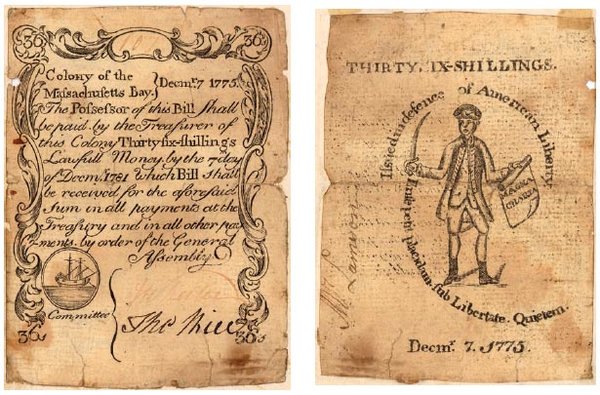
Massachusetts bill of credit, issue of December 7, 1775, engraved by Paul Revere (ANS 0000.999.29699).
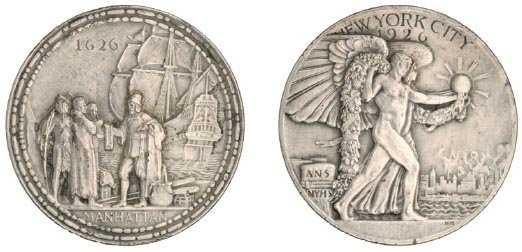
Manhattan Tercentenary medal in silver (ANS 0000.999.4471).
Obv.: A group of Indians bartering with Peter Minuit; in the background is a Dutch sailing ship. The border design is comprised of strings of wampum. Above, 1626; in exergue, MANHATTAN
Rev.: Nude male and winged female figures, walking right, represent Commercial Progress and the Intellectual Life of New York. In the background is the New York skyline. Above, NEW YORK CITY / 1926; at lower left, A·N·S / NYHS; in exergue at right, signed HM
by Hermon MacNeil; struck by the Medallic Art Co.
64 mm
Mintage:
silver: 50
bronze: 100
This medal was originally conceived as being issued in honor of the 300th anniversary of the founding of New York. However, due to uncertainty over the date of this event, the medal was deferred until the anniversary of the purchase of Manhattan Island in 1926 (Committee on the Publication of Medals 1925). This was a joint issue with the New-York Historical Society and the initials of both societies can be seen on the reverse, in the lower left. Like the Paul Revere medal (see p. 124), this medal was considered a financial failure; without the financial support previously provided by Edward D. Adams, J. Sanford Saltus, and others, member subscriptions were not sufficient to cover the costs (Adelson 1958: 225–226).
The issue price for this medal was set at $10 for silver and $5 for bronze. A limited number of medals ordered were to be available for delivery by May 4, the anniversary of the date on which Peter Minuit arrived in New York ("Medal Commemorating the Tercentenary of the Purchase of Manhattan Island, 1626–1926," circular, undated, ANS Archives). This medal was still available for purchase in 1953 when Georgia Stamm Chamberlain wrote a brief article for the magazine Hobbies entitled "Tercentenary of New York Medals" (reprinted in Chamberlain 1963: 139).
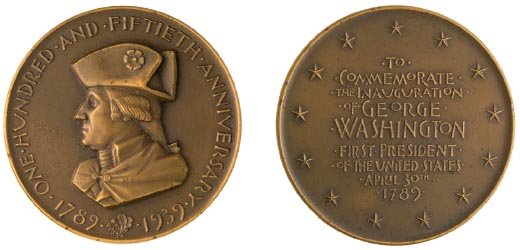
Washington Sesquicentennial medal in bronze (ANS 1939.75.1).
Obv.: Uniformed bust of Washington, left. Around, ONE·HUNDRED·AND·FIFTIETH·ANNIVERSARY / ·1789·ANS (oak leaves) ·1939·
Rev.: Nine-line inscription within a circle of thirteen stars: · TO · / · COMMEMORATE · / · THE · INAUGURATION ·/·OFGEORGE·/· WASHINGTON / · FIRST·PRESIDENT·/·OF·THE· UNITED·STATES· /·APRIL·30TH·/· 1789 ·
by Albert Stewart; struck by the Medallic Art Co.
63 mm
Mintage
silver: 38
bronze: 95
silvered bronze: unknown
The 1930s saw several important anniversaries connected with George Washington. Although the 1932 bicentennial of Washington's birth was the one that seems to have most caught the public's interest, Howard Adelson offered the opinion that the Society made a conscious decision to honor only one event, due to the close proximity in time (Adelson 1958: 250). More important, perhaps, might have been the combined effects of the Great Depression and the lack of financial success of some of the more recent medals. Without the financial backing of supporters such as J. Sanford Saltus, the true cost of striking medals became a greater concern than in the past, and the relatively low mintage of this issue, even in 1939 when the Depression was less severe, is an indication of how difficult an earlier medal might have been. The financial situation, which began to show improvement by 1935, would certainly have been a factor in deciding to issue a medal in 1939, and not earlier (Adelson 1958: 244).
In addition to the thirty-eight silver and ninety-five bronze medals, at least one silvered bronze example was struck, which can be found in the Society's cabinet (ANS 1939.75.2). A bronze medal bearing serial number 100 has been reliably reported. Although documentation has not been located, it would seem that the Medallic Art Company likely struck 100 numbered examples but only delivered the 95 ordered, the remaining medals being relegated to the company's archives or corporate use.
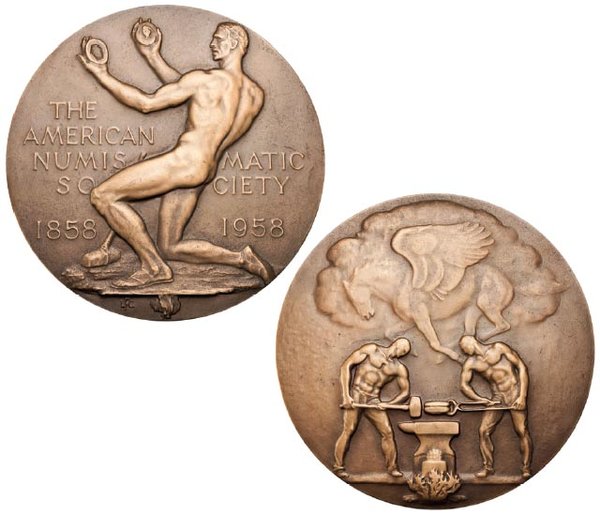
ANS Centennial medal in bronze (ANS 1968.55.1).
Obv.: Kneeling nude male holding a broken rock, displaying a fossil animal in one hand and its counterpart in the other. To left and right, THE / AMERICAN / NUMIS MATIC / SO CIETY / 1858 1958; at bottom, LGF monogram and oak leaves.
Rev.: Two men striking metal on an anvil; above, against a cloud, is Pegasus. Below, a cluster of oak leaves.
by Laura Gardin Fraser; struck by Medallic Art Co.
89 mm
Mintage
bronze: 620
This medal was accompanied by a descriptive leaflet, which quotes the artist's description of her concept:
When Nature
petrified the first forms of animal and plant life, Nature made the first dies. The obverse of the American Numismatic
Society
Centennial Medal shows the potential archeologist, who, having broken a stone asunder, discovers a petrified animal
form in one half
and in the other a perfect impression of it, or the die.
Since tablets, coins and medals constitute the authority for
historical data and our earliest civilizations expressed themselves in terms of their particular mythologies, on the
reverse of the
medal I used the Pegasus as a symbol of the arts, to indicate as in a vision, that numismatics was a science from the
era of the
Pegasus to the geo-physical year of the harnessing of the atom.
To the fore of this vision are
the artisans who are in the act of forging a medal, using such tools as are the basis of modern medal making" ("Centennial
Medal of
the American Numismatic Society" [leaflet]).
The commission for this medal was given to Laura Gardin Fraser without resorting to any competition. In accepting, Fraser noted that there would be no obligation on the part of the Society if the designs were not satisfactory (letter, Laura Gardin Fraser to Louis C. West, June 23, 1957, ANS Archives). In fact, Fraser's original design was only accepted after substantial modification. On July 9, Fraser submitted a photograph of her sketch for the medal, with the reverse showing "the role that Numismatics have played in rendering the most complete record of history from the era of Pegasus to the rocket and the smashing of the atom". Fraser further wrote that "in the finished model the rocket would be more discernible with the purifying of its form as it is seen against the cloud effect suggestive of the atomic burst" (letter, Laura Gardin Fraser to Louis C. West, July 9, 1957, ANS Archives).
In response, President Louis West expressed some reservations about the design for the reverse. In addition to minor recommendations, such as one regarding the placement of the Society's oak leaves, he suggested "… a slight change in your present sketch by showing the two workmen more clearly making a coin or medal surmounted, perhaps with the Pegasus you now have but, if you wish, with a cloud instead of an atomic burst" (letter, Louis C. West to Laura Gardin Fraser, July 10, 1957, ANS Archives). In the end, the final version displayed classical images with no apparent reference to the modern, atomic age.

Invitation to the Society's 100th Anniversary celebration on April 12, 1958 (ANS Archives). This event was followed by a dinner for the Council, staff, and benefactors.
The medals were offered for sale only by subscription at a price of $3.50. They were housed in plain, skytogen boxes and do not bear serial numbers. Although a popular success with 620 medals struck, the issue was not calculated to make money; the cost of each medal was significantly more than the sale price. Costs concerning this medals included:
| 620 Centennial medals @4.00 | 2,480.00 |
| 650 folders | 80.00 |
| Die cutting | 430.00 |
| Artist fee | 1,500.00 |
Thus, each medal had an actual cost of nearly $7.25, not counting postage, mailing boxes at 15¢ each, plus handling (letter, Medallic Art Co. to Sawyer McA. Mosser, November 15, 1957; Medallic Art Co., acknowledgment of order, June 6, 1958; letter, Laura Gardin Fraser to Louis C. West, October 23, 1957, ANS Archives). Despite it being a financial burden, the medal proved to be a fitting and still popular memorial of the Society's centennial.
There are several patterns in the Society's collection, the variations being limited to patina and thickness. There are two examples struck on slightly thicker planchets, one with a lighter, yellow-tan finish (ANS 1958.175.3) and the other with a dark finish (ANS 1958.175.4). Two other patterns, on regular planchets, display a dark finish (ANS 1958.175.1 and 1958.175.2). The medals produced for sale have a light to medium bronze finish, with the raised design a lighter color than the field.
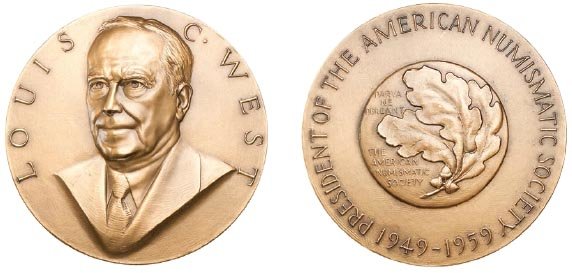
Louis C. West medal in bronze (ANS 1960.131.1).
Obv.: Bust of Louis C. West, three-quarters left. Around, LOUIS C. WEST; on truncation, signed GILROY ROBERTS 1960
Rev.: Seal of the American Numismatic Society. Around, PRESIDENT OF THE AMERICAN NUMISMATIC SOCIETY / 1949–1959
by Gilroy Roberts; struck by the Medallic Art Co.
69 mm
Mintage
gold: 1
bronze: 175
This medal was issued to mark Louis West's retirement as president of the Society. Highly regarded by the Society's Council, West may have left office due to health reasons. Appointed as a "committee of one" to select an artist after the December 1959 Council meeting, Robert Nesmith asked Gilroy Roberts "if the work could be done in the near future if possible due to President West's health" (draft of letter, Nesmith to Roberts, undated, ANS Archives).
Louis West was the fifteenth president of the American Numismatic Society, serving from 1949 to 1959. While he was in office, the Society's facilities were renovated, and the Summer Graduate Seminar was inaugurated (Milbank 1960: 1–2). West also served as the first curator of the Princeton University numismatic collection from 1942 to 1967.

Sydney P. Noe medal in bronze (ANS 1966.69.1).
Obv.: The seal of the American Numismatic Society. In upper left, PARVA / NE / PEREANT; in lower left, THE / AMERICAN / NUMISMATIC / SOCIETY
Rev.: Eight-line inscription: TO / SYDNEY P. NOE / FIFTY YEARS OF / DEVOTED SERVICE / THE AMERICAN NUMISMATIC / SOCIETY / NOV. 1, 1915 / NOV. 1, 1965
by the Medallic Art Co.
70 mm
Mintage
gold: 1
bronze: unknown
Sydney P. Noe was born in Woodbridge, New Jersey, on April 4, 1885. A graduate of Rutgers University, where he studied engineering, Noe joined the staff of the American Numismatic Society as Librarian in 1915, serving in that position until 1938, when he was appointed Curator upon the death of Howland Wood. Noe also served as Secretary of the Society for thirty years, giving up the position when he was named Chief Curator in 1947. From 1921 to 1945 he was also Editor. In 1953 the Council voted to retire Noe with the title Chief Curator Emeritus.
A specialist in Greek coins, Noe also researched Massachusetts colonial coinage and Mexican hacienda tokens. He published more than forty monographs and articles. Among the honors he received were the Society's Huntington Medal in 1938 and the Medal of the Royal Numismatic Society in 1949. After his retirement, Noe continued to go to the Society several days a week. The Council presented him with this gold medal in 1965 in recognition of fifty years of service to the Society. Noe died four years later at age 84 (American Numismatic Society n.d.).
In his speech at the presentation of the medal to Noe on November 13, 1965, ANS President
Samuel Milbank recalled their first meeting: Many years ago, in 1921, to be exact, I walked into the Museum of the Society
(Numismatic) and asked to talk with somebody about Greek coins. From that moment of a most cordial and friendly
reception, I have never ceased to be thankful for the friendship, kindly guidance and wisdom that has been offered
unstintingly by
our old friend, Sydney P. Noe…
He has held many posts with us, starting with that of Librarian and
Secretary, Editor, later Curator and, since 1953, Curator Emeritus. Winner of
the Huntington Medal Award in 1938, he also received the Royal Numismatic Society Medal in 1949….
Now we, his students and
friends, are happy to present to him one additional medal—a special one struck exclusively in his honor.
Mr. Noe, I hope you will accept this medal as an expression of appreciation from all of us who have worked with you and
been guided by you over these last fifty years ("Presentation of Medal Award to S. P. Noe," November 13,
1965, typescript, ANS Archives).

Margaret Thompson and Sydney Noe at the ANS on November 13, 1965, when the gold medal was presented to Noe (ANS Archives). The roses held by Noe were given as part of the presentation cermemony.
A bronze example resides in the Society's cabinet, in a box labeled "Replica of the Gold Medal given to Sidney [sic] P. Noe for 50 Years of service" (ANS 1966.69.1). The reverse inscription is engraved, rather than struck.
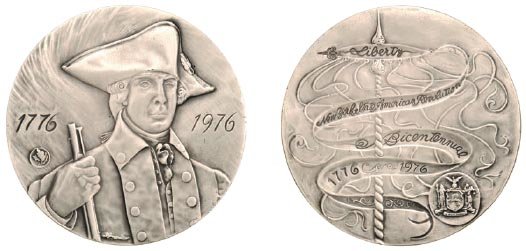
New York State Bicentennial medal, 63 mm, in silver (ANS 1975.52.3).
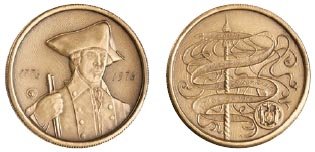
New York State Bicentennial medal, 38 mm, in bronze (ANS 1975.52.2).
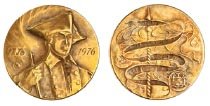
New York State Bicentennial medal, 25 mm, in gold (ANS 0000.999.20276).
Obv.: Half-length colonial soldier wearing a tricorne hat and holding a musket. In left field, 1776 / (ANS seal); in right field, 1976; at bottom, signed Americo
Rev.: Liberty pole with ribbons attached; the seal of New York State at lower right. On ribbons, Liberty / New York State American Revolution / Bicentennial / 1776 1976
by Americo Giannicchi; struck by the Medallic Art Co., 38-mm proof medals struck by the Franklin Mint
63 mm, 38 mm, 25 mm
Mintage
63 mm bronze: unknown
.999 silver: unknown
38 mm bronze: unknown
.999 silver: unknown
.925 silver proof: unknown
25 mm gold: unknown
The bicentennial of American independence saw a tremendous explosion in the number of medals issued, a trend which proved remarkably short-lived. This was the official New York State Bicentennial medal. The Society's involvement in this medal was limited to sponsoring the 1972 design competition, in cooperation with the Medallic Art Company and the New York State American Revolution Bicentennial Commission. It also lent use of its seal, which can be seen on the obverse below the date 1776. With the exception of the small silver proof medal that was sold as part of a set of proof medals of the thirteen original colonies, these were sold by banks throughout the state. The gold medal was housed in a red box, while the bronze and silver medals were issued in black card holders. Several off-metal strikes are known, most notably in silvered bronze and marked SAMPLE.
There are small design differences between the large and small versions of this medal, most notably in the relief and the fact that the dates are incuse on the larger medals but in relief on the smaller ones. The large medals and the small silver medals with a proof finish have plain edges, while the small medals with a matte finish have reeded edges; in addition, all silver medals bear serial numbers on the edge.
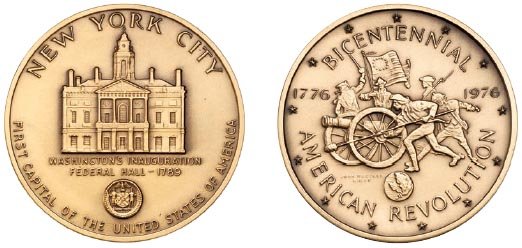
New York City Bicentennial medal, 63 mm, in bronze (ANS 1977.14.2).

New York City Bicentennial medal, 38 mm, in bronze (ANS 0000.999.44464).

New York City Bicentennial medal, 25 mm, in gold (ANS 0000.999.20275).
Obv.: The original Federal Hall; the seal of the City of New York below. Around, NEW YORK CITY / FIRST CAPITAL OF THE UNITED STATES OF AMERICA; under Federal Hall, WASHINGTON'S INAUGURATION / FEDERAL HALL – 1789
Rev.: Five Revolutionary War soldiers with cannon and flag within a circle of thirteen stars; ANS seal below. Around, BICENTENNIAL / 1776 / 1976 / AMERICAN REVOLUTION; below cannon, signed JOHN RUSSELL / RIDGE
by John Russell Ridge; struck by Medallic Art Co., 38-mm proof medals struck by the Franklin Mint 63 mm, 38 mm, 25 mm
Mintage
63 mm bronze: unknown
.999 silver: unknown
38 mm bronze: unknown
.999 silver: unknown
.925 silver proof: unknown
25 mm gold: unknown
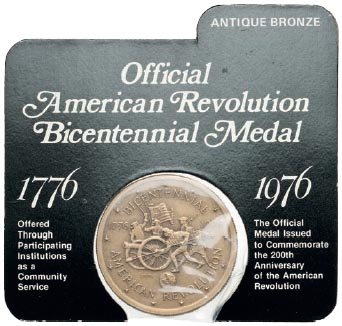
Example of the card holders in which the bronze and silver New York State and New York City Bicentennial medals were sold (ANS 1976.250.4).
This was the official New York City Bicentennial medal, and, like the New York State medal, it was sold by banks throughout the state. The holders are generally similar to those of the state issue. The silver proof medal was issued in a small white box with red and blue printing, accompanied by a fold-out brochure. As with the New York State Bicentennial medal, the Society's involvement was limited to sponsoring the design competition in 1972, along with the Medallic Art Company and the New York City American Revolution Bicentennial Commission. Off-metal sample strikes are known to exist.
New York City's second City Hall, erected in 1699 and occupied in 1703, played a prominent role in the history of the city, as well as that of the nation. It was there in 1735 that John Peter Zenger, editor of the New-York Weekly Journal, was tried and acquitted of seditious libel. Thirty years later, in October 1765, the building was the site of the meeting of the Stamp Act Congress, whose delegates produced the Declaration of Rights and Grievances. After New York became the country's capital in 1785, the building was the site where Congress met, as well as the location of George Washington's 1789 inauguration as the first President of the United States. After ratification of the Constitution, it was renamed Federal Hall. It was demolished in 1812. The present building on this site dates from 1842 (Jackson 1995: 230–231, 393–394).

Membership medal of 1978 in silver (ANS 1978.137.2).
Obv.: An owl perched on an oak branch. Above, MEMBER'S MEDAL; to left, PARVA NE / PEREANT; at lower right, signed ELISCU
Rev.: An oak sapling growing through a rock. Around, THE AMERICAN NUMISMATIC SOCIETY
by Frank Eliscu; struck by the Medallic Art Co.
63 mm
Mintage
gold: unknown
silver: unknown
bronze: unknown
The need for a new member's medal became apparent by the 1960s as existing stocks of the Borglum medal were exhausted and the dies were not in adequate condition for further strikings. A competition was held, with Frank Eliscu declared the winner.
With regard to his design, undated notes by Eliscu indicate the intent: The owl has long been a symbol of
learning and scholarship. The Greeks associated the owl with their patroness Athena, Godess [sic] of Knowledge and Wisdom, and this bird look [sic] out
from the obverse side of Athenian coins.
In using the Barn Owl, I am trying to relate more closely
with the American scene, and as the A.N.S. is one of Americas oldest learned societies. I feel the Barn
owl, stylized, a most appropriate symbol.
In addition to his winning design, Eliscu prepared several alternate drawings, including two designs depicting deer. The Society's collection contains a pair of uniface lead die trials (ANS 1978.137.3 and 1978.137.4). The box containing the obverse trial carries the inscription, "At suggestion of R. Weinman, the tail feathers were extended to the edge of the die in the final version."
At the Society's fall meeting in 1984, retiring President Harry W. Bass, Jr., was presented with a gold membership medal. The presentation was made by Harry Fowler, who said, "To commemorate the Bass years, we are happy to continue the tradition begun when your predecessor, Sam Milbank, retired, by presenting to you, on behalf of the entire Society, this example in gold of the Society's Member's Medal. On its rim is inscribed 'Harry W. Bass, Jr. President 1978–1984.' Harry, I know that everyone joins me in saying to you—Thank you for leading us" ("Harry Bass Receives ANS Gold Medal," ANS Newsletter, Fall 1984, pp. 1–2). Other recipients of gold membership medals include Eric Newman in October 1996 ("Eric P. Newman Honored for Distinguished Service," ANS Newsletter, Fall 1996, pp. 1–3) and R. Henry Norweb, Jr., in October 1994 ("R. Henry Norweb, Jr., Honored at Tribute Dinner," ANS Newsletter, Fall 1994, pp. 1–3).

Sketches by Frank Eliscu presenting his design and explaining the concepts for the committee choosing the design for the medal (ANS Archives).
Silver and bronze examples have also been presented as awards on occasion. In 1977 there was a robbery at the Society (Hoge
and Yoon 2011). Largely through the efforts of David Sonderman, a
Connecticut coin dealer, the person responsible was apprehended and the stolen objects recovered. In appreciation, on
June 9, 1978, the
Council approved the following resolution, which was inscribed on a plaque and presented to Mr. Sonderman at
the ANA convention that year: Presented to DAVID SONDERMAN
Who, by virtue of his personal integrity
and great moral courage, made possible the arrest and conviction of the person responsible for the August 21, 1977
robbery at the
American Numismatic Society and complete recovery of the of the objects stolen.
In grateful appreciation
The Council of
the Society 1978
Illustrated in the Society's annual report for 1978, the plaque consists of a base bearing the presentation inscription and a vertical wood block upon which is mounted a membership medal, the reverse showing (American Numismatic Society 1978: 54, 56).

Presentation of a gold Members medal to outgoing President Harry Fowler (left) by incoming President R. Henry Norweb, Jr., on October 12, 1990 (ANS Archives).
The original prices of the third member's medal were $60 for silver examples and $15 for bronze. As of April 1979, 122 silver and 241 bronze medals had been sold. By that time, prices had increased to $130 and $35, respectively. The initial order of medals carried serial numbers on the edge ("Member's Medal Bargain to Original Subscribers", ANS Newsletter, April 1979, p. 3).
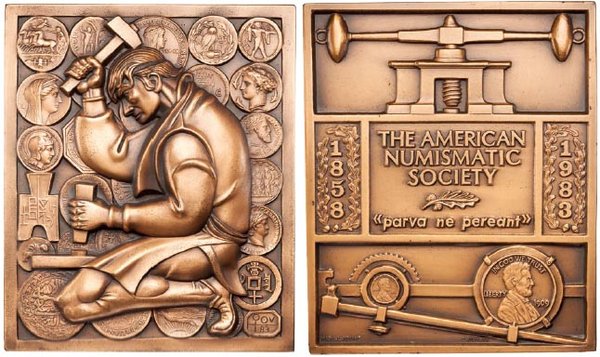
ANS 125th Anniversary medal in bronze (ANS 1984.121.2). Reduced to 88%; actual size 90 × 110 mm.
Obv.: A moneyer using the technique of hammer striking to produce a coin. Behind him are representations of pieces from the ANS collection. At lower right, signed with stylized Jov / 83
Rev.: In upper panel, a screw press; in lower panel, Janvier pantographic lathe making a reduction of Brenner's Lincoln cent obverse. In central panel, to left, 1858; in center, THE AMERICAN / NUMISMATIC / SOCIETY / (oak leaf) / «parva ne pereant»; to right, 1983. At lower right of panel, signed MARCEL JOVINE and S. JOHNSON
by Marcel Jovine; struck by Stefano Johnson 90 × 110 mm
Mintage
gold: 3
silver: 100
bronze: 500
The design for the medal commemorating the Society's 125th anniversary was chosen after a limited competition of seven sculptors—Frank Eliscu, Edward Grove, Julian Harris, Michael Iacocca, Marcel Jovine, Michael Lantz, and Robert Weinman (letter, Alan M. Stahl to members of Anniversary Medal Committee, January 12, 1982, ANS Archives). According to the letter sent to each artist accompanying the Competition Fact Sheet, the winner was to receive a prize of $3,500, with a small honorarium to each unsuccessful entrant (enclosure with letters from Alan M. Stahl to invited artists, January 30, 1982, ANS Archives). The committee was to rank the entries in descending order of merit and make a recommendation to the Council. Originally, the committee recommended a different design by Jovine, but this was rejected by the Council (letter, Alan M. Stahl to members of the Ad Hoc Committee for the 125th Anniversary Medal, October 12, 1982, ANS Archives). It was said at the time that some Council members objected to the male nudity in the recommended design (Stahl 2008). Instead, an alternative design by Jovine was chosen. There was some concern among the committee that the minter in this design looked as if he were hitting himself on the head with his hammer. However, it was decided to accept this and assign it to artistic license (author's personal recollections).

(Left) Harry W. Bass, Jr. (left), being presented with a gold 125th Anniversary medal by Leslie Elam (ANS Archives).
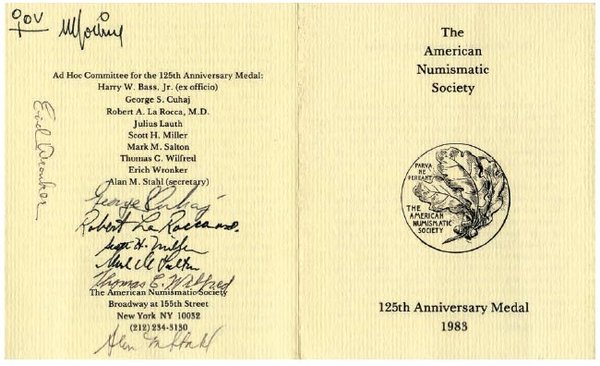
(Below) Leaflet describing the 125th Anniversary medal, signed by the artist and by the members of the committee to choose the design who were present at the meeting when it was first distributed (author's collection).
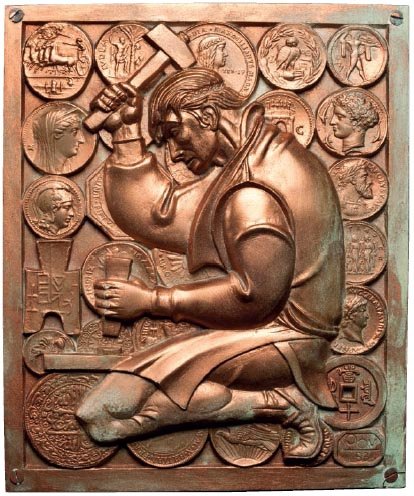
Plaster model for the obverse of the 125th Anniversary medal, incorporating casts of a variety of coins from the Society's collection (ANS 2014.19.1; 200 × 240 mm).
Originally two gold examples, housed in blue leather presentation cases, were struck, one for the Society and one for Harry Bass, Jr., then President of the ANS. After Bass's example was lost, another gold medal bearing the same serial number 2 was struck as a replacement. That replacement specimen was sold by Bowers and Merena in their May 7–9, 1999, sale of the Harry W. Bass, Jr., Collection, lot 2093. The 100 silver examples were issued in red leather cases, while the bronze medals had green cardboard cases. A leaflet explaining the design accompanied each medal. The issue price was $350.00 for silver examples and $34.25 for bronze.
On the back of the leaflet can be found the names of the members of the Ad Hoc Committee for the 125th Anniversary Medal—Harry W. Bass, Jr. (ex officio), George S. Cuhaj, Robert A. LaRocca, Julius Lauth, Scott H. Miller, Mark M. Salton, Thomas C. Wilfred, Erich Wronker, and Alan M. Stahl (secretary). When the medals were first distributed, members of the committee signed each other's leaflets, so that they bear signatures of all members except Harry Bass and Julius Lauth, who were not present at the meeting; the two examples accompanying the author's medals also bear the signature of Marcel Jovine.
The coins and medals portrayed on the obverse were made by taking casts of actual specimens from the Society's collection and setting these casts in the model to be reduced using a Janvier reducing machine as depicted on the reverse. The Lincoln cent found on the reducing machine on the reverse reflects the role of the Society in coin and medal design. Victor D. Brenner, designer of the Lincoln cent, was a member of the Society, which gave its support to his design.
The original 7½ × 9-inch plaster model was later donated by the artist to the Society for its 135th Anniversary Gala benefit auction, conducted by Stack's on November 17, 1993, where it was listed as lot 189.
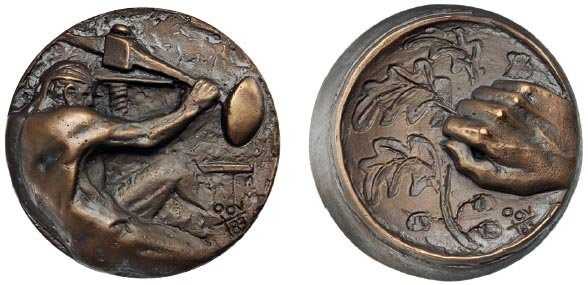
Pair of uniface bronze casts of the original Jovine design recommended by the committee (private collection).
In the October 6, 1982, issue of Coin World, the various artists' entries were published, with a free medal being offered to the first five readers who could correctly match the artist with each entry. Included in the article for comparison were identified illustrations of another medal by each artist ("Match Medallists, Works to Win Top Design Medal," Coin World, October 6, 1982, pp. 3, 32). Only one reader, N. Neil Harris, was successful ("ANS Anniversary Medal by Jovine," ANS Newsletter, Fall 1982, pp. 1, 3).
Despite the Council's rejection of the original, recommended design, some members of the 125th Anniversary Medal Committee were so pleased with it that twelve sets of uniface bronze casts were ordered from the artist. The Society's cabinet contains the original, uniface clay models submitted by Jovine (ANS 0000.999.20960 and 0000.999.20956). This rejected design can be described as follows:
Obv.: Nude male, right, working a screw coining press. At lower right, signed with stylized Jov
Rev.: The hand of a sculptor engraving a branch with oak leaves.
by Marcel Jovine
71 mm
Mintage
bronze: at least 12 uniface cast sets

Statue of Liberty medal in silver (ANS 1986.11.2).
Obv.: Facing view of the head of the Statue of Liberty with the dates 1886 / 1986 at right.
Rev.: The statue's torch. In right field, Liberty; around lower left, AMERICAN NUMISMATIC SOCIETY; lower right, E. DAUB
by Eugene Daub; struck by the Medallic Art Co. oval, 100 × 77 mm
Mintage
gold: 2
silver: 150
bronze: 500

Statue of Liberty medal in bronze (ANS 0000.999.5941), showing the finish by Hugo Greco that emulates the color of the statue itself.
The design for this medal was the result of an open competition which required that submissions be in the hands of the jury by March 15, 1985 (draft, Competition Fact Sheet, Alan M. Stahl correspondence, ANS Archives). More than forty submissions were received and reviewed by the Medals Committee on March 30, 1985. The committee's selection of a design by Eugene Daub was unanimously approved by the Council (letter, Alan M. Stahl to Committee on Medals, May 2, 1985, ANS Archives).
Two gold examples, housed in black cases, were struck for Harry Bass, one of which was presented to the Society ("Gold Statue of Liberty Medal Donated to ANS," ANS Newsletter, Spring 1986, p. 2). The second specimen was sold by Bowers and Merena on May 7–9, 1999, as lot 2094 of the Harry W. Bass, Jr., sale. One hundred silver medals with an antique finish were initially ordered and housed in blue velvet-covered presentation cases. When this proved insufficient for demand, an additional fifty were ordered; these were contained in simple card cases. Additionally, the original strikes can be identified by a serial number of the form xx / 100, while the later strikes only indicate the serial number alone. The 500 bronze specimens, also numbered, were given a green torch finish to emulate the finish on the statue itself. These were issued in white card boxes bearing the Society's seal in gold on the cover. The issue prices were $30 for bronze, $175 for silver, and $200 for a set of bronze and silver.

(Above) Serial numbers on the edges of a medal from the original hundred (above, ANS 1986.11.2) and one from the additional fifty (below, private collection).
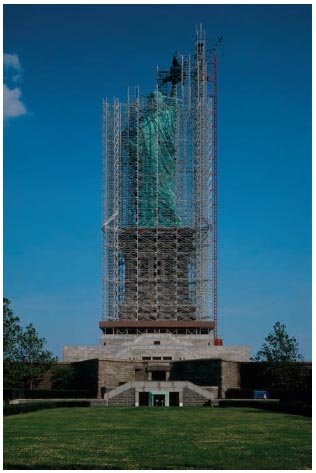
(Right) The Statue of Liberty, surrounded with scaffolding during the restoration work, 1984 (Library of Congress HAER NY,31-NEYO,89--235).
On November 4, 1987, a bronze specimen of this medal was presented to Lido Anthony (Lee) Iacocca, Chairman of
the Statue of Liberty—Ellis Island Foundation. The medal, which bore Iacocca's full
name on the rim, was presented in recognition of his leadership in making possible the restoration of the Statue of
Liberty.
Accompanying the medal was the following proclamation, written by Councillor Margo Russell: WHEREAS Lido Anthony Iacocca, Chairman of the Statue of Liberty — Ellis Island Foundation,
with sensitivity, dedication and prowess, provided the leadership which made possible the restoration of the Statue
of Liberty Enlightening the World,
WHEREAS the world famous symbol of Freedom in New York
Harbor was rededicated on the occasion of its Centennial in July and October 1986,
WHEREAS the celebrations inspired New
York's American Numismatic Society, now in its 129th year, to commission a medallion commemorating the "mighty woman
with the torch,
whose flame is the imprisoned lightning," and from whose "beacon-hand glows world-wide welcome," in the words of Emma
Lazarus in her poem, The New Colossus,
THEREFORE The American
Numismatic Society directed that a single specimen of its Statue of Liberty Medallion in bronze be engraved as a
presentation piece in tribute to and in appreciation of the singular achievement of Lido Anthony Iacocca.
New York, November 4, 1987 ("Society Presents Medal to Lee Iacocca," ANS
Newsletter, Fall 1987, pp. 1–2).
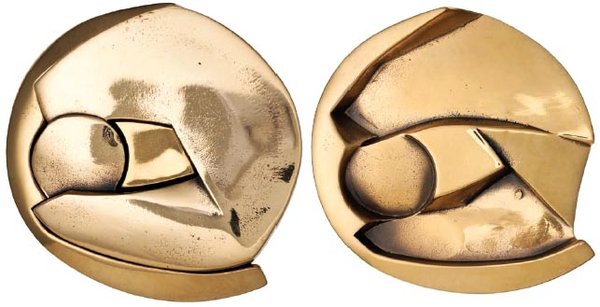
Endowment medal in bronze (ANS 1989.129.2). (Above left) Both halves, top view; (above right) inner surface of lower piece;
Upper part: Two fingers holding a coin
Inner face of upper part: Two fingers holding a coin bearing the Society's seal as a device. On upper finger, THE; on lower finger, AMERICAN NUMISMATIC SOCIETY
Outer face of lower part: Base bears the initials ANS
by Jánós Kalmár; cast by C. A. Brown Foundry irregular, approximately 83 × 82 mm
Mintage
silver: 70
bronze: 48
This medal does not have a traditional obverse and reverse. It is a cast medal composed of two parts, the top piece being the two fingers holding a coin that nests in a base.
This medal was issued as part of the Society's endowment drive of 1986–1989. Silver examples were presented to individuals who had contributed at least $5,000, while bronze examples were available for sale. Several silver examples were later presented to volunteers at the Society. Bronze examples, offered for sale at $100, were housed in white card boxes with the Society's seal imprinted in gold.
The silver specimen in the Society's cabinet, bearing serial number 1 (ANS 1989.129.1), is accompanied by a partly printed presentation card reading:
This ANS Endowment medal, number 1, has been presented to American Numismatic Society in deep appreciation for generous support of the Society's Development Campaign.
The American Numismatic Society April 15, 1989
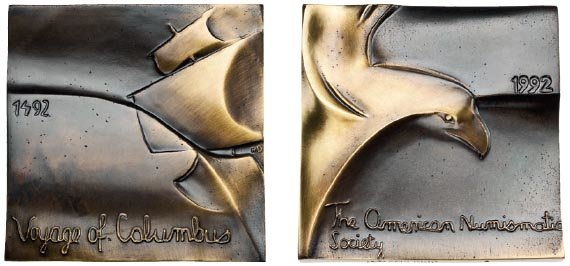
Columbus Quincentenary medal in bronze (ANS 1992.136.2).
Obv.: One of Columbus's ships mirrored in a raised globe. At left, 1492; below, Voyage of Columbus; at right, signed M D
Rev.: An American eagle hovers over the globe, now incuse. At right, 1992; below, The American Numismatic Society
by Magdalena Dobrucka; struck by J. Jenkins Sons, Baltimore
68 × 68 mm
Mintage
gold: 2
silver: 100
bronze: 500
This medal was issued to commemorate 500 years of continuous interaction between the Old World and America.
Among the specimens in the Society's collection is a two-sided lead die trial (ANS 1992.136.3) as well as the artist's original, cast submission (ANS 1992.136.5). Curiously, there are two bronze medals bearing serial number 1, the first having been rejected due an uneven patina (ANS 1992.136.4).
The silver medals were originally offered for sale at $125, the bronze at $60, and a pair of silver and bronze with matching serial numbers for $175. Both silver and bronze medals were sold in white card boxes bearing the Society's seal on the cover. Sales of the medal proved disappointing, possibly due to the general public indifference to the anniversary of Columbus's first voyage.

The two sides, seen here in silver, form a single scene, with the ship moving around the globe toward the land symbolized by the eagle (ANS 1992.136.1).
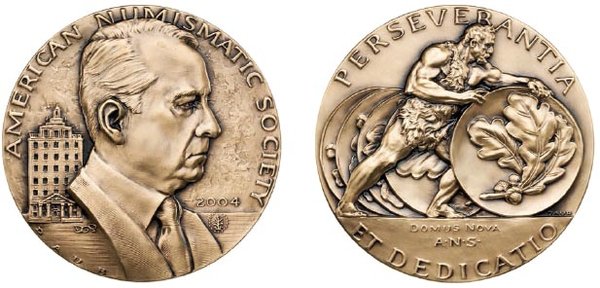
Donald Partrick medal in bronze (ANS 2009.16.1).
Obv.: Bust of Donald Partrick, right; to the left is a view of the ANS building on William Street. Around, AMERICAN NUMISMATIC SOCIETY; to right, 2004 above an image of the center of a Pine Tree shilling; to left of truncation of bust, Partrick's initials D G P; at lower left, signed D A U B
Rev.: Hercules moving monumental-sized coins bearing the Society's seal, symbolizing the enormous task of moving from Audubon Terrace to William Street. Around, PERSEVERANTIA / ET DEDICATIO; in exergue, DOMUS NOVA / A·N·S·; at right, signed DAUB
by Eugene Daub; struck by the Medallic Art Co.
70 mm
Mintage
gold: 1
silver: 50
bronze: 250
The gold medal was presented to Donald Partrick at the annual meeting on October 23, 2004. President from 1999 to 2007, Partrick was largely responsible for the Society's move to 140 William Street (96 Fulton Street) in lower Manhattan, where it was located from 2004 to 2008. Work on the medal was conducted in secret over a period of several months by a committee consisting of Executive Director Ute Wartenberg Kagan, Tony Terranova, Roger Siboni, Stephen Scher, Scott Miller, Donald Scarinci, and Jonathan Kagan. Presentation of the medal, which was an expression of appreciation by President Partrick's friends and colleagues, came as a complete and very welcome surprise for him.
In addition to the unique gold medal presented to President Partrick, bronze and silver sets were presented to major donors, with bronze examples available for sale to members and the public at $175 and $200, respectively. The medal also served to commemorate the Society's move to its new home at Fulton and William Streets, as noted in the Latin phrase "domus nova", or "new home". The pine tree was placed on the obverse as a reference to Partrick's interest in American Colonial coins. The obverse design is unusual in that no name is given to identify the portrait. At the suggestion of Ute Wartenberg Kagan, who noted that the new building was to be known as the Donald Groves Building, and of Donald Scarinci, the initials DGP were included to identify the subject, but in letters so small as to require a magnifying glass to read—a measure the committee thought would please Mr. Partrick.
As an additional sign of their esteem, the committee also arranged to present to Partrick an original, framed sketch of one of the rejected designs. This version depicted Partrick examining a coin through a magnifying glass.
Obv.: Facing bust of Q. David Bowers within an off-center medallion; the Society's seal is below at about 7 o'clock. Around,·Q·DAVID·BOWERS· / ·THE·AMERICAN·NUMISMATIC·SOCIETY·
Rev.: Within an off-center medallion is an owl holding a coin in its claws; in front are oak leaves, a ribbon, and the initial A, while to the left is the date ·/MMX/·. Around right,·▸PARVA·NE·PEREANT◂·
by Alex Shagin
47m
Mintage
uniface silver: unknown
bronze: unknown
two-sided silver: 62
bronze: 133
During the Society's annual gala dinner in January 2006, a uniface silver example of this medal was presented to Q. David Bowers, who also received the Trustees Award that year. The original mintage was very small, and examples were not offered for sale as is the general custom. However, due to the number of requests for examples of this medal, the Society decided to strike a two-sided version which would be made available to the public. It was issued in both silver and bronze.
Publication of this medal was announced in the summer of 2010, and it was available by subscription until October 31, 2010. According to the original announcement, "In 2006 the ANS honored Q. David Bowers for his contributions to numismatic scholarship and for promoting coin collecting to a broad and growing audience" ("Q. David Bowers Medal," American Numismatic Society E-News, June/July 2010).
The coin depicted in the owl's claws on the reverse is based on those of ancient Taras. Minted during the fifth and fourth centuries BC, they depict the personification of Taras riding on a dolphin.
The issue prices for this medal were $165 for silver, $45 for bronze, and $195 for a set of both; ANS members were able to purchase examples at the reduced prices of $150, $35, and $165, respectively.
During the course of the dinner, held January 12, 2006, remarks in honor of Mr. Bowers were presented by Beth Deisher, Editor of Coin World; Mary Counts, President of Whitman Publishing; and the President of American Numismatic Rarities, Christine Karstedt. These remarks were followed by a short film concerning the honoree, after which ANS President Roger Siboni presented Mr. Bowers with the ANS Trustees Award and an example of this medal.
One of the best-known living figures in American numismatics, Dave Bowers has authored more than forty books, as well as numerous articles on a wide variety of topics; his firms have also produced hundreds of auction catalogues. Mr. Bowers has served as president of the American Numismatic Association as well as the Professional Numismatists Guild. He is a recipient of the Farran Zerbe Award and many other honors (Pelletier 2006).
The Society's cabinet includes a 234-millimeter silver painted plaster (ANS 2006.16.4) as well as the hub (ANS 2006.16.3).

Eric P. Newman 100th Birthday medal in silver (ANS 2012.32.6).
Obv.: Bust of Eric Newman, three-quarters left; in the background is a wall map, while in front are scattered coins and notes, as well as an open book. In upper right, Eric P. Newman / 100 years / Scholar / Numismatist / Philanthropist
Rev.: Eric Newman seated at his desk in his library; to the right on a stand can be seen a bust of Benjamin Franklin.
by Amy Kann; struck by Medalcraft Mint
61 × 77 mm, 200 × 257 mm
Mintage
61 × 77 mm, two-sided struck plaquette
silver: 30
bronze: 65
200 × 257 mm, cast plaque
bronze: 6
This medal was issued to honor Eric P. Newman on his 100th birthday on May 25, 2011. Long considered America's foremost numismatic scholar, the Society commissioned a bas-relief portrait of Mr. Newman, a framed galvano of which was presented to him at his birthday celebration in New York by ANS Chairman of the Board Kenneth L. Edlow. In addition to the example presented to Mr. Newman, additional uniface cast bronze plaques measuring 7¾ × 9⅞ inches were made, one for the Society's collection and five others offered to sponsors willing to donate $5,000 to the costs of the project.
In November 2011, the Society offered two-sided Newman medals for sale. The obverse reproduced the large bas-relief plaque, coupled with a reverse design depicting Newman at his desk. Medals were available for subscription until January 13, 2012; silver examples were available at $395 (members) and $498 (non-members), while bronze medals were priced at $45 and $58, respectively.
A brief overview of Eric Newman's many accomplishments, as well as a complete bibliography of his work, was compiled by Robert Hoge and published in the ANS Magazine (Hoge 2011).
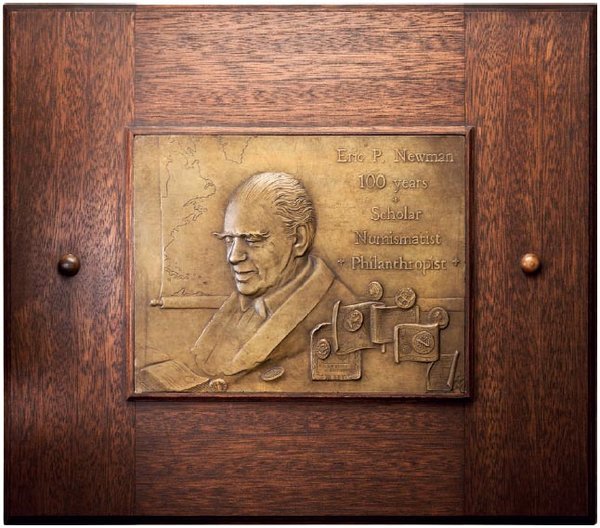
(Above) Framed uniface plaque of the Eric P. Newman medal (ANS 2012.32.3; plaque, 258 × 201 mm, in frame, 463 × 407 mm).
On November 8–9, 1997, the second Coinage of the Americas Conference (COAC) on the theme of the Medal in America was held at the American Numismatic Society. The first day consisted of the presentation of papers on American medals, while the second day consisted of workshops in medal- and die-engraving by Virginia Janssen and Ron Landis; both aspects of engraving were covered in the papers published in the proceedings of the conference. During the course of the workshops, Janssen and Landis produced two medals.
Although not made available for sale to its members by the Society, these two medals were created under its auspices and distributed to the attendees of the workshops.

Two-sided nickel-alloy (?) demonstration medal from the 1997 COAC (ANS 1998.29.1).
Obv.: Head of the Statue of Liberty mirrored by the head of an Aztec goddess. Around,·COINAGE· OF·THE·AMERICAS·CONFERENCE·/ 1997
Rev.: An eagle and a phoenix-like bird, with outstretched wings, juxtaposed. Around,·THE· MEDAL·IN·AMERICA·/ ⁙·A·N·S·⁙
Edge: Incuse inscription GALLERY MINT along with a screw press (twice).
Obverse by Ron Landis, reverse by Virginia Janssen; struck by Gallery Mint
20 mm
Mintage
nickel alloy?: unknown
This is one of two medals struck as a result of a workshop on medal engraving in 1997 at the Coinage of the Americas Conference. According to Virginia Janssen, the obverse was prepared by reducing her original model, while the reverse was engraved by Ron Landis directly into the steel die (Janssen 1999: 284–287).
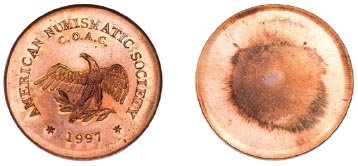
Uniface copper-alloy demonstration medal from the 1997 COAC (ANS 1998.97.1).
Obv.: Eagle on a laurel branch. Around, AMERICAN NUMISMATIC SOCIETY / C.O.A.C. / ⁕ 1997 ⁕
Uniface
by Ron Landis
42 mm
Mintage
copper?: unknown
The die for this medal was created at the Coinage of the Americas Conference to demonstrate how quick die-sinking can be. Ron Landis took about 15 minutes at the conference to create the simple eagle design and lettering from punches. He spent another half-hour finishing the die afterwards, so that the entire process took less than an hour (Landis 1999: 292).
While researching this book, it quickly became apparent that some medals have mistakenly been either attributed to the ANS or omitted from the canon. Over the years, there have been at least four attempts to list medals issued by the American Numismatic Society; none has been completely without error. I am sure that in years to come, another researcher will remark that the last five attempts have not been without error. In all fairness, I should mention that I would never have even attempted this work were it not possible, like Newton, to stand on the shoulders of giants.
Of the various medals that have been erroneously thought of as being issued by the Society, that for the Actors Fund has, in recent years, been classified by many as an ANS issue due to the small ANS seal that appears on the obverse of some examples. In addition, others that have been included in the list of official medals are debatable, such as the Catskill Aqueduct medal, which has already been addressed.
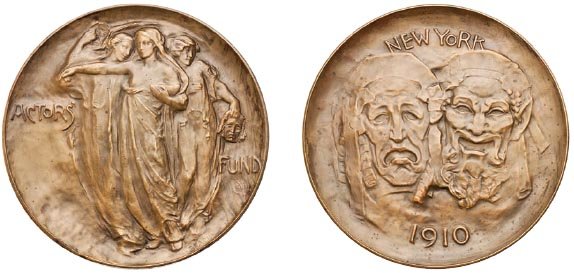
Actors' Fund medal in bronze (ANS 1940.100.2903).
Obv.: Charity advancing, with Comedy and Tragedy on either side, her arms outstretched in an appeal for aid. To left and right, ACTORS' FUND
Rev.: Masks of Tragedy and Comedy. Above, NEW YORK; below, 1910
by Chester Beach; struck by Medallic Art Co.
69 mm
Mintage
gold: unknown
silver: unknown
bronze: unknown
According to the New York Herald (March 13, 1910) a gold example of this medal was struck March 12, 1910 ("Gold Medal Is Struck for Actors' Fund Fair," New York Herald , March 13, 1910). It was to be presented by twelve leading actresses to President William Howard Taft when he opened the Actors' Fund Fair on May 9. In addition to the gold medal, 1,000 silver medals were to be struck for guests and 5,000 bronze specimens for the public. A brief notice in The Numismatist for April 1910 noted that the medal was commissioned by Archer Huntington and that 100 silver and 1,000 bronze examples were to be struck (Lagerberg 1910: 113). However, based on the frequency with which this medal appears, it would seem that even the more modest mintage figures were never realized.
There has been much speculation about this medal as a possible issue by the American Numismatic Society due to the fact that a number of examples have appeared with what appears to be a small depiction of the Society's seal. A photograph of the original plaster model can be found in the 1911 edition of the Catalogue of the International Exhibition of Contemporary Medals (Baldwin 1911). The ANS seal is clearly absent in that photo. It therefore appears that originally, at least, there was no intention of placing the seal on the medal. Whether its faint presence was an error by the die maker or was based on the hope that the ANS would give its permission to include its seal, as it had for other organizations, remains speculative. However, as no documentation has yet appeared to establish a connection with the Society, it would appear that this cannot be classified among those medals issued by or under the auspices of the ANS.
On May 3, 1902, ANS Vice-President Henry Russell Drowne gave an address at the Fifth Annual Dinner of the National Sculpture Society and the National Society of Mural Painters at the National Arts Club in which he discussed medals issued by the Society. The following is a transcription of his notes, which reside in the ANS Archives.
I fear that I shall be but a feeble representative of the Pres. of our Society, Mr. Andrew C. Zabriskie, — for I am here this evening as his substitute, — and so trust that you will pardon my lack of preparation, and excuse the reading of a few notes which have been hastily made.
The Am. Numismatic & Archaeological Society of New York is the oldest Society of the kind in America. — It was founded in 1857, and, 'though never a large Society, has made steady progress during all the succeeding years — Its main object is to promote interest in the science of numismatics, and to assist this — by gathering together books relating to the subject, as also in the formation of a collection of coins and medals. — Patient work and careful attention has finally awarded our endeavors, — for we have the largest library of numismatic works in this country, and our cabinets for coins and medals now contain upwards of 20,000 specimens.
When you realize that the Society has never had any sum of money to expend in accomplishing these objects, — and has always supported itself, and printed its annual proceedings by dues from members, we feel that we should be proud of our record.
Naturally we work in a limited field, numismatists are generally termed cranks — and I am frank to say are really few and far between. What we have gathered has been due in the main to the kindly interest and beneficent donations of a few enthusiastic members, who have always endeavored to do what little they could to promote and further the interests of our Society. On various occasions we have also caused medals to be struck, of which there now exists quite an interesting series, that bear either the name or seal of the Society
Among those worth [sic] of mention are the following:-
For a long time, so great was the difficulty in securing artists who could do good work in this country, that several of these medals were ordered abroad and were designed and cut by Mme. Lea Ahlborn, the talented medallist of the Swedish Mint.
Much time is also devoted by the Society in answering inquiries regarding coins and medals which come from all over the United States, and to the dissemination of general information on these subjects.
It is not my wish at this time to give you a lot of details, or a history of the Society. Our main object at the present time is to raise the standard of coin and medal designing and die cutting in this country. — This to me is a subject that has never received enough careful attention on this side of the water, the work done here has been of rather poor workmanship, and has shown but little originality of design. — Looking the whole field over we find but few specimens that are of higher class than the political or commemorative medals that are peddled on the streets at the time of such celebrations. — Then when we turn to the coinage of the United States Mint we notice a retrograde movement from the very beginning, and today we have a design on our half-dollars, quarters and dimes — that I am frank to say could be taken for either a male or female head. Only one of our present coins really shows merit, and that is our copper cent which appeared in 1859, and has been issued without change since that date. The rest of the current issue serve to represent the value stamped thereon, and as far as this is concerned answer the purpose. I regret, however, that very little can be said as to their showing any artistic design or work.
The first issues of our coins and medals — following the War of the Revolution — were of bold executions and classic style, being in the main of French origin, and either the work of French artists, or in part copies of their designs, and with a few rare exceptions the science of die cutting has since shown more deterioration than advancement.
Today we have one or two among us who are making great progress, and some really artistic medals are the first fruits of the new era — as an example let me call attention to the recently issued medal commemorating the visit of Prince Henry of Prussia, designed by Mr. Victor D. Brenner, a member of our Society.
It is to be hoped that the new standard of excellence may ultimately reach the United States mint, and that we may yet have coins that we will be proud of, and that will compare favorably with those struck abroad. — As a Society — we are "Contributing our mite" to educate the people as to this particular class of art, — so that there will be a better understanding as to what is requisite to produce effective and artistic work, — and at the present time we are supporting in this city a School for Coin & Medal Designing & Die Cutting, Cö-operating with the National Academy of Design, — feeling that by cultivating the root we may finally raise a tree or two that will bear fruit. It is going to be a slow process, but we hope the ultimate results will show that our labor is not in vain.
In concluding, permit me to state, that our Society is located in the Dime Savings Bank B'ld'g, Cor. 32nd St. & B'dway. On Thursday afternoons & evenings our Rooms are always open to the public, and it affords us great pleasure to extend a cordial invitation to all interested in coins and medals — to come and see — what we have — and what we are doing.—
| 1918 | Edward T. Newell |
| 1919 | Agnes Baldwin Brett |
| 1920 | Howland Wood |
| 1921 | Ioannis N. Svoronos |
| 1922 | Ernest Babelon |
| 1923 | George F. Hill |
| 1924 | Albert R. Frey |
| 1925 | George MacDonald |
| 1926 | José Toribio Medina |
| 1927 | Robert James Eidlitz |
| 1928 | Eduard von Zambaur |
| 1929 | Kurt Regling |
| 1930 | Bauman L. Belden |
| 1931 | Harrold E. Gillingham |
| 1932 | Adolphe Dieudonnné |
| 1933 | Wilhelm Kubitschek |
| 1934 | Adrien Blanchet |
| 1935 | E. Stanley G. Robinson |
| 1936 | John Allen |
| 1937 | Sydney P. Noe |
| 1938 | Harold Mattingly |
| 1940 | Arthur J. Evans |
| 1941 | Albert Gallatin |
| 1943 | Alfred R. Bellinger |
| 1944 | J. Grafton Milne |
| 1945 | A. F. Pradeau |
| 1946 | Max Bernhart |
| 1947 | Richard B. Whitehead |
| 1948 | J. W. E. Pearce |
| 1949 | George C. Miles |
| 1950 | C. H. V. Sutherland |
| 1952 | Henri Seyrig |
| 1953 | Walter Hävernick |
| 1954 | Charles T. Seltman |
| 1955 | John Walker |
| 1956 | Jocelyn M. C. Toynbee |
| 1957 | Arthur Suhle |
| 1958 | Robert I. Nesmith |
| 1959 | Oscar Ulrich-Bansa |
| 1960 | Humberto F. Burzio |
| 1961 | Margaret Thompson |
| 1962 | Philip Grierson |
| 1963 | Jean Mazard |
| 1964 | Michael Grant |
| 1965 | Andreas Alföldi |
| 1966 | George Galster |
| 1967 | Willy Schwabacher |
| 1968 | Georges Le Rider |
| 1969 | Emanuela Nohejlová-Prátová |
| 1970 | Anne S. Robertson |
| 1971 | Paul Balog |
| 1972 | H. Enno van Gelder |
| 1973 | Christopher E. Blunt |
| 1974 | Jean Lafaurie |
| 1975 | Pierre Bastien |
| 1976 | Kenneth Jenkins |
| 1977 | R. A. G. Carson |
| 1978 | Eric P. Newman |
| 1979 | Felipe Mateu y Llopis |
| 1980 | Colin M. Kraay |
| 1981 | Otto Mørkholm |
| 1982 | Michael Dolley |
| 1983 | Herbert A. Cahn |
| 1984 | Peter Berghaus |
| 1985 | Leo Mildenberg |
| 1986 | Paul Naster |
| 1987 | Parmeshwari Lal Gupta |
| 1988 | Brita Malmer |
| 1989 | Patrick Bruun |
| 1991 | D. M. Metcalf |
| 1992 | Peter Robert Franke |
| 1993 | Leandre Villaronga |
| 1994 | J. P. C. Kent |
| 1995 | Cécile Morrisson |
| 1996 | Theodore V. Buttrey |
| 1997 | Ulla Westermark |
| 1998 | Stanisław Suchodolski |
| 1999 | John S. Davenport |
| 2000 | Maria R. Alföldi |
| 2001 | Ya'akov Meshorer |
| 2002 | Michael Crawford |
| 2003 | Stephen Album |
| 2004 | Michel Amandry |
| 2005 | Philip Mossman |
| 2006 | François de Callataÿ |
| 2007 | Andrew Burnett |
| 2008 | Joseph E. Cribb |
| 2009 | Bernd Kluge |
| 2010 | Christof F. Boehringer |
| 2011 | Richard G. Doty |
| 2012 | Ioannis Touratsoglou |
| 2013 | Olivier Picard |
| 2014 | John W. Adams |
| 1919 | James Earle Fraser |
| 1920 | A. A. Weinman |
| 1921 | John Flanagan |
| 1922 | Victor D. Brenner |
| 1923 | Hermon A. MacNeil |
| 1925 | Paul Manship |
| 1926 | Laura G. Fraser |
| 1927 | Anthony de Francisci |
| 1931 | Edward W. Sawyer |
| 1937 | Lee Lawrie |
| 1946 | Chester Beach |
| 1948 | Henry Kreis |
| 1949 | C. P. Jennewein |
| 1950 | Gertrude K. Lathrop |
| 1951 | Albert Laessle |
| 1952 | Bruce Moore |
| 1953 | Walker Hancock |
| 1954 | Sidney Waugh |
| 1955 | Theodore Spicer-Simson |
| 1956 | Thomas G. Lo Medico |
| 1959 | Abram Belskie |
| 1960 | Bruno Mankowski |
| 1964 | Robert A. Weinman |
| 1966 | Albino Manca |
| 1967 | Donald DeLue |
| 1968 | Michael Lantz |
| 1969 | Stanley F. Martineau |
| 1970 | Joseph Kiselewski |
| 1975 | Granville W. Carter |
| 1979 | Karen Worth |
| 1980 | Agop Agopoff |
| 1983 | Guido Veroi |
| 1984 | Marcel Jovine |
| 1985 | Edward R. Grove |
| 1986 | Kauko Räsänen |
| 1987 | John Cook |
| 1988 | Jiří Harcuba |
| 1990 | Keiichi Uryu |
| 1991 | Eugene Daub |
| 1992 | Mico Kaufman |
| 1993 | Ewa Olszewska-Borys |
| 1994 | Marianne Letterie |
| 1995 | Alex Shagin |
| 1996 | Nicola Moss |
| 1997 | Leonda Finke |
| 1998 | Helder Batista |
| 1999 | Jeanne Stevens-Sollman |
| 2000 | Bernd Göbel |
| 2001 | Gustaaf T. M. Hellegers |
| 2002 | Toivo Jaatinen |
| 2003 | Dora de Pédery-Hunt |
| 2005 | Theo van de Vathorst |
| 2009 | Ron Dutton |
| 2011 | João Duarte |
| 2014 | Paweł Łęski |

Some of the large plaques of ANS medals are currently on display in the room where the Society holds lectures and meetings. Here, from left to right, are the John Paul Jones medal, the Amerigo Vespucci medal, and the Louis West medal (photograph by Alan Roche).